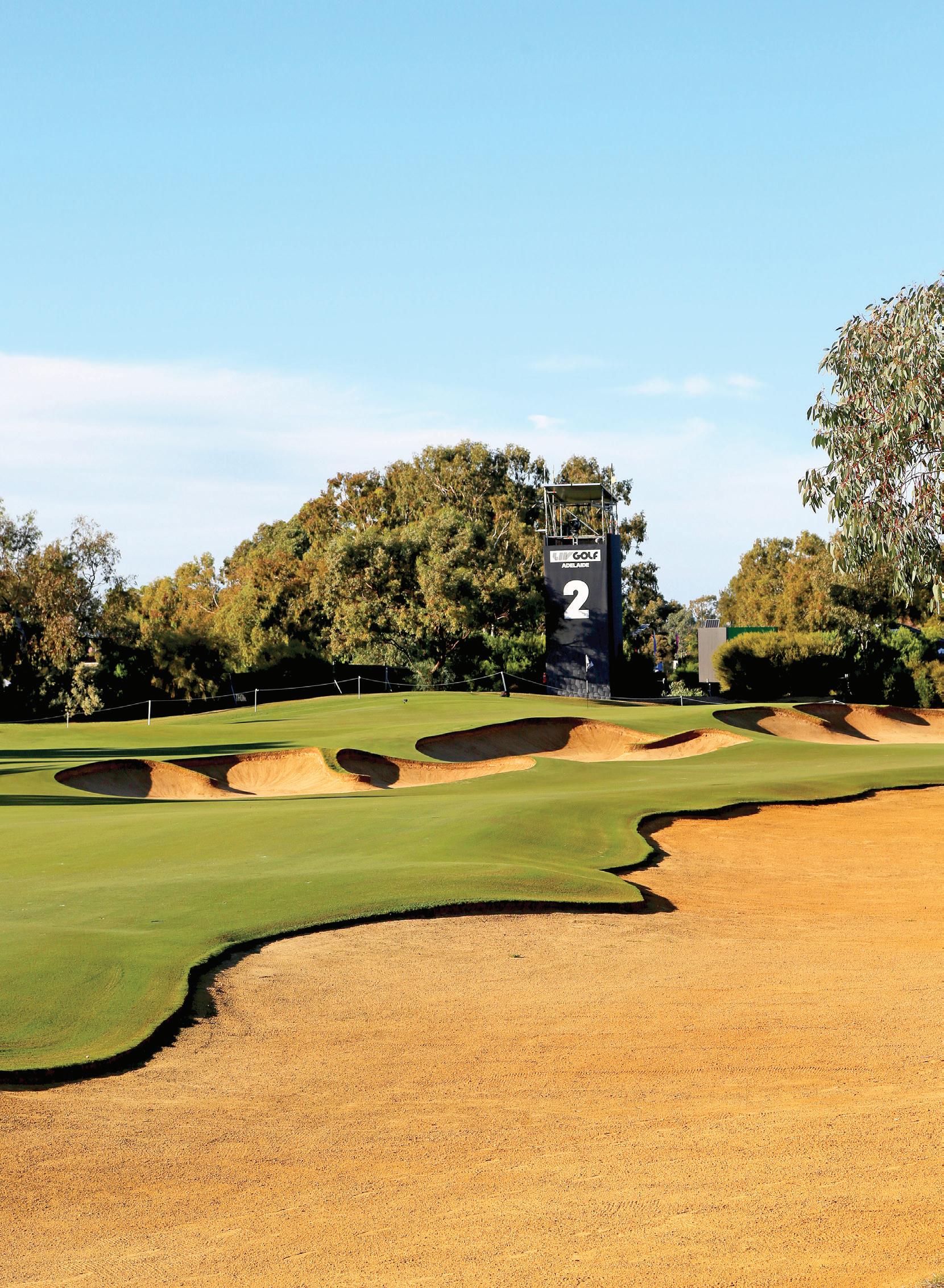
Two track approach
Two track approach
Caulfield’s ‘Heath’ track off and racing
Caulfield’s ‘Heath’ track off and racing
Emerging talent
2023-2024 Future Turf Managers’ Initiative review
2023-2024 Future Turf Managers’ Initiative review Emerging talent
Heaven scent
Heaven scent
NZ’s ‘Number One’ smelling turf manager
NZ’s ‘Number One’ smelling turf manager
Ripper week at The Grange LIV Golf Adelaide 2.0 sets a new benchmark Ripper week at The Grange LIV Golf Adelaide 2.0 sets a new benchmark
Shaping futures Leadership profile – John Shannon Shaping futures Leadership profile – John Shannon www.astma.com.au CELEBRATING THE EFFORTS OF AUSTRALIA’S SPORTS TURF MANAGEMENT PROFESSIONALS ISSN 1442-2697 VOLUME 26.2 MAR-APR 2024



sincere ly Jake PROVEN. POWERFUL. PERFECTED. JOIN THE CHARGE WITH THE ECLIPSE 360 EL.ITE
Published by the Australian Sports Turf Managers Association (ASTMA)
JOURNAL
Editorial
Brett Robinson
Office: (03) 9548 8600
Mobile: 0434 144 779
Email: brett@astma.com.au
Advertising
Pam Irvine
Office: (03) 9548 8600
Mobile: 0402 069 489
Email: pam@astma.com.au
Art Direction & Design
Jo Corne
Printed By Southern Impact Pty Ltd
Suite 1, Monash Corporate Centre
PARTNERS
PARTNERS
PREMIUM PARTNERS
PREMIUM PARTNERS
PREMIUM PARTNERS
ASTMA PREMIUM PARTNERS
Association is indebted to the support of the following premium partner companies
PREMIUM PARTNERS
The

752 Blackburn Road, Clayton, VIC 3168
P: (03) 9548 8600 E: admin@astma.com.au
W: www.astma.com.au
ABN 96 053 205 888
ASTMA Board
Ben Tilley (Headland GC, president), David Thomson (Bermagui CC), Peter Lonergan (Coolangatta & Tweed Heads GC), Damian Hough (Adelaide Oval), Troy Jordan (MOPT) and Mark Findlay (Werribee Park GC)
Chief Executive Officer
Mark Unwin
Office: (03) 9548 8600
Mobile: 0438 320 919
E: mark@astma.com.au
Membership
Allison Jenkins
E: admin@astma.com.au
Finance Manager
Frank Joseph
E: frank@astma.com.au
Events and Education
Simone Staples
E: simone@astma.com.au
Pam Irvine
E: pam@astma.com.au
RTO/Training Manager
Albert Sherry
E: albert@astma.com.au
M: 0437 064 726
AGCSATech
Bruce Macphee (Senior Agronomist)
E: bruce@astma.com.au
Tim Fankhauser (Agronomist)
E: tim@astma.com.au


www.facebook.com/TheASTMA
www.linkedin.com

www.instagram.com/the_astma

@TheASTMA
The Australian Sports Turf Managers Association is indebted to the support of the following premium partner companies
Sports Turf Managers Association is indebted to the support of the following
companies
The Australian Sports Turf Managers Association is indebted to the support of the following premium partner companies


PARTNERS
PREMIUM PARTNERS




























the

























MARCH-APRIL 2024 1
Copyright © 2024 The ASTMA believes that material sourced and produced for Australian Turfgrass Management is accurate, but gives no warranty in relation thereto, and disclaims liability for all claims against the ASTMA, its subsidiary companies, its employees, agents or any other person which may arise from any person acting on the materials contained within. No portion, in whole or part, may be reproduced without the written permission of the ASTMA
The Australian Sports Turf Managers Association is indebted to the support of the following premium partner companies PLATINUM GOLD SILVER BRONZE The Australian Sports Turf Managers Association encourages all members to support these companies who support your association
Australian Sports Turf Managers Association is indebted to the support of the following premium partner companies PLATINUM GOLD SILVER BRONZE The Australian Sports Turf Managers Association encourages all members to support these companies who support your association
PREMIUM PARTNERS
PREMIUM
The
Australian Sports Turf
indebted
following premium partner companies PLATINUM GOLD SILVER BRONZE The Australian Sports Turf Managers Association encourages all members to support these companies who support your association PREMIUM
Australian
premium
PLATINUM GOLD SILVER BRONZE The Australian Sports Turf Managers Association encourages all members these companies who support your association
Australian Sports
PLATINUM GOLD SILVER BRONZE The Australian Sports Turf Managers Association encourages all members to support these companies who support your association
The
Managers Association is
to the support of the
PARTNERS The
Sports Turf Managers Association is indebted support of the following
partner companies
PREMIUM
The
Turf Managers
PLATINUM GOLD SILVER BRONZE The Australian Sports Turf Managers Association encourages all members to support these companies who support your association PREMIUM
PARTNERS
PLATINUM GOLD SILVER BRONZE The Australian Sports Turf Managers Association encourages all members to support these companies who support your association
PLATINUM GOLD SILVER BRONZE The Australian Sports Turf Managers Association encourages all members to support these companies who support your association
Australian Sports Turf Managers Association is indebted
support
the following premium partner
PLATINUM GOLD SILVER BRONZE The Australian Sports Turf Managers Association encourages all members to support these companies who support your association PLATINUM GOLD SILVER BRONZE The Australian Sports Turf Managers Association encourages all members to support these companies who support your association PREMIUM
Australian
Turf
the following premium partner
PLATINUM GOLD SILVER BRONZE The Australian Sports Turf Managers Association encourages all members to support these companies who support your association
Australian
premium partner
PREMIUM
The
to the
of
companies
PARTNERS The
Sports
Managers Association is indebted to the support of
companies
Australian
PLATINUM GOLD SILVER BRONZE The Australian Sports Turf Managers Association encourages all members to support these companies who support your association
The
Sports Turf Managers Association is indebted to
support of the following premium partner companies
Australian Sports
premium
PLATINUM GOLD SILVER BRONZE The Australian Sports Turf Managers Association encourages all members to support these companies who support your association
The
Turf Managers Association is indebted to the support of the following
partner companies

COVER STORY
RIPPER WEEK AT THE GRANGE 8
It was always going to bigger, louder and better and for the second year in a row LIV Golf Adelaide could not have scripted things any better. While there was no hole-in-one on the now-famous ‘Watering Hole’, it was a dramatic teams playoff victory by Cam Smith’s Ripper GC that ensured the latest LIV instalment at The Grange Golf Club will again go down in Australian golf folklore. In this edition ATM editor Brett Robinson looks back on another memorable week which saw more than 94,000 fans flock to The Grange and goes behind the scenes with course superintendent Rowan Daymond to see how they pulled it together.
Cover: The Grange Golf Club’s 9 East which played as the 2nd hole during the LIV Golf Adelaide tournament. Photo: Brett Robinson.
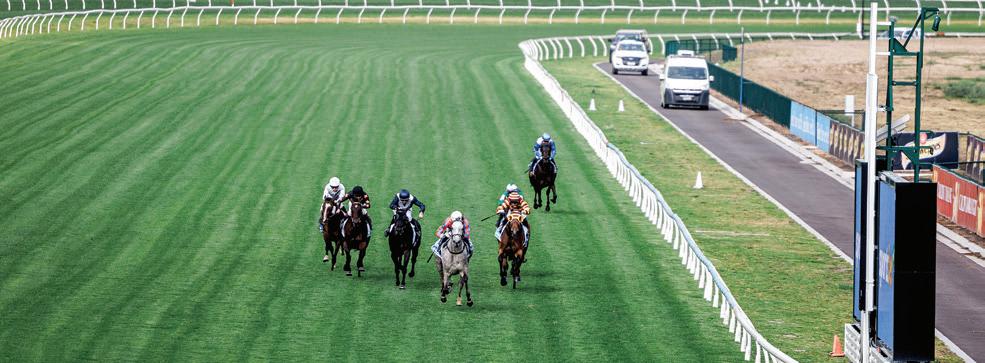
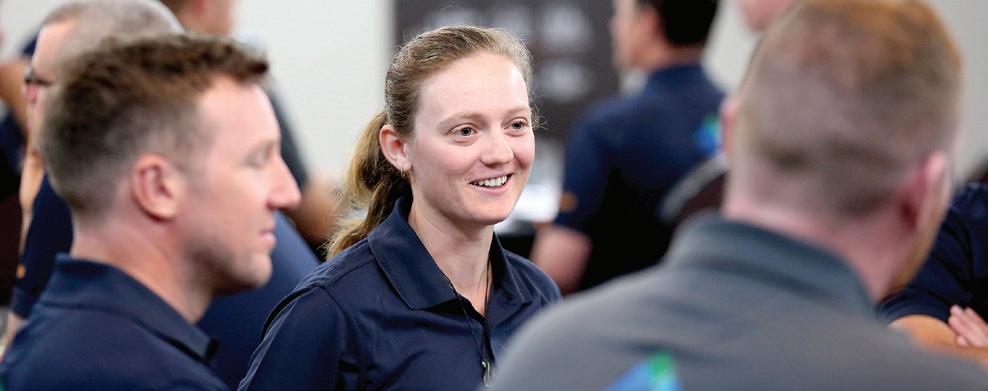

2 AUSTRALIAN TURFGRASS MANAGEMENT 26.2
FEATURES Inside the LIV ropes 16 Tracks apart 20 Caulfield Heath right on track 26 A wealth of knowledge – FTMI 32 Avondale’s green tick 50 ALSO IN THIS EDITION… Foreword Thinking – Mark Unwin 4 Best on ground – Socials 6 Around the Trade 60 Association Reports 62 Book Review 68 Up the last... 70 26 8
PHOTO: CHRIS TROTMAN/LIV GOLF
32 70
PHOTO: MELBOURNE RACING CLUB
CONTENTS
PHOTO: JASON OXENHAM
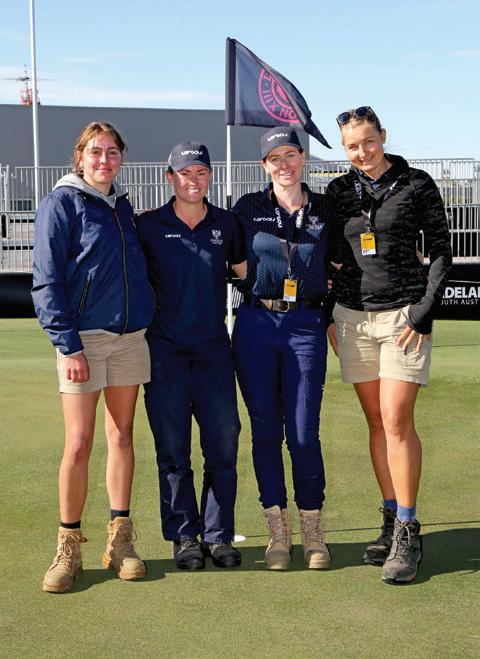
COLUMNS
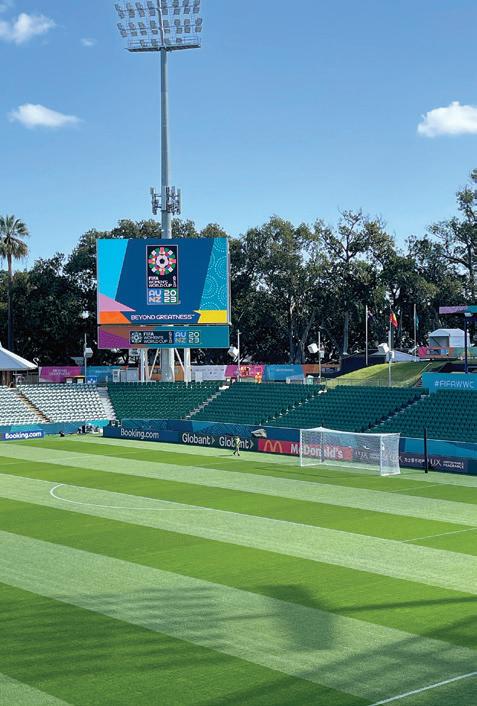
Contributors to Australian Turfgrass Management Journal Volume 26.2 (March-April 2024): 2023-2024 FTMI cohort; Shane Baker (GCSAWA); Nathan Bennett (TMSA); Sam Bennetts (Melbourne Racing Club); Rowan Daymond (The Grange GC); John Forrest (Forrest and Forrest Horticultural Consultancy Services); Ben Gibson (The Toolbox Team); The Grange GC LIV Golf tournament crew; Mark Hauff (GCSAQ); Leon Hennessy (NSWGCSA); LIV Golf Media; Bruce Macphee (AGCSATech); Paul McMillan; Ashley Mead (OCM Golf); Mary Napier (VGCSA); John Neylan (Sporteng); Liam O’Keeffe (Flemington/Victoria Racing Club); Jason Oxenham; Alec Pengilly (HBF Park); Racing Photos; John Shannon (Melbourne Grammar School); Albert Sherry (ASTMA); Simon Snedden (ACTSTMA); Kate Torgersen (Environmental Golf Solutions); Mark Unwin (ASTMA); Michael Wood (Royal Randwick/Australian Turf Club).
Melting pot
You have to love tournaments. They are the pinnacle of golf course management, where a crew of professional sports turf managers, ranging in years of experience and from all manner of facilities, come together across a long and intensive week to meticulously present a course at its optimum for the game’s best. As the cliché goes, there’s always a healthy blend of youthful exuberance and experience, from the skilled stalwarts with multiple tournament notches on the belt through to the apprentices nervously taking their first steps in the industry and praying they don’t make a mistake while someone is watching.
When you bring together a team like the one that recently prepared The Grange Golf Club for the return of LIV Golf Adelaide, it is an absolute melting pot of personalities and characters. Across the week, as they diligently go about their tasks, experiences are shared, life stories are told, friendships are struck and lots of laughs are had. You could fill a magazine cover to cover with the snippets you pick up on during the week, whether it’s where people are from, what they do outside of work and the journeys and experiences they have had.
At this year’s LIV tournament you had a crew of 60, comprising 30 Grange staff and 30 volunteers. The volunteers came from all parts of the country. Most flew over, some drove. Ethan Woodall, an apprentice from Leongatha Golf Club in Victoria’s Gippsland region, made a 1700 kilometre round trip by car in order to experience his first major tournament. Callum Hitching trumped that, making the epic 4292km trek all the way from Karratha Country Club in the far northwest of Western Australia (no, he didn’t drive). Cory Salmond, who was the first of the volunteers to arrive a week ahead of the others, is not only an apprentice at Indooroopilly Golf Club in Brisbane but in his spare time is an extremely talented wildlife artist!
You had four female sports turf managers who were there for the week as part of the ASTMA’s Women in Turf Strategy work placement program. Two of them – Chloe Cooper and Jorjia Hogg – are just embarking on their journeys in the industry and were experiencing their first major event – what an introduction to tournament golf! They spent the week alongside Martyna Synak whose career journey from her native Poland to now be working at The Lakes Golf Club in Sydney is a fascinating story in its own right.
On The Grange crew you had Cameron Fleeton who only joined the club in the months before the tournament, yet was one of four to led the greens mowing team for the week. For the past three years Fleeton was on the list of the GWS Giants and made his AFL debut against Collingwood in Round 9 last year. Although playing just two Premiership games, he had a strong season at VFL level and was selected in the 2023 VFL Team of the Year. At the end of last season he was delisted and picked up by Woodville-West Torrens in the SANFL, joining The Grange crew as a groundsman where he has slotted in seamlessly.
Then there is Tom D’Arcy. Eighteen-odd months ago he was working for Toyota as a technical advisor when he spied an ad for the vacant role of head machinery technician at The Grange on Seek. Keen on his golf and wanting to find out more, he picked up the phone and enquired. Now he has helped to prepare the club’s impressive equipment fleet for two of the biggest tournaments in Australian golf history! He’s also quite adept at playing the trumpet and during LIV week he played the Last Post as the ground staff held their own Dawn Service ceremony on ANZAC Day.
And, finally, you have Grange superintendent ‘Rowan Reynolds’. Sorry, I mean ‘Rowan Daymond’ of course. Daymond, who incidentally has an identical twin brother, admits he’s been called quite a few names over the years, but after this year’s tournament he has another to add to the list. Interviewed live on Channel 7’s Sunrise program ahead of LIV’s first round, The Grange’s custodian was introduced glowingly by the presenters as “Rowan Reynolds”. You can imagine the reaction of the crew watching in the lunchroom!
In this edition we look back on what was another incredible week at The Grange as LIV Golf Adelaide again cemented its place as one of international golf’s most unique tournaments. There is no doubt that happy staff makes for a better golf course and you could certainly tell that among the crew at The Grange who excelled across the week and presented the course in first-class condition. Enjoy the read…
 Brett Robinson, Editor
Brett Robinson, Editor
MARCH-APRIL 2024 3
JOHN NEYLAN 38 JOHN FORREST 42 KATE TORGERSEN 46 BEN GIBSON 54
MARCH-APRIL 2024 3
42 16

FOREWORD
THINKING WITH MARK UNWIN, CEO
Education focus as FTMI concludes and conference looms
It has been a busy few months for the Australian Sports Turf Managers Association (ASTMA) team. During this time we saw the completion of the 20232024 iteration of the Future Turf Managers’ Initiative (FTMI), finalised the program for the upcoming Australian Sports Turf Management Conference in Brisbane and requirements for the two-day trade exhibition and delivered the fifth ASTMA Women in Turf Strategy work placement opportunity at LIV Golf Adelaide. On top of all that the ASTMA Board met for an end-of-financial-year planning session.
Now in its eighth year, the Jacobsensponsored FTMI program continues to exceed expectations. With a contrast of experience, fantastic engagement and a great education component, FTMI goes from strength to strength in developing the leadership and professional skills of more than 20 of the sports turf industry’s future leaders from facilities throughout Australia and New Zealand.
Following the three-day in-person sessions in Melbourne in mid-March, feedback highlighted that the level of interaction, engagement and learning delivered by the FTMI continues to be an industry-leading opportunity for those fortunate to be chosen. This year also marked a special milestone, as we have now seen more than 60 per cent of all FTMI attendees promoted after being a part of the program. This is an outstanding result and a testament to both the leadership program and calibre of participants who have graduated since the first FTMI was delivered back in 2016.
I would like to thank Jacobsen for their continued partnership in delivering this program, the mentors who play such a huge role in driving its success, this year’s panel of expert presenters and the successful participants who put themselves out of their comfort zone to hopefully gain some new and usable skills. Later in this edition you can read some of their feedback on what they
took away from the program and areas they have committed to working on as part of their ongoing professional development.
For those interested in the opportunity to attend and further their career, applications for the 2024-2025 FTMI will open in July/August, once the conference has been held. I strongly encourage any sports turf managers interested to keep updated with the program via the ASTMA website (see under the ‘Education’ tab at www.astma.com.au.)
With the Brisbane conference now only weeks away (17-20 June), preparations have seen the team ramping up activities in conjunction with co-hosts Golf Management Australia (GMA). The event is shaping up to be exceptional and as this edition was going to print combined delegate attendance was tracking above forecast.
Joining with the GMA allows us to generate additional content, which has seen the program adjust slightly from its normal approach. This includes adding in a number of combined sessions to the Golf stream where course superintendents and general managers will sit in on joint presentations. These will cover topics relating to workforce engagement, staff retention and communication, in addition to hearing from leaders in the industry covering governance and management operations.
Evolving agronomic topics remain a focus this year and we have secured a number
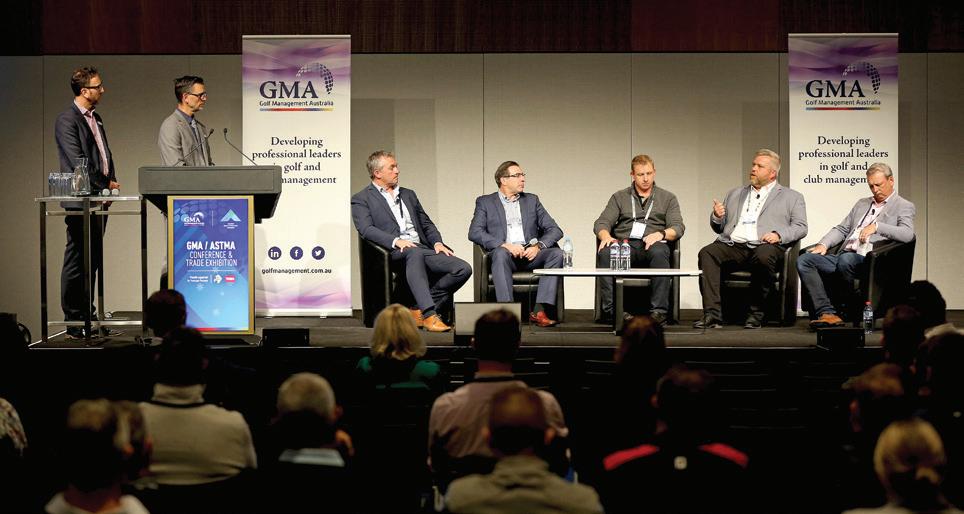
of international academic researchers and practicing turf managers from both golf course and sportsfield backgrounds, among them Dr Jay McCurdy (Mississippi State University, USA), Erwan LeCocq (WINSTONgolf, Germany) and Steve Wilson (Europe). Joining them on the program in Brisbane will be local academics from the University of Queensland and both Queensland and New South Wales Departments of Environment discussing ERI control, pest and disease management.
Workforce attraction and retention remains a crucial topic for the industry, underscored by the recent research the ASTMA has undertaken with La Trobe University which will be presented in Brisbane. Further to that, the ASTMA is currently working with the state associations to develop a series of career awareness videos highlighting the opportunities and benefits that the industry offers. These will further support the work already undertaken in delivering our Women in Turf Strategy and First Green programs, with a desired outcome of further developing interest in turf management careers.
Over the coming months, these videos, coupled with existing and new case studies and range of other tools and information, will be developed into an industry-wide careers portal for sports turf management which can be used by members, facilities, associations and schools to assist in attracting talent into the industry.
On the topic of attracting talent, a host of new apprentices have kicked off their career journeys over the past couple of months. The ASTMA’s training division, headed by Albert Sherry and recently appointed South Australian state manager Alex Wood, continues to deliver both the Certificate III in Sports Turf Management (SA only) and Diploma of Sports Turf Management courses, with numbers continuing to grow. We have had more than a dozen new apprentices in South Australia undertaking their Certificate III through the ASTMA. I’m always encouraged to see the development of these new starters and wish them all the very best as they take their first steps into the industry.
For those keen on further developing their formal education through short-course study or the Diploma, the ASTMA will be making a series of announcements in relation to further support for the industry on the education front at the Brisbane conference. As they say, watch this space!
With this year’s conference the second combined venture with Golf Management Australia after a successful 2022 event (pictured), it allows for the inclusion of sessions where course superintendents and club general managers can sit in on joint presentations relating to shared topics of interest

4 AUSTRALIAN TURFGRASS MANAGEMENT 26.2

PRIMO MAXX® II Turf growth regulator is a completely new formulation designed to meet the ever increasing regulatory hurdles and secure the long term future of this key management tool for turf managers. Users should continue to apply the rates they have always used and can be confident of achieving the same great results while applying less active ingredient. To find out more about PRIMO MAXX® II visit

Always refer to product label. Syngenta Australia Pty Ltd, Level 1, 2 Lyonpark Road, Macquarie Park NSW 2113. ABN 33 002 933 717. ®Registered trademark of a Syngenta Group Company. ™Trademark of a Syngenta Group Company. All products written in uppercase are registered trademarks of a Syngenta Group Company. ©Syngenta 2023. AD 23-391.
syngentaturf.com.au MAKING GOOD TURF GREAT FROM TEE TO GREEN NEW

Best
on ground
ATM showcases some of the best social media posts and pictures from around the sports turf industry in recent months.
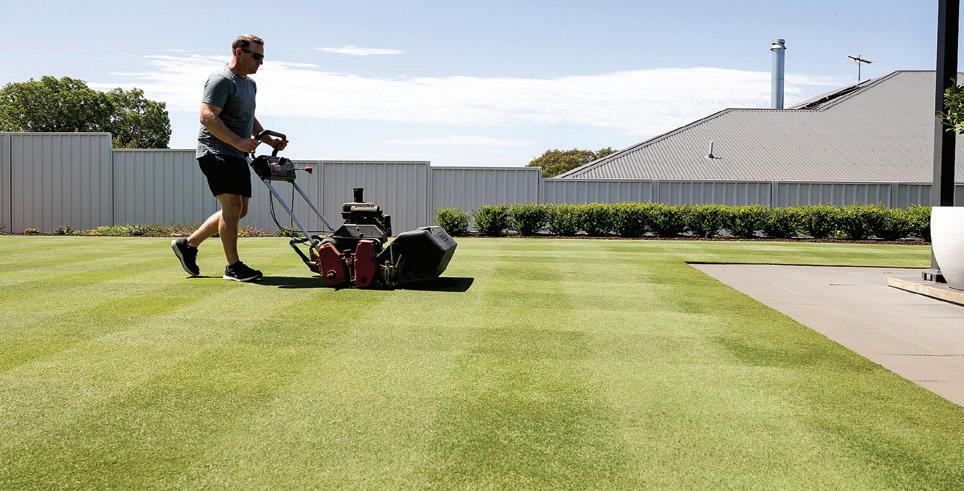

SIMON WORK
“So this just happened!! Big thanks to the wife and family for allowing me the time to maintain our pristine lawn and backyard. To be voted the best lawn in Adelaide is something I am very proud of.” (Simon Work, course superintendent of North Adelaide Golf Club, literally took his work home with him after recently winning Adelaide’s Best Lawn Competition run by Newtons Building & Landscape Supplies. Work is pictured above and top with wife Casey and kids Elly and Tyson receiving the winner’s prize of $7500 from celebrity landscape gardener Jason Hodges.
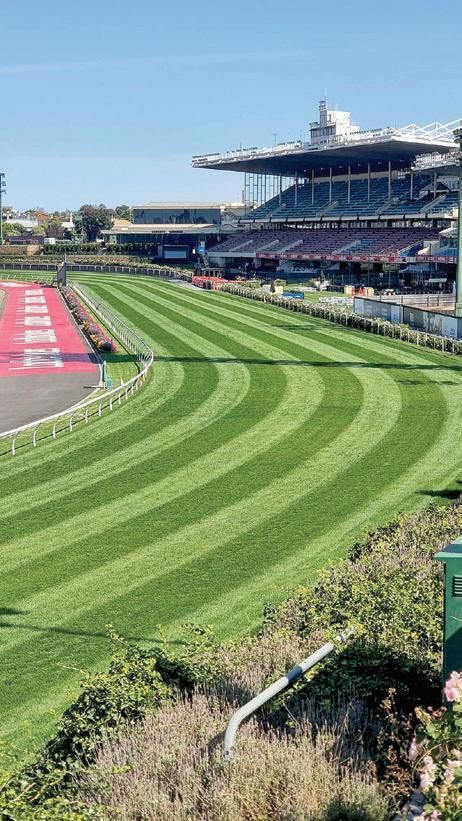

TRAVIS STEVENS
“All set for William Reid Stakes Day. 20-week break from racing after today, renovations start tomorrow.” (Moonee Valley racecourse in Melbourne was all striped up and looking a picture ahead of one of its biggest meets of the year in late March. The Group 1 William Reid Stakes was raced over 1200m, with Imperatriz collecting the honours on a Good 4 track.)
6 AUSTRALIAN TURFGRASS MANAGEMENT 26.2
SOCIAL MEDIA
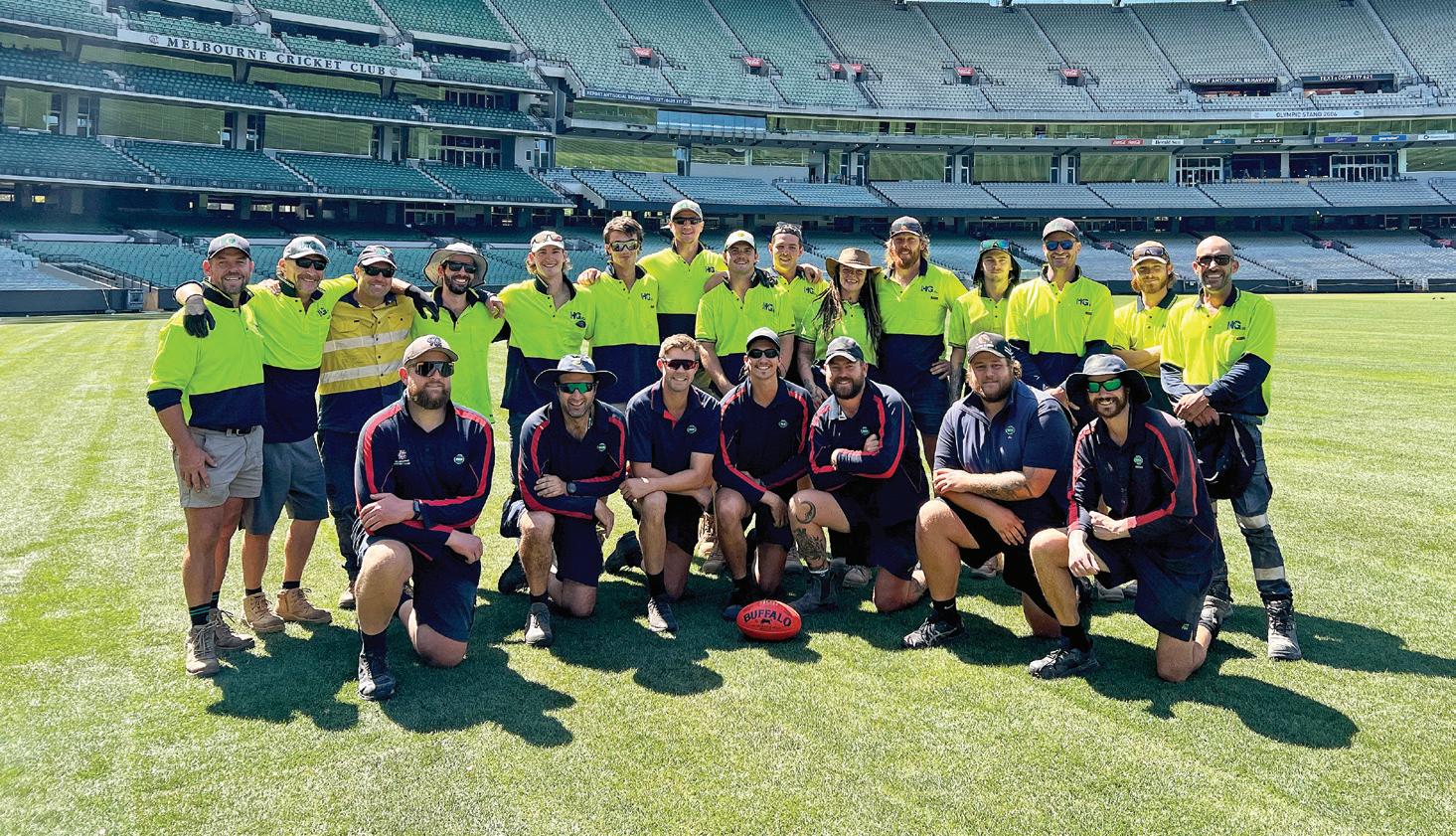

HG TURF GROUP
“Nearly 12,000 square metres of Hero hybrid turf was replaced at the Melbourne Cricket Ground recently after a record-breaking 288,000 lucky fans saw superstar Taylor Swift in concert. It was a significant undertaking to ensure the ground was in optimum condition and ready for the 2024 Toyota AFL Premiership Season.” (After three sell-out Taylor Swift concerts in late February, HG Turf and the MCG arena crew effectively replaced two thirds of the playing surface over a 10-day period, two weeks out from the ground’s opening weekend of the 2024 AFL season which saw it host four games in four days.)
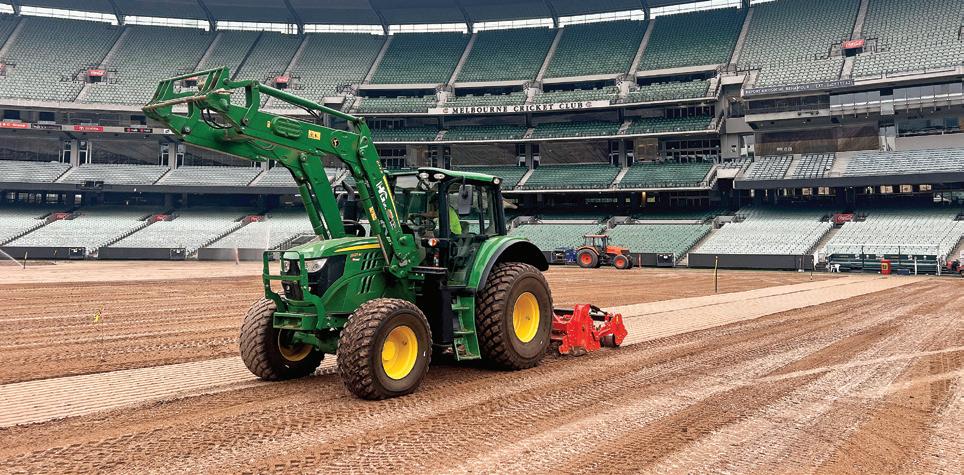
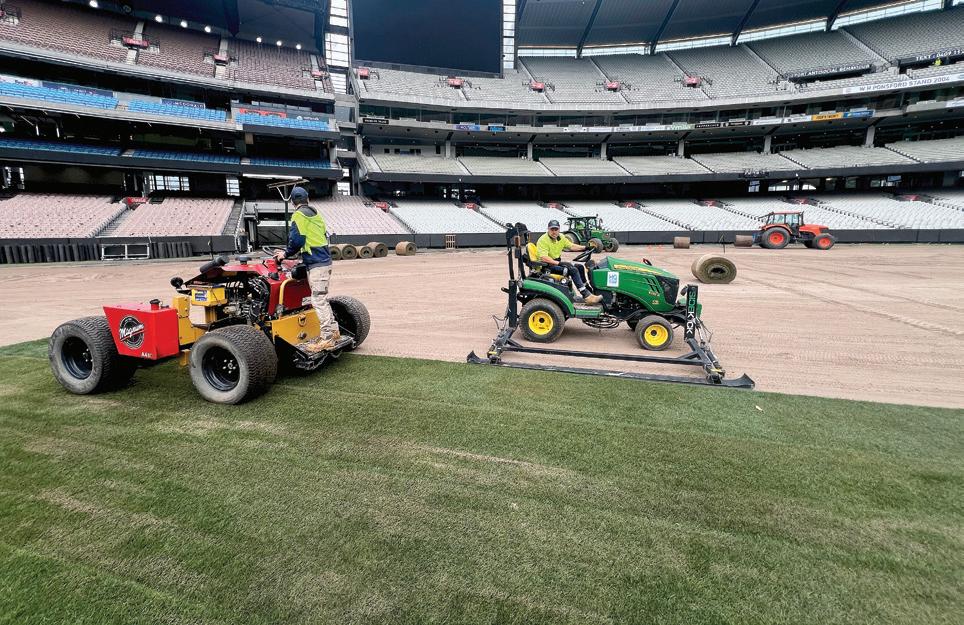
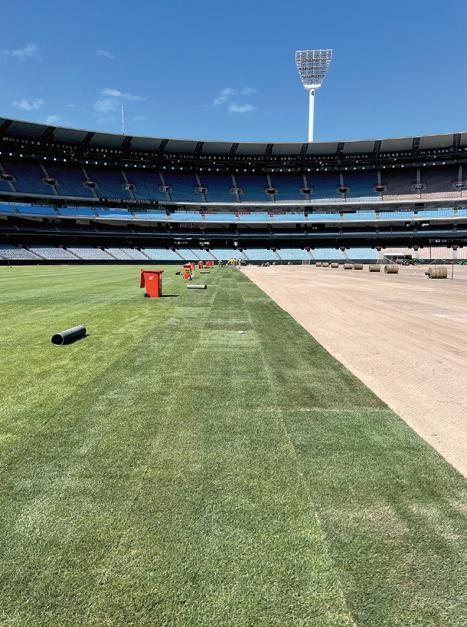
MARCH-APRIL 2024 7

TOURNAMENTS
The Grange Golf Club entertained the second instalment of LIV Golf Adelaide in late April, with the composite layout again presented in brilliant condition across the three rounds of play. Pictured is The Grange’s 9 East hole which played as tournament 2
PHOTOS: BRETT ROBINSON
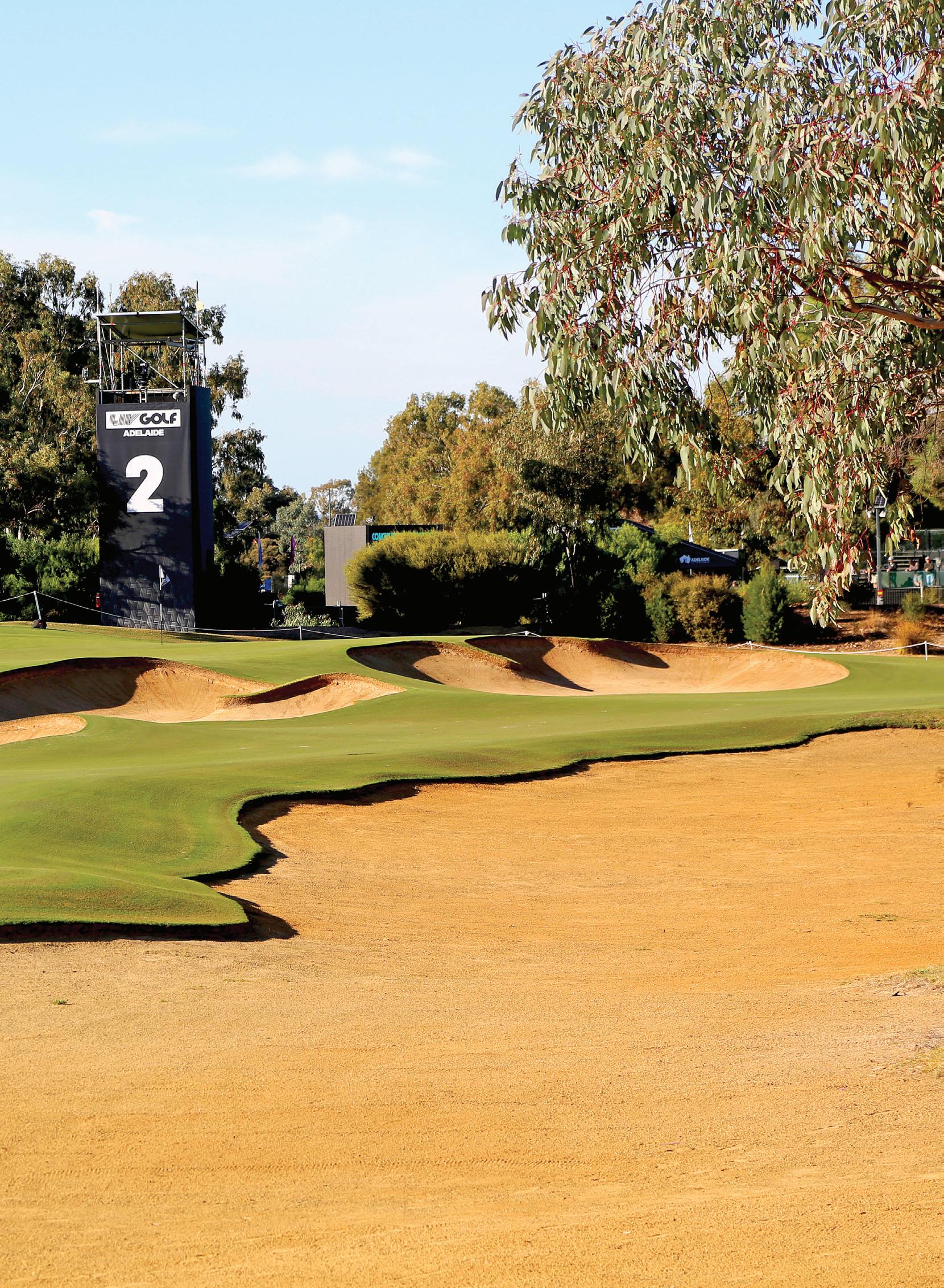
Ripper week at The Grange
It was always going to bigger, louder and better and for the second year in a row LIV Golf Adelaide could not have gone to script any better. Although no hole-in-one on the now-famous ‘Watering Hole’, it was a dramatic teams playoff victory by the Cam Smith-captained Ripper GC which ensured this year’s instalment at The Grange Golf Club will be long remembered. ATM editor Brett Robinson catches up with superintendent Rowan Daymond to look back on their preparations and another memorable week which saw 94,000 fans LIV it up.
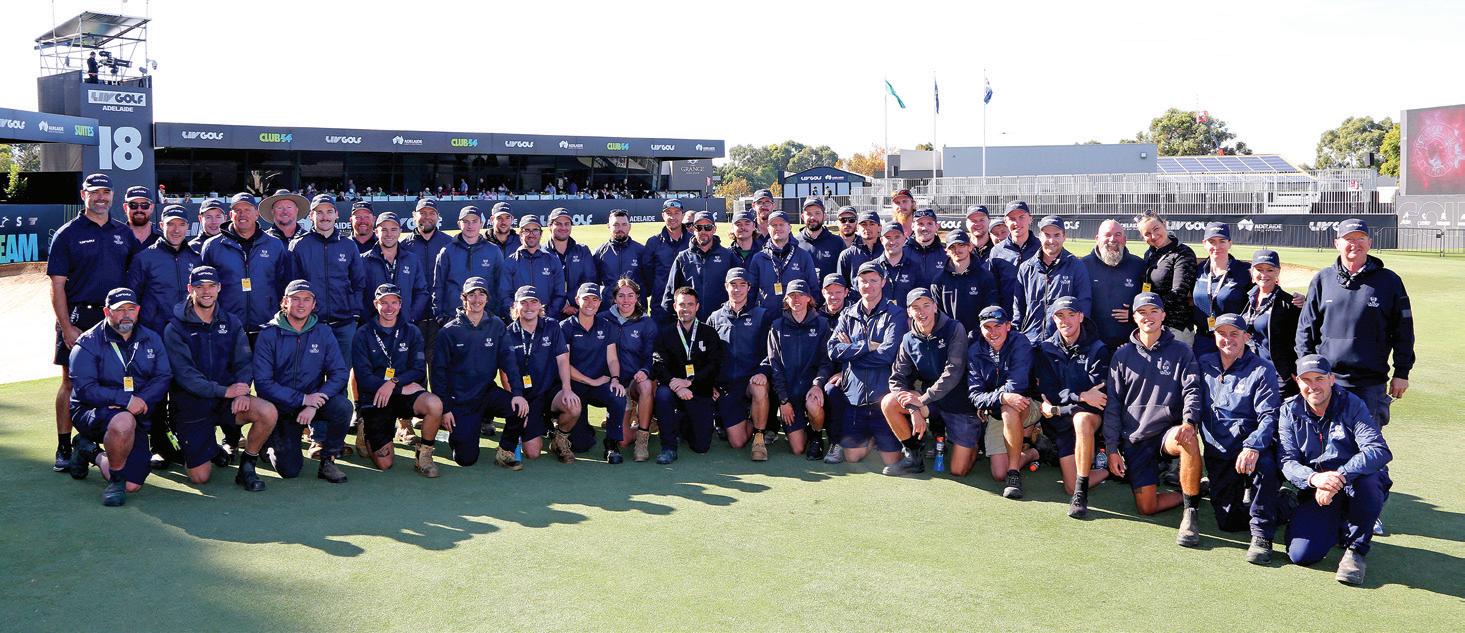
Rowan Daymond has been pinching himself a lot over the past 12 months. Last April, as the first iteration of the highlyanticipated LIV Golf Adelaide was coming to its climax, a hole-in-one midway through the final round on the ‘Watering Hole’ was the icing on the cake to a breakout week Down Under. Ask Daymond, who was sitting behind the green at the time and watched it drop, and it still gives him goosebumps.
Twelve months on and the expectations were for LIV’s return this past April to be bigger and better (and louder, as is the league’s catchcry), but neither Daymond nor the tournament organisers could quite have imagined what would transpire second time around. After 77,000 had descended on The Grange last year, that number was substantially eclipsed as more than 94,000 streamed through the gates across the three rounds in what would prove a ‘ripper’ of a week.
The script could not have been written any better, again. Last year it was vision of Chase Koepka’s hole-in-one and the resultant wild celebrations from a heaving crowd which were beamed around the world. Although a repeat wasn’t forthcoming this year, it was another storyline which would dominate and make its own entry into Australian golf folklore.
While American Brendan Steele (of the HyFlyers GC team) played some sublime golf to win the individual title with a total of 18-under, it was but a postscript to the main event in the eyes of a partisan Sunday crowd. Hometown heroes Cameron Smith and Marc Leishman, of Ripper GC, catapulted the event into another stratosphere when they won a thrilling playoff to clinch the teams event and with it the $5 million winner’s cheque.
The drama by which it all unfolded could not have been more fitting – a playoff pitching
Australia v South Africa, not one but two trips down The Grange’s 18th West hole to decide it, a Lazarus-like performance by the Aussies after all was seemingly lost on the first playoff hole and a South African capitulation at the death. It was another epic chapter in the two nations’ age-old sporting rivalry.
Watching it all play out – the gutsy par saves by Smith and Leishman to extend the playoff to a second hole and the bunker calamity which befell the Stingers GC duo of Louis Oosthuizen and Dean Burmester – was Daymond, who along with the rest of The Grange tournament crew had gathered behind the 18th green. Perched on that back left corner, right in front of where the pin was for the day, they had the best seat in the house to witness Smith make a tap-in par and win LIV’s first teams playoff in 28 tournaments.

“Who needs a hole-in-one?” quips Daymond when asked about the finale to this year’s tournament. “It couldn’t have gone any better to be honest. When Leishman and Smith sunk those clutch putts on the first playoff hole, that was the biggest roar I’d heard all event. Everyone was loving it, but when the South Africans put both their shots into the bunker, side by side, everyone knew at that point it was going to be pretty hard to win.
“Before the tournament I had been speaking with some of the LIV staff about last year’s event and they mentioned how that hole-in-one was perfect and how this year it would be great if there was a teams playoff involving the Rippers and one of the big teams, like Bryson DeChambeau’s Crushers GC. Well, they got that wish, but just a different team. The atmosphere was absolutely mental and it was so cool for the crew to experience that. It was an amazing way to end the week.”
LESSONS LEARNED
A win by the hometown favourites provided not only a perfect finish for the tens of thousands of fans who flocked to The Grange across the week, but also for Daymond and his crew who again pulled out all the stops to have the composite course (made up of nine East and nine West course holes) at its peak. After having just a five month lead-in for the first tournament, The Grange team had pretty much a full year to prepare for LIV’s return visit which meant they could work on some of the key learnings that came out of that first event.
From the high of last year’s tournament, the crew came back down to earth pretty quickly in the days and weeks after. Once all the infrastructure disappeared and lots of
10 AUSTRALIAN TURFGRASS MANAGEMENT 26.2 TOURNAMENTS
The Grange Golf Club tournament crew peaked at 60 for the week, with 30 volunteers arriving from across South Australia and around the country the weekend before
Grange senior greenkeeper Jayden Pearce (left) on course set up alongside Clifton Springs volunteer Josh Bowen on day one
yellowing turf started to be exposed, it was all about repairing any damage and reinstating the course as quickly as possible. As part of that they sodded about 3000m2 of replacement turf in the worst affected areas, mainly the thoroughfares for foot and vehicular traffic and on the sides of fairways.
It took about two weeks for the greens to get back to the same level as the nontournament greens, while all up it took about two months for the course to fully recover. Daymond was pleasantly surprised with how well it did come back and how the courses played throughout that winter. Indeed, the members, who had experienced a lot of disruption in the lead-up, were rapt to get their course back as quick and in the condition it was in.
Knowing they had a longer lead-in time for the second effort, it afforded Daymond the luxury of being able to take care of some of the ancillary work, such as in the out of play areas and vegetation, over the winter months and tick off some jobs which they weren’t able to get to the first time round because of a lack of time. It also gave Daymond the time to plan ahead more. There were a few key areas agronomically that he wanted to work upon for LIV’s return and foremost on that list were finetuning their programs and practices relating to moisture management and nutrition.
“We took a lot out of last year with our nutrition program and how we wanted to manage that,” explains Daymond. “Our watering schedule was also something that we looked at a lot more closely and we ended up doing a lot more handwatering to keep the numbers and the greens consistent. That was really helpful and you could see it in the health of the greens this time.
“Because of our climate, we rely more on watering through our overheads with as much handwatering as we can manage. This time, about two months before the tournament, we put one staff member – senior greenkeeper Mal Grundy – in charge of moisture management across both courses, whose job it was to constantly monitor the greens and handwater where required.
“Having Mal across where all the low and high percentages were and being able to alter the water to get everything consistent proved really beneficial. The greens would still get two deep cycles a week, with the handwatering on top to help them along. Mal did a great job and was out there every day, even coming in at weekends and midweek nights to ensure they were getting what they needed.
“With the nutrition we ran a higher input program on all turf surfaces. We don’t often do drench fertility applications, but we did a few of
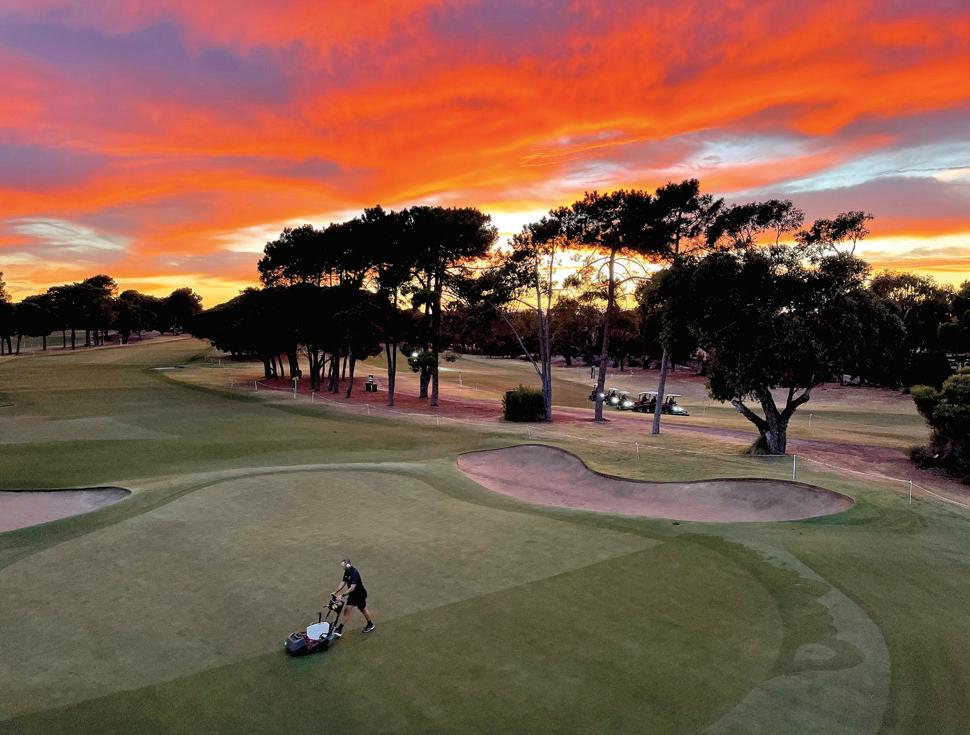
those throughout the season in addition to our foliars. We just try to keep things as healthy as possible to get through our summer as well as we can. It was very dry in the lead up to the tournament so we just had to keep the health there as much as possible before backing everything off a couple of weeks before LIV.”
After a wet lead-in to last year’s tournament, this time around Adelaide’s unique climate returned to its more usual drier course, although some humidity around the New Year did create a few challenges. After a wet Australia Day which saw around 30mm fall, it was effectively bone dry from then up until the start of April. The Bureau’s Adelaide Airport station, about eight kilometres from The Grange, recorded no rain for the month of February and just 2.4mm for March, with only
that amount recorded for the 65-day stretch from 27 January to 31 March. The mean temperature for March was also 4.5 degrees warmer than 2023 (28.5 compared to 24) while there was a nine-day stretch between 5 and 13 March where temperatures reached tops of between 32 and 38.
“It was a funny old season,” reflects Daymond. “Although it was drier, prior to that we had some wet and unusually humid weather in December and January, right around that peak growing period for the couch. That left us scalping a lot of turf due to excessive growth and we just couldn’t keep enough regulation in the plant. We were churning grass off in some areas so we had to lift some of our heights of cut to combat that. By the time we got on top of our growth

MARCH-APRIL 2024 11
Lake Karrinyup Golf Club volunteer Richard Michell has a picture-perfect backdrop as he cuts the 16th green, while the fairway mowers make their green-to-tee run up the 15th ahead of the second round
Grange apprentice Brad Strapps is all focus as he cuts the 7th tee. All tees were hand cut at 6mm
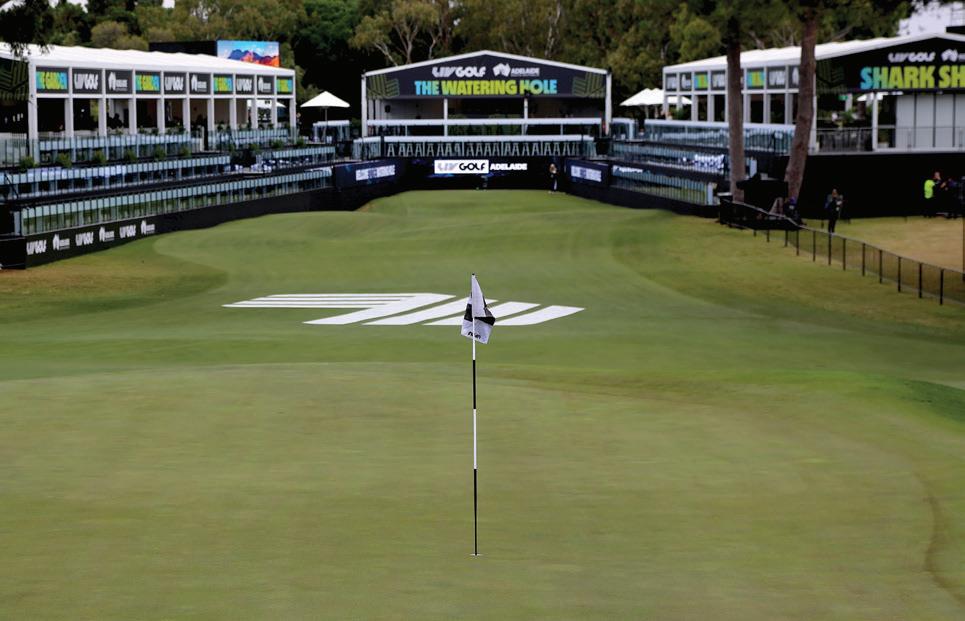
regulator program, the humidity disappeared and we then went through a real dry period.
“The year before was very wet and because the greens were getting a regular flush we didn’t really have too many of our normal turf issues that we get due to our poor water quality. With that 60-odd day dry spell this time, we were putting out a lot of amended water. Our water quality is such that if we don’t amend it with acid, within a week we can see the greens go backwards and we can start losing turf. With the high bicarbonate levels in the soil, you can put as much nutrition on as you want but it just gets bound up in the soil. At its worst, our pH levels are up around 9 and
we try to work within an ideal range of 6.5-7.5. We have a testing system that monitors the water constantly and then amends it into our tanks before it goes out through the irrigation system.”
Another slight change to Daymond’s agronomic programming came in the form of greens aeration. After their usual course renovations had been carried out across both courses last September, Daymond stepped up the level of greens aeration in the immediate months before the tournament. That consisted of regular ninja-tining and running the club’s recently-purchased Air2G2 unit across the greens. Daymond would go out with the
ProCore monthly, which is not something they’ve done historically, with the Air2G2 following up in between.
“I don’t know whether to put it down to Mal’s handwatering or the Air2G2, or a combination of the two, but we were seeing much denser and deeper root systems across the board,” states Daymond. “Conditionwise, the greens were certainly much better come the tournament than last year. We were stressing them out quite significantly this time but they handled it very well.”
SMOOTHER BUILD
Outside of getting the turf surfaces in their sweet spot, one of the big learnings across the whole event from last year came with the infrastructure build. While outside of Daymond’s control, last year’s build started late, with contractors still putting the finishing touches to some of the structures on the morning of the first round. That had a flow on effect for Grange staff who were often called upon to manage traffic flows which took them away from focusing on the course.
Such was the success of last year’s event, the infrastructure build for this year’s tournament increased significantly to accommodate additional public and corporate ticket sales. Corporate hospitality areas were up by 30 per cent, while the number of general spectator viewing platforms increased from four to 14.
To make sure everything ran smoothly, specialist major event engineering and project management company iEDM was appointed to handle the infrastructure build from the get go. The first lot of trucks rolled through The

12 AUSTRALIAN TURFGRASS MANAGEMENT 26.2 TOURNAMENTS
The calm before the storm. The now-famous Watering Hole – The Grange’s 12 West – appearing serene ahead of the spectator throngs descending on day one of LIV Golf Adelaide
Grange apprentice Jared Charlton (right) leads Royal Queensland volunteer Glenn O’Sullivan (middle) and Swedish seasonal greenkeeper K arl Blusi (left) as they weave their way through the fairway bunker complex on tournament 7. The Santa Ana couchgrass fairways were cut at 8mm for the tournament
Grange gates in the third week of February to start on the Watering Hole (pictured opposite) and for the next eight weeks transformed the course into a major tournament venue. From Daymond’s point of view the build could not have gone any better, enabling them to focus on preparing the course while also limiting the disruption to members.
“The build was a lot bigger and a lot better run,” says Daymond. “iEDM do major events like the Formula 1 and AFL Gather Round so they were very well versed and had it much better organised this year. There were a lot more elevated viewing platforms around the place and the corporate suites went upwards rather than outwards. The capacity of the Watering Hole was up by a few thousand. The extra infrastructure did impact on our irrigation a little bit and we needed to do some more handwatering around tees and the couch surrounds to keep the turf ticking along.
“iEDM worked in really well with the club and were able to adapt the build to facilitate the members better than last year. Members had full use of the course all the way up until the Saturday before. They were again playing a shortened 16-hole course on both the East and West. Last year all the build in the members’ car park went up 6-8 weeks prior to the event but LIV staff didn’t turn up until the week before. This year they brought that in a lot later which didn’t inconvenience the members as much.”
TOURNAMENT SET UP
With tournament week arriving, The Grange crew swelled to 60, with 30 volunteers coming in from across South Australia and around the country (see more on this year’s contingent on pages 16-19). After being inducted and taken on a course tour, Daymond and assistant superintendent Jeff Gillies conveyed their plans and regimes for the week. With many hands, and machines, at their disposal, it gave them the luxury of being able to rotate the volunteers through most jobs, rather than just allocating them one task all week.
Across the week, the A1 (West) and A4 (East) bentgrass greens were single cut at 2.8mm (bench height) with a prism gauge showing an actual height of around 2.4-2.5mm. Due to some inconsistencies with speed on the morning of the second and third rounds, some greens received additional cuts and/or a roll (with the walk-behind units) after being stimped following the initial cut. The greens mowing team was headed by four relatively new Grange recruits in qualified greenkeepers Dominic Jones and Cameron Fleeton and apprentices Sergio Barone and Gage Parsons, with Daymond saying they took to the responsibility very quickly.
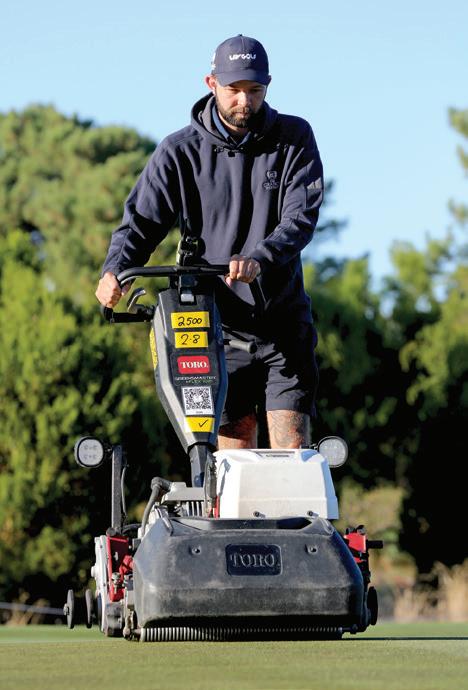
Grange apprentices Casey Clarke and Brad Strapps led the crew for collars and tees which were hand cut at 6mm, while the surrounds and approaches were also cut at 6mm with triplexes, headed by qualified greenkeeper Lachy Couzner and apprentice Tim Stewart. More triplex units were brought in for the tournament to cut those finer turf areas rather than larger units which were used last year.
As they were last year, the Santa Ana couchgrass fairways were cut from green to tee at 8mm. Daymond had wanted them at either 6mm or 7mm for the tournament but due to some scalping issues they were brought back up. Apprentice Jared Charlton and qualified greenkeeper Paul Thomas led the fairway mowing crew which numbered as many as seven, including Jake Holland who cut fairway laps at 15mm.
Grange senior greenkeeper Jayden Pearce was on course set up during the week and was joined each day by a different volunteer. Likewise, Brad Round (stimpmeter readings) and Grundy (Pogo readings) were on data collection with a different volunteer also riding shotgun with them each day.
“At the start of the week we had the greens in a position where we only needed to single cut them to get to the 12-and-a-half that LIV wanted,” says Daymond. “We were conscious in the mornings of not over-cutting. At that time of year things can look pretty worn out, so there were a couple of days before the tournament where we didn’t cut greens or fairways.
“The greens probably felt during the Wednesday Pro-Am that they were already like Friday greens or weekend greens, so I was a little bit nervous about that. But then we had 1.5mm of rain Thursday morning which freshened things up a little and was actually beneficial and helped to push them through.
“On the morning of the second round, that was the first day where we noticed some inconsistent numbers, with probably a foot difference between the fastest and slowest greens which hadn’t been the case earlier in the week. I couldn’t really put it down to anything to be honest because they had all been treated similarly. We would single cut and then do our stimps and then make the call whether we went over them again. A couple of greens had a double cut and a roll with the greens unit or a triple cut so they could come up into the 12-and-a-half range.
“It was the same again on the third morning with a bit of double cutting required on a few of the greens. Speeds came up to the high 12s/13 which was good and exactly where the organisers were happy. They were a lot firmer this year and they ran flat and true. Putts were running out well and as the tournament progressed and they dried out,

MARCH-APRIL 2024 13
Dominic Jones cuts the green on tournament 8
Grange crew member Lachy Couzner cuts the 7th approach at 6mm
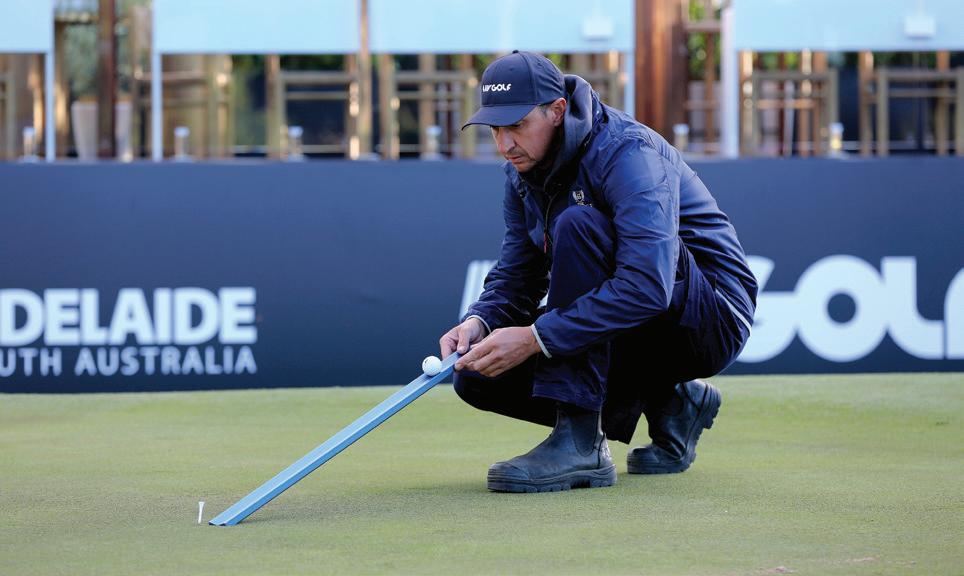
those putts that were just off line were shown up. If they had the right line they were rolling in some of the those longer putts nicely.”
ON ‘BOARD’
Preparation of The Grange’s impressive bunkers, which drew high praise last year from Ian Poulter who posted on Instagram that they were among the best in the world, was again overseen by bunker technician Cameron Semple, with Grange staff members Matthew Barnes, Matthew Kinge and Daniel Bond in charge of the respective crews that prepped them ahead of each round.
As they do for normal member play, The Grange team broomed the faces and alternated raking and boarding the bases each day during the practice rounds. That became
PREMIER MALINAUSKAS PRAISES GRANGE CREW
Last year it was an Open Championship winner and LIV team captain, this year it was a Premier! Towards the end of Friday’s opening round of LIV Golf Adelaide, as The Grange crew were about to head out on their afternoon assignments, South Australian Premier Peter Malinauskas stopped by the maintenance facility.
Just as Ripper GC captain Cam Smith had done during the previous year’s tournament, the Premier addressed the crew inside the lunchroom and praised them for all their efforts not only this year but last year as well. After congratulating them, the Premier then posed for a photo and also got in on a selfie taken by superintendent Rowan Daymond (pictured right)
“Pete is the man here in South Australia at the moment with LIV Golf and the AFL’s Gather Round coming to the state – he’s almost as big as Cam Smith!” quips Daymond. “I got a call from our club
a discussion point among the players as to how the bunkers would be presented across the tournament rounds. Daymond’s preference was for boarding and after a players’ meeting on the eve of the tournament LIV golf officials gave the go ahead.
“Last year we were levelling the bunkers all the way through the practice rounds and it got to day one and they (the officials) wanted us to rake them,” explains Daymond. “That was a little bit disappointing as we thought they were coming up really well with the boards and that’s how we wanted to present them.
“This year we were raking them and levelling them on alternate days just to keep them a little bit fluffy but still level and firm enough. So, the players would see them level one day and then raked the next. We got a
lot of feedback as to what we would land on for the tournament and they said they’d rather them level and have that consistent lie. That was put across to the tournament director and they approved it Thursday. It didn’t mean we spent any less time in them, but it gave us the look that we were after and the consistency.”
As they had done with the first LIV tournament, crew members who wanted to were able to volunteer as bunker rakers (or boarders) that accompanied each playing group during their round (see photo right) After breakfast each morning, those who had put their hand up to volunteer pulled a group randomly out of a hat. Grange crew member Nathan Ritter jagged the plum gig for the opening round when he pulled the group containing team captains Cam Smith, Jon Rahm and Sergio Garcia, while Holland pulled the all-Aussie Ripper GC grouping of Leishman, Matt Jones and Lucas Herbert.
“It was great that we were able to offer that for the crew again,” says Daymond. “It is a great opportunity to get a real sense of the atmosphere out there walking inside the ropes. It was pretty exciting, especially on the Watering Hole and for the guys that got the big groups. Everyone really enjoyed it although a few of them looked a bit nervous heading out there for the first time on the Friday – I think I would be too with the crowds we had and not wanting to make a mistake! They all came back raving how good it was and most would put their hands up again for the next day.”
While there were no doubt a few nerves, Grange crew member Dominic Jones literally had his boarding efforts beamed to a global television audience. During the tension of the
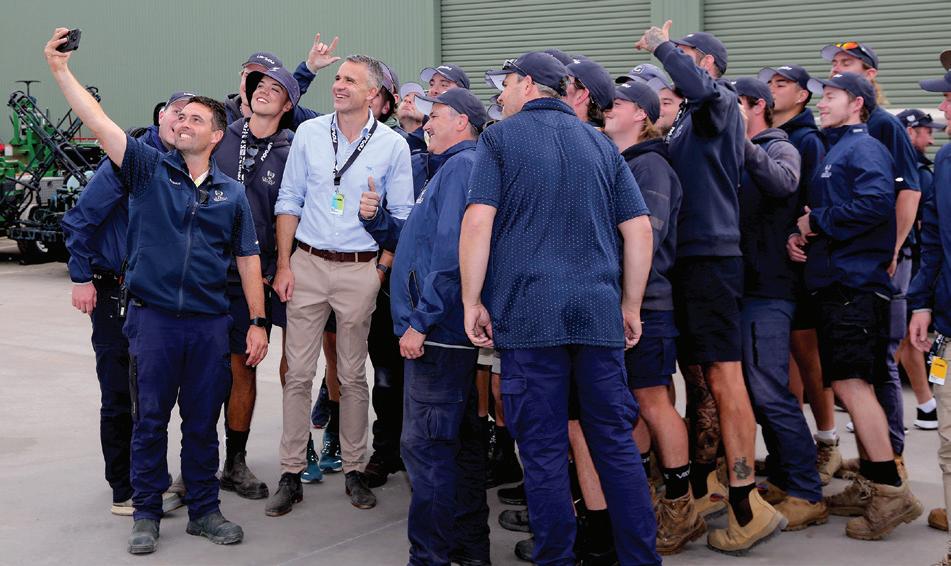
president out of the blue saying that the Premier was on his way over to the volunteer tent and that if we had time he would like to come and visit the ground staff as well. He popped in and thanked us and mentioned
how big an event LIV was for South Australia and how grateful he was for the work we were doing to help deliver an event that has attracted so much attention. All the guys were really appreciative of it.”
14 AUSTRALIAN TURFGRASS MANAGEMENT 26.2 TOURNAMENTS
Senior greenkeeper Brad Round stimps the Watering Hole green. Speeds were up to 13 during the final round
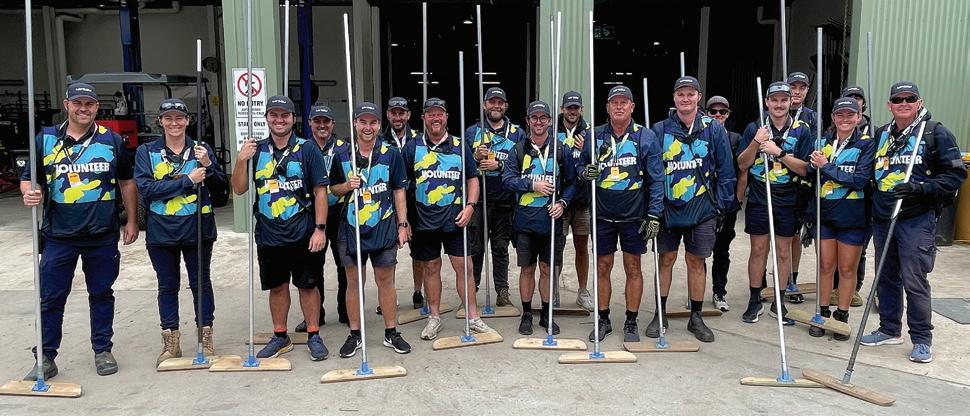
Members of the crew could volunteer as bunker rakers/boarders and accompanied each playing group during all three rounds. It provided an ideal opportunity to be inside the ropes and experience the unique LIV atmosphere
second playoff hole in the teams event, the Stingers duo of Oosthuizen and Burmester put their second shots into the back bunker on 18, with both balls coming to rest side by side. After Burmester marked his ball and then moved the mark, Oosthuizen played his shot before Jones came in to repair the surface so Burmester could take his shot.
As he levelled the sand with the TV cameras and microphones on him, Jones remarked to Burmester, “I feel like there are thousands of people watching me”, to which Burmester replied with a laugh, “Millions brother!” Burmester proceeded to then chunk his shot
into the face of the bunker, effectively handing the win to the Aussies.
As a funny aside, it wasn’t actually Jones’ bunker to board. Fellow Grange crew member Tim Stewart had been doing the playoff holes, but after getting caught up in the huge spectator throng that engulfed the 18th hole, he couldn’t get through to the back of the green in time. Jones, who had been boarding bunkers for another group during the final round, jumped in and took the limelight at the most opportune of moments.
“Overall, from a turf perspective, I was happy with the way the course played,” sums
up Daymond. “I probably would have liked the greens to be a little bit firmer. You’ve got your own expectations on how these events would look and play and I’d like to see them a lot firmer and faster than what the officials want them, but to be able to maintain the course to the standard that the LIV organisation were after was very pleasing.
“I guess some of the stress levels I had for this year’s event came off the back of the success of last year. I still pinch myself thinking back to that week, especially that hole-in-one on the Sunday, and go ‘Wow, did that really happen?’ I wondered whether we would be able to hit those targets again, but I think the crew all stepped up and knowing what we had to achieve and what we achieved last year, it was all about hitting those standards again and I think we definitely did that.
“It was great seeing the Rippers get up on home soil, but the highlight for me was just how well all of the staff pulled together to make this event happen. We’ve got a great group at the moment who are well versed in what they do and having the volunteers come on board and learning the ropes so quickly and fitting in well is a testament to our staff. As a superintendent you always take a lot of pride in that and seeing a club like The Grange representing the industry so well.”

MARCH-APRIL 2024 15

LIV ropes Inside the
IMany
n order to produce the superb surfaces that were on display at The Grange for LIV Golf Adelaide, course superintendent Rowan Daymond and his crew of 30 had some generous assistance on a number of fronts across the week and the months leading up.
As they did in 2023, the club put a call out for tournament volunteers and not surprisingly the roster filled up pretty quickly. Thirty greenkeepers, including 13 apprentices, arrived the Sunday before to boost tournament numbers to 60. More than a third of those
volunteers were drawn from local Adelaide or South Australian clubs and venues, among them South Lakes, Naracoorte, Kooyonga, Flagstaff Hill, Tea Tree Gully and North Adelaide golf clubs, in addition to ground staff from Adelaide Oval and the City of Unley.
Victoria was well represented with a team of six volunteers, among them Cranbourne Golf Club superintendent and VGCSA treasurer Nicholas Douglas who drove across from Melbourne. Also making the journey by car was Leongatha Golf Club apprentice Ethan Woodall who clocked up an impressive
1700-kilometre round trip to get his first taste of a major tournament. Royal Melbourne had two volunteers in the form of Hugh Ryan and Henry Sexton, while Metropolitan Golf Club’s Tom Martin enjoyed his LIV debut last year so much that he put his hand up to go around again.
Karratha Golf Club superintendent
Callum Hitching headed a group of four Western Australians, which also included Lake Karrinyup duo Richard Michell and Matija Kotnik and Royal Perth apprentice Kye Wood. Recent Future Turf Managers’ Initiative graduate and Avondale Golf Club assistant
16 AUSTRALIAN TURFGRASS MANAGEMENT 26.2 TOURNAMENTS
hands – and machines – helped to make light work of course preparations at LIV Golf Adelaide.
WORDS AND PHOTOS: BRETT ROBINSON
Chloe Cooper, Jorjia Hogg, Penny Deehan and Martyna Synak joined The Grange crew to help prepare the course for this year’s LIV Golf Adelaide tournament as part of the ASTMA’s Women in Turf Strategy work placement program
superintendent Brayden Luc made the trip down from NSW, while Royal Queensland’s Glenn O’Sullivan got the chance to compare how The Grange managed their tournament set up given his prior involvement with the Australian PGA Championships which his club has hosted in recent years.
“Volunteering at LIV Golf Adelaide was an absolutely fantastic experience,” says Douglas, who has been Cranbourne superintendent for the past two-and-a-half-years. “I took the opportunity to work such a massive event for a couple of reasons – to tick off a big tournament which I had yet to do in my professional career and also to see if LIV Golf really lived up to the hype. It delivered in spades on both counts!
“I met a lot of great people, all striving for a common goal under Rowan to produce the best possible product for the event and I’m proud to have been a small part of the team that achieved that. The conditioning and playability of the surfaces for the event were some of the best that I’ve ever seen.
“The personal highlight was being inside the ropes next to the 18th green for the playoff holes. It was a sporting atmosphere that was as close to something like the MCG on Boxing Day as I’ve ever witnessed. A truly memorable experience that I won’t forget.”
STILL BUZZING
Through the support of Daymond and The Grange Golf Club, among this year’s volunteers were four female sports turf managers who joined the crew as part of the Australian Sports Turf Managers Association’s Women in Turf Strategy work placement program. It was the fifth such opportunity that the ASTMA has facilitated in conjunction with the host venues over the past 18 months and added to previous placements during the AFLW Showdown, WBBL, The Athena tournament and last year’s ISPS Handa Australian Open.
Chloe Cooper (apprentice, Royal Canberra GC, ACT), Jorjia Hogg (apprentice, Belmont Golf & Bowls Club, NSW), Penny Deehan (assistant superintendent, North Ryde GC, NSW) and Martyna Synak (3IC, The Lakes GC, NSW) were selected to join the volunteer corps, all staying together and working alongside each other throughout the week. For Hogg and Cooper it was their first time experiencing a major tournament, while for Deehan and Synak it was a chance to reconnect after they had volunteered together at last year’s TPS Murray River tournament at Cobram Barooga Golf Club as part of a similar initiative run by John Deere.
“It was great having the four of them part of the crew for the week and I hope they really

enjoyed the experience,” says Daymond. “They all did a fantastic job and because we had the luxury of numbers and also the later shotgun start, we were able to rotate everyone through various jobs during the week. They also had the chance to volunteer on the bunker crew each round and got to experience the tournament atmosphere inside the ropes.”
Even a week after arriving back to her home course in Belmont, about 35 minutes south of Newcastle, Hogg was still buzzing over the experience. The 25-year-old is in the third year of her apprenticeship at the public links course and putting her hand up to volunteer was all about wanting to experience a major event and gaining an insight into the level of detail required to prepare surfaces for an international tournament.
She got that wish and throughout the week undertook a range of jobs out on course alongside the regular Grange crew members and fellow tournament volunteers. She was a regular member of the bunker crew, did some hand-mowing, divotting and blowing tees and went out changing holes early in the week which allowed her to get to know the course better.
“It was an awesome week,” says Hogg. “Being able to experience a LIV tournament and to be a part of that and walk into a team like Rowan’s that made the week so easy, it was honestly the most amazing experience. I can’t stop thinking about how good it was.
“I didn’t really know what to expect when I first turned up. You obviously hear from people that have done tournaments before about the workload, the lack of sleep, but honestly the pure adrenaline of the whole week just kept you going. It was so exciting, especially the atmosphere of LIV Golf. There was something happening all the time.
“The first day we turned up and got to have a walk around the course which was unreal. I hadn’t seen anything like it. Obviously it was set up for the tournament and it was at its peak, but to see that level of conditioning last through the entire week was really cool. I’ve never seen greens that hard and roll that fast before so it was good to watch how the course played throughout the week.
“Rowan’s message to all of us was to just take it all in, really enjoy it, don’t be afraid to ask questions and treat the week as if we already work there. The Grange crew were so

MARCH-APRIL 2024 17
For Royal Canberra’s Chloe Cooper, LIV Golf Adelaide was her first time volunteering at a major tournament
Hugh Ryan was one of two volunteers to come across to The Grange from Royal Melbourne Golf Club
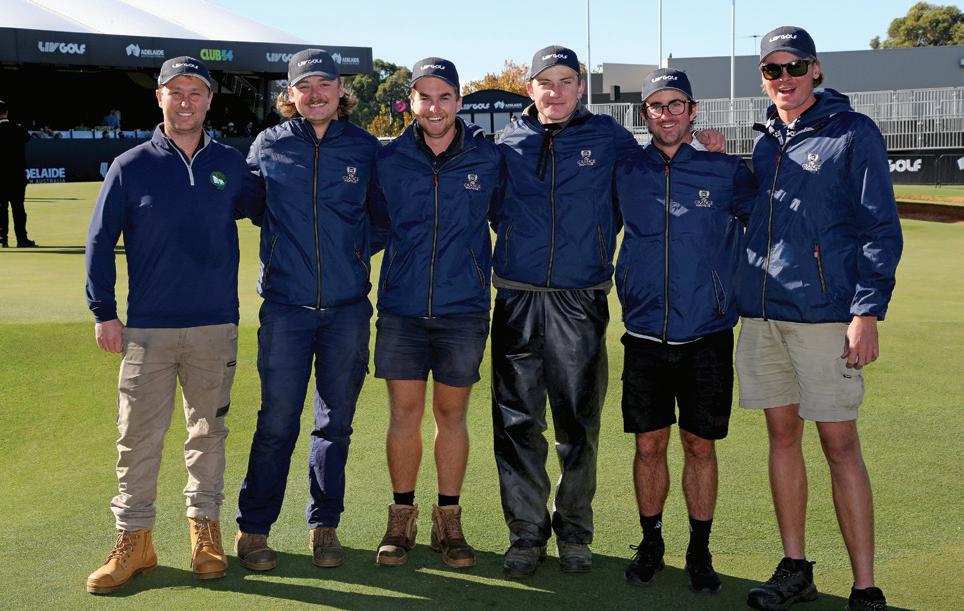
welcoming and treated us like we were part of the team which made it so enjoyable.”
Outside of getting to experience course set up at the highest level, Hogg revelled in the opportunity to spend the week alongside three other female sports turf managers. Getting the chance to meet and talk to the likes of Deehan and Synak, who both currently hold senior roles at private clubs and between them have 27 years’ industry experience, it was a prime opportunity for Hogg to ask them about their journeys and gain some pointers on how she could progress her career.
“I met Penny and Martyna on the flight to Adelaide and we instantly hit it off and chatted pretty much the whole way,” says Hogg. “Having the three other girls around and it being my first tournament experience made things so much more relaxing and enjoyable. We were all staying together so we could come back home at the end of the day and have our own company and talk about the day.
“To hear about Penny’s and Martyna’s past experiences of the industry was really interesting. Obviously Chloe and I are quite
new to the industry, so it was great to be able to listen to them about their careers, some of the challenges they have had along the way and get their advice on things. It was also interesting hearing Martyna talking about the Australian Open they had at The Lakes last year and comparing it to the LIV tournament and the differences in the courses and set up.”
The big highlight for Hogg, however, was getting the chance to go inside the ropes and see some of the world’s best players navigating their way around The Grange’s composite layout. A keen golfer since a young age who still plays regularly at weekends, Hogg put her hand up to rake bunkers during rounds one and three. On the Friday she drew the Fireballs GC team and witnessed Abraham Ancer slam dunk his second shot on the short par four 4th, his last shot of that round.
“I was right behind him and when I was watching it back on the TV footage later you can see me and scoreboard guys celebrating in the background – it was really funny to watch,” laughs Hogg. “The players, the caddies and the officials were all so
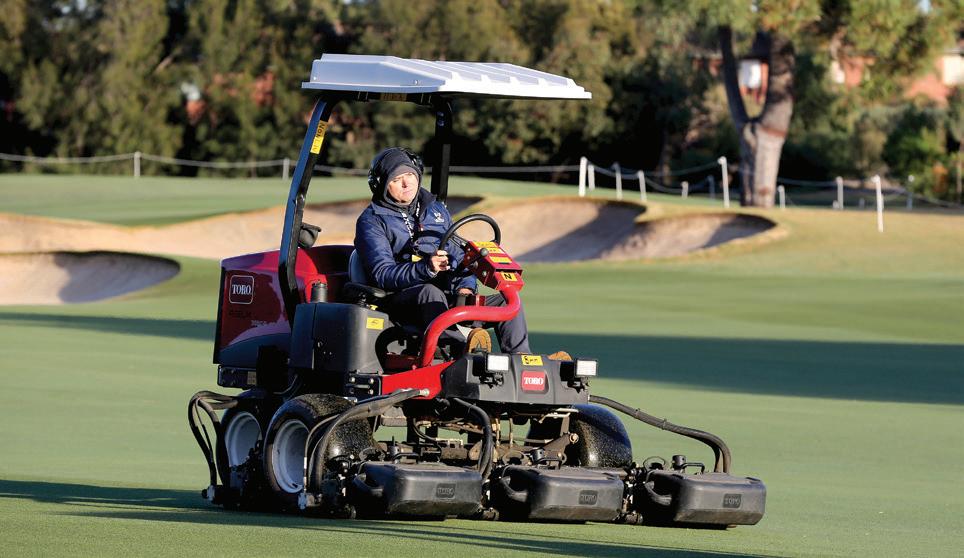

lovely, especially the players who were very apologetic for going into the bunkers often. It was a really cool experience especially being inside the ropes and getting a taste of the atmosphere and watching some great golf.”
MIXING IT UP
Despite battling a severe bout of flu, which ripped through pretty much the entire Grange crew during the week, Martyna Synak says the LIV event was one of the most enjoyable volunteering experiences of her career. Thirdin-charge at The Lakes since August 2022, Synak is no stranger to working tournaments, having ticked off multiple Australian Opens, an Australian PGA Championship, a Webex Players Series event as well as a US PGA Tour event during her time on The Ohio Program. Getting the chance to work alongside her fellow female sports turf managers and meeting a new crew made for an enjoyable week, along with one other very different aspect to past tournaments she has worked at.
“The highlight for me was the variety of jobs we got to do,” explains Synak. “It was very different to all the other tournaments I have done before. The fact that the volunteers were changing jobs was great. Usually you just get one job and you work with the same person from the team all week.
“From my perspective it was much more enjoyable changing jobs. You got to meet and work with a lot more people, get a different perspective on things and see other parts of the course. It was also good to try different machinery and equipment. Even though I have been in the industry for some time now, I had never used an electric push mower before, so that is something that I can say that I have used now.
Toro loaned a range of equipment, among them fairway and walk-behind units, to assist the expanded Grange crew prepare the course for the week
18 AUSTRALIAN TURFGRASS MANAGEMENT 26.2 TOURNAMENTS
The Victorian contingent - Nic Douglas, Henry Sexton, Hugh Ryan, Ethan Woodall, Josh Bowen and Tom Martin
Avondale assistant Brayden Luc cuts collars on the 9th
“It was such a pleasure being part of LIV and The Grange crew were amazing – such a welcoming bunch of guys and so nice and easy-going and happy to have us there.”
EXPANDED FLEET
As well as people power, The Grange also received plenty of support from a number of industry companies and suppliers. Working closely with Toro, Daymond and The Grange’s head machinery technician Tom D’Arcy organised additional transporters and mowers to arrive well in advance of the tournament. Toro brought in five fairway mowers (three 5510s and two 3550s), a number of walkbehind Greensmasters which were used for tees, collars and surrounds, as well as a number of the large eight-seater Vista transporters which were used by the bunker crews throughout the week.
Rather than having equipment arriving the week before the tournament, The Grange took delivery of them about two months out. That enabled D’Arcy and apprentice Sebastian Burford-Gost plenty of time to get them set up to the required tournament spec. Nearby clubs also loaned equipment, including Glenelg, Kooyonga, Flagstaff Hill (hand mowers) and Murray Bridge (John Deere blower).
Managing such a large fleet for such an important event is one of the many learnings that D’Arcy has quickly made since coming on board as the Grange’s chief mechanic in September 2022. Having spent the previous 11 years at Northpoint Toyota where he served as a technical advisor, the keen golfer one day spied the ad for a golf course mechanic at The Grange. Not having much of an idea of what the job entailed, he gave Daymond a call and went in for a visit.
After meeting with him and getting an appreciation for the size and extent of the club’s maintenance operations, D’Arcy was duly offered the job and since then hasn’t looked back. Having only just got his head around the wide range and types of equipment it takes to maintain a 36-hole golf complex, it was announced that the club would be hosting LIV. Just seven months into his tenure there, the 2023 event was D’Arcy’s first experience of an international golf tournament and he has now added a second to the resume.
“It has been some introduction,” reflects D’Arcy. “It was quite a transition coming across from Toyota, but looking back on it it was really good. As well as LIV being announced, I started around the time of course renovations, so that was my first experience of that and I got to see some pretty unique machinery from the get go. Putting all those things together in such a short period of time and then getting
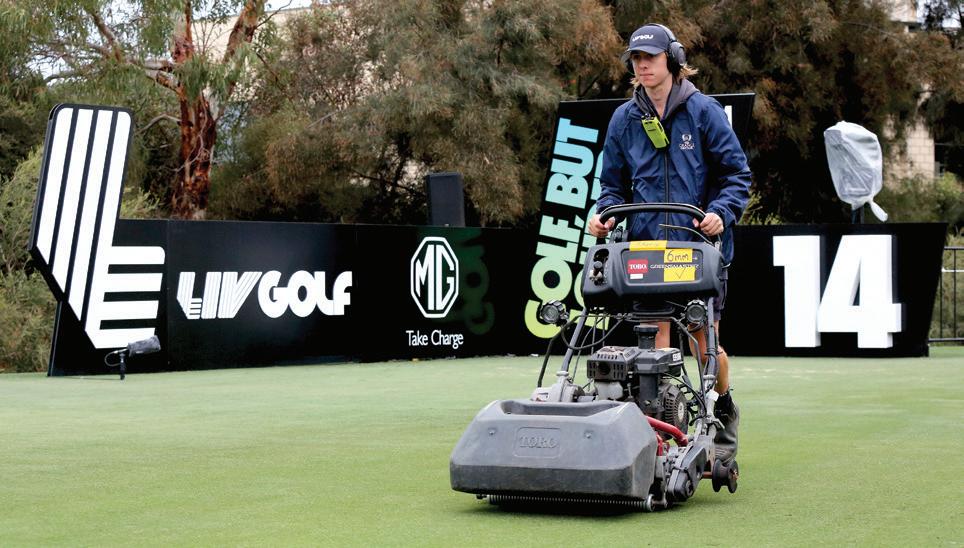
prepped for that big tournament, I was able to see everything at its best (and sometimes its worst) which meant I learnt very quickly.
“The biggest thing for me was that I had to understand what each machine did and how they were meant to be doing it. That’s where Rowan and Jeff (Gillies, assistant superintendent) were extremely good and patient as I got to know how everything worked. The other aspect I really like is the turf side. I didn’t know anything about turf, so learning all the different techniques and the role that each machine plays to present the turf surfaces to the standards which are expected has been really fascinating.”
During the week of the tournament, D’Arcy and Burford-Gost were out on course with the crew each morning making sure that everything was cutting correctly and making adjustments if necessary. They would start with the 2.8mm greens mowers, inspecting each green after their first cuts to make sure there was no disparity in quality and checking the units themselves to make sure they were
straight and that there were no vibrations. They then jumped across to the 6mm mowers (hand mowers and triplexes) and the fairway units. The seven fairway mowers did a pit stop half way through their run, where they were checked and adjusted. They would then do a follow-up check on the greens mowers.
Once the machinery was back in the compound, washed down and filled up, the cutting units were checked again to make sure they were still cutting paper and at their correct heights, along with a check on oil lines and tyres. And, of course, with a decent number of electric units, there was always the obligatory check to make sure that they were charging.
Other companies to provide assistance across the week included Greenway Turf Solutions (lunches, plus water and soft drinks), Waterpro (breakfasts Thursday-Sunday), Living Turf (dinners), Nuturf (Oakley backpacks for all volunteers) and Syngenta (phone chargers). Envu shouted a coffee van (ASAP Coffee) which was on site at 3.30am ahead of preparations getting underway at 4.30am.

MARCH-APRIL 2024 19
Grange crew member Jake Holland took care of the 15mm fairway laps during the tournament
Grange apprentice Casey Clarke cuts the 14th tee
Not that you would know from this photograph, but in the 48 hours leading up to Day 1 of The Star Championships on 6 April, Sydney’s Royal Randwick racecourse copped 235mm of rain

apart Tracks
ATM editor Brett Robinson looks back on very contrasting autumn carnivals for two of Australia’s iconic racecourses – Royal Randwick and Flemington.
It was a day that Royal Randwick track manager Michael Wood says will stay with him for years to come. Wood has witnessed his fair share of major weather events across a near 11-year track career with the Australian Turf Club in Sydney, but few have come close to what he and his team experienced in the lead-up to one of their biggest race days of the year this April.
The Star Championships, which runs at Royal Randwick across two Saturdays every autumn, is one of the most highly anticipated carnivals on the Australian racing calendar. It features no less than eight Group 1 races which carry a total prize purse of $20 million. Day 1 features four Group 1s including the Inglis Sires (1400m), James Squire TJ Smith Stakes (1200m), ATC Australian Derby
(2400m) and the $4 million feature race, The Star Doncaster Mile. Day 2 sees another four Group 1s – The Star Australian Oaks (2400m), Schweppes Sydney Cup (3200m), Queen of the Turf (1600m) and the big one – the $5 million Queen Elizabeth Stakes (2000m).
While every meet that Wood and his team prepare Royal Randwick for throughout the year is important, when you have back-toback Saturdays with star-studded Group 1 fields, there is always that little bit of additional pressure and the hope that everything goes to plan. In the weeks and months leading up to this year’s Championships everything had ticked along as planned, but a few days out from Day 1 things took a turn for the worse which would ultimately put the Royal Randwick track to the ultimate test.
Over a near 48-hour period, from the morning of Thursday 4 April to 6.30am on race day (Saturday 6 April), Sydney’s premier racecourse recorded an incredible 235mm of rain as Australia’s east coast was battered by storms. Some 175mm alone fell on the Friday and with further bursts of rain smashing the track on Saturday morning, some pundits were doubting whether the meet would proceed.
Never in doubt, however, was Wood and sure enough as the skies cleared and the sun shone in time for the first race of the day, the track’s performance would amaze everyone in attendance. Initially rated a Heavy 9 before being upgraded to a Heavy 8 after the fourth race, all 10 races were run without issue, including a dramatic Doncaster Mile which was won by Celestial Legend.
20 AUSTRALIAN TURFGRASS MANAGEMENT 26.2 RACING

“It was certainly a massive day,” reflects Wood, who took over as Royal Randwick track manager in August 2019. “It was very pleasing for the track to bounce back after all that rain and a real credit to my team for all the work they have done over the past couple of years to make improvements so that it can handle these sorts of weather events.
“We knew the rain was coming. We had the Randwick Guineas on 9 March and then we went over to Rosehill for a three week carnival. We were keeping a very close eye on the forecast for the two weeks leading into Day 1 of the Star Championship. They (the forecasters) were pretty adamant we were going to get rainfall from about the Wednesday of that week, with some big numbers being talked about.
“The last bit of irrigation we put out on the track was the Thursday prior to race week. We only put 2mm on to keep a little bit of health in the turf. Apart from that the track had two consolidation rolls and then we were just in a position of drying it down, so by the time the rain did come it was pretty dry. We had also Verti-drained the track about 16 days prior to the meeting, so that obviously helped, and then on the Thursday, just as the rain started, we put out a wetting agent application. Then the rain got heavier and it didn’t stop.”
CATCHMENT CONCERNS
As the rain continued to tumble down on Friday – some bursts saw more than an inch fall in an hour – Wood and assistant track manager Matt Cork would make regular inspections of the racing surface. Despite being wet on top, the track underneath still felt fantastic despite the amount of rain. Wood left the track that night confident that racing would



proceed, especially as the forecast was for the rain to stop early on race day. That confidence, however, was dented a little when he returned to the track in the early hours of Saturday morning.
A 30mm burst in just 20 minutes around 5.30am caused a catchment basin situated between the 1400m and 1200m chutes at the southern end of the property to overflow. The basin not only collects runoff from the track but also a large area of the surrounding Randwick suburb. With such a large volume of rain in a short period, a river of water had spilled over the catchment banks and cascaded across the track around the 1000m mark of the back straight (see photo next page). Also causing concern, although not from a track perspective, the tunnel that runs underneath the main grandstand and connects the track to the Theatre of the Horse mounting yard was shin deep under water.
Wood had seen the catchment overflow on two previous occasions but this was by far the worst, particularly given the timing. On one occasion it had overflowed about two days prior to a race meet which went ahead without issue, but this was the first time it had happened on race day. As if to prove just how much rain had fallen in that 48 hour period in Sydney, the basin had been bone dry on the Thursday.
“When I got in about 5am Saturday the water level in the catchment was about a metre to a metre-and-a-half below the top of the bank,” explains Wood. “That 30mm downpour sent it up and over and across the track and once that happened there wasn’t really much we could do. For instance, we couldn’t just get a SuperSopper out. They’re no good in a race environment because the turf is so long and
MARCH-APRIL 2024 21
Right advice. Right support. Right products. Golf Courses. Councils. Sports Venues. Racecourses. Turfgrass Managers around Australia trust GTS with the health of their soil and turf. For a FREE CONSULTATION, contact your GTS Technical Field Agent. E sales@greenwayturfsolutions.com www.greenwayturfsolutions.com Turf nutrition and protection is just the start with GTS
PHOTO: PAUL MCMILLAN
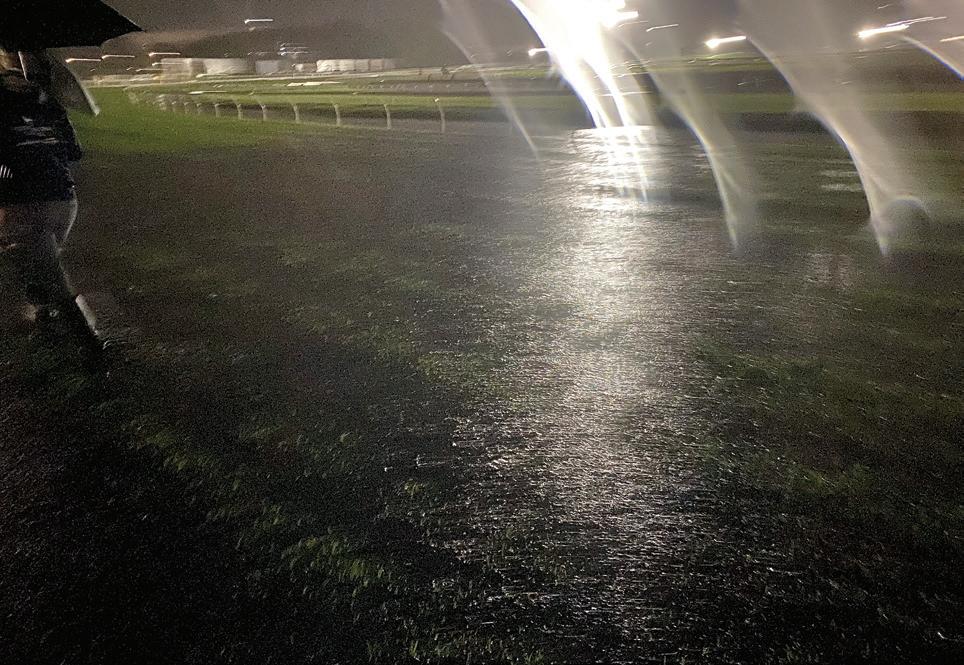
they cause more damage to the ground. It just became a matter of banking on the work that we had done to the track in previous years and hoping that the water would drain quickly.
“When it stopped raining about 6.30am, the water was about five inches deep on top of the ground. We just needed to give it time and once the water stopped coming up and over the catchment it was amazing to see how quickly the water drained away. You could literally see and hear the bubbles of water as it went down through the profile. It went from five inches down to two and then nothing. There was a little bit of squelching under foot, but half an hour later there wasn’t any of that. It worked out really well.”
With the safety of the horses paramount, at around 8.45am, with the track ironically bathed in brilliant sunshine, two horses were galloped over the section of track that had been waterlogged. The jockeys came back unanimously that they could not spot any
inconsistencies and in fact didn’t even notice where the water had been. That was the final tick that Racing NSW stewards needed and the meet could continue as planned, with the track initially rated a Heavy 10 before being upgraded to a Heavy 9 before the first race at 12.25pm.
As they do with every meet, Wood and his team seek feedback from the jockeys and trainers, but after the first race everyone was in wonder at how well the track was performing. Speaking on Racing.com after piloting Espionage to victory in the Group 3 Widden Kindergarten Stakes over 1100m, jockey Tommy Berry was effusive in his praise of the track which he said rode far better than expected. “Incredible,” Berry stated. “Michael Wood and his whole team here at the ATC have done an amazing job.” As if to back that up, the race was run in a solid time of 1:04.42, which according to Wood is only about 1.5s outside of a class record on a Good 3 track.

ULTIMATE PAYOFF
How well the track played was vindication for all the hard work that Wood and his team have undertaken over the past five years to improve the track, in particular its drainage. Indeed, in the aftermath of Day 1, Wood made a post on the Turf Management Australia Facebook page highlighting that exact fact and how proud he was of his team.
“In 2019 we set out with a five year plan to improve the Royal Randwick surface and its ability to handle rainfall – April 6 2024 we received the payoff for the planning and hard work carried out. With 130mm in 12hrs, 173.3mm in the past 24 hours and 235mm in 48 hours plus an overflowed catchment, we were able to produce a safe, consistent and fair surface for racing to shine. So proud to lead our team who have carried out our works and executed so well... Yesterday will stay with me for a long time.”
Continues Wood: “Randwick always had this stigma of being a wet track and it has been something that I’ve wanted to try and break. We set out on a path to get Randwick to try and drain better and that day was certainly vindication of all the work we have put in over the past five years. I still don’t think we are at 100 per cent just yet, but with the work that we have done you can see the improvements.
“We do testing through Ground Science and an audit every year and we can see those gains in the data, but to see it on a race day as well, when it all comes together, that’s even better. I reckon another 2-3 years and we will be really in a great place with the track, but it was really satisfying to see how it handled those challenges on such a big day for the club.”
Despite all the rain, the heavy track and the larger fields which The Championships attract, the kikuyu turf held up remarkably well. Wood was expecting it to chop out more but says the damage was more consistent with a Soft 7 into a Heavy 8 which is where the track finished up midway through the day.
“It coped really well considering the conditions we had,” reflects Wood. “I knew we had ticked all of our boxes from a turf perspective to have it as good as possible, but you still had to be a realist given the rain and the larger fields. But it held together and the racing was the star of the show, especially Celestial Legend winning the Doncaster Mile. There was no real chat about bias. They got off the fence a little bit which I didn’t think they needed to, but overall it was fair, even and they won from all parts which was very pleasing.”
Thankfully for Wood, Day 2 of The Star Championships didn’t have quite the dramatic lead-in and the dry conditions which greeted racegoers on the morning of Day 1 persisted throughout much of the next seven days. Despite a further 11.3mm on the Tuesday,
22 AUSTRALIAN TURFGRASS MANAGEMENT 26.2
RACING
PHOTO: PAUL MCMILLAN
Despite all the rain, the Royal Randwick track performed amazingly well, vindicating the efforts of Wood and his team to improve its drainage over a number of years
This photo of the Randwick track near the 1000m mark was taken at 6.18am on race day. The nearby catchment basin had overflowed, sending water spilling across the track and causing concerns over its safety
some fine weather meant the track continued to slowly dry down and was rated a Soft 5 ahead of the first race on Day 2 before being upgraded to a Good 4 following the third race. The rail was moved out to four metres from the 1400m mark to the Winning Post, with the remainder of the track at 3m. The initial plan was to be 3m across the entire track, but with the bigger fields on Day 1 the horses did edge off the fence around the 500m-400m mark, so having the rail at the 4m position put them onto a good pad of fresh grass.
The conditions were certainly perfect for the main event – the Queen Elizabeth Stakes – which is run over 2000m. In one of the more remarkable races ever seen at Royal Randwick, mare Pride of Jenni left the field for dead, leading from the jump and at one point having a lead of 30 lengths heading into the straight before winning by seven. It was a fitting finish to The Star Championships and one that Wood and his track crew will remember for a long time.
A DRY RUN
While it was a deluge that gave Wood all sorts of challenges, it was a distinct lack of the wet stuff that would provide a different kind of headache for his Flemington counterpart Liam O’Keeffe. A week before the Randwick

soaking, on Easter Saturday the Victoria Racing Club wrapped up its Flemington Racing Spectacular, a series of four Group 1 meetings which the iconic Melbourne track hosted across four Saturdays starting back in mid-February.
The meets included Black Caviar Lightning Day (17 February), Australian Guineas Day (2 March), Super Saturday (9 March) and TAB Australian Cup Day (30 March). More than 36,500 punters attended across the
four meetings which featured $11 million in prizemoney. Over 9700 attended the final day which saw nine-year-old galloper Cascadian make it back-to-back wins in the $3 million Group 1 TAB Australian Cup held over 2000m, beating Pride of Jenni to the line.
What made things particularly challenging for O’Keeffe and his track crew was that the six-week period over which the Flemington Racing Spectacular was conducted coincided with one of Melbourne’s driest spells on

MARCH-APRIL 2024 23
PHOTO: PAUL MCMILLAN
Members of the Royal Randwick track team tend to the kikuyu turf in between races

record. The Victorian capital notched up its driest March in 170 years, with the Bureau of Meteorology’s official Melbourne station at Olympic Park registering just 2.8mm for the month (the long-term March average is around 50mm). That came on the back of a very dry February where there was only 6.8mm recorded. For O’Keeffe, that placed a premium on irrigation regimes to ensure the Flemington track stayed within the Good 4-Good 3 range each race day, with the Super Saturday meet particularly challenging as temperatures soared.
“Across late summer and start of autumn we experienced the driest February/March period on record,” reflects O’Keeffe, who arrived at Flemington from Warrnambool in 2013 as an assistant before taking the reins in February 2018. “This made track preparation challenging but we were very pleased with how it performed across each of the Group 1 race meetings. Keeping moisture in the cool-season turf on warm race days is a fine balance between overwatering and affecting track
performance and also having some moisture in the track at the end of a long race day when temperatures often reach the mid-30s.
“For the opening Black Caviar Lightning meet, the rail was in its true position and we had a nice fresh cover of grass on the inside as the track hadn’t been raced on for about four weeks. The track had recovered well from our mid-January meeting and we had good growing conditions.
It was quite hot leading into the Black Caviar meet which meant we put out around 70mm of irrigation that week which had it presenting a Good 4. Conditions were very tricky across the Sunday, Monday and Tuesday with strong northerly winds making watering difficult, but we were able to play catch up after that and kept the track ticking over leading into race day. Thankfully it cooled down and was 24 degrees that Saturday which was perfect.”
After holding the 10-race Australian Guineas Day on 2 March in mild conditions, the following week’s Super Saturday was held on what would be Melbourne’s second hottest

day of the season. With temperatures nudging 39 degrees, the VRC enacted its hot weather policy, dropping two races off the card (from 10 down to eight) and bringing forward the start time (the first race was at 10.45am) to beat the heat later in the afternoon.
“We had the hot weather policy in place which involved all the misting systems, fans, hoses, sprinklers and buckets of ice being on hand so that when the horses returned to the Mounting Yard they could cool down straight away,” explains O’Keeffe. “From a track perspective, something we wanted to avoid was having it too firm early. When you have a hot day the track dries out a lot more and conditions can become real firm for those racing later in the day.”
The feature race of Super Saturday – the $1.5 million Yulong Newmarket Handicap over 1200m – saw Jamie Kah pilot Cylinder to an emotionally-charged victory, making it back-toback Newmarket victories for the Godolphin stable. In the corresponding race last year, Kah was due to have ridden the eventual race winner In Secret, but a fall in the earlier VRC Sires’ Produce Stakes saw her hospitalised with concussion and other injuries. Jockey Dean Holland would ultimately jump on board In Secret and guide her to victory, but would tragically die a month later following a fall at a race meet in Donald, Victoria. In a fitting tribute, Kah claimed the inaugural Dean Holland Trophy which was struck in his honour and is now awarded to the winning Newmarket Handicap jockey each year.
Immediately after TAB Australian Cup Day, O’Keeffe and his team undertook a mini-renovation of the Course Proper ahead of hosting its ANZAC Day race meet. The renovation involved mowing the track down to 75mm, topdressing with 3mm of sand, oversowing with a perennial ryegrass/Kentucky bluegrass mix at 200kg/ha and a final Vertidrain. Just a few days after the renovation, the track received 67mm of rain over a 36-hour period. The rain couldn’t have been timed better and helped to flush any salts accumulated in the profile from the summer and also freshened up the track as it recovered from renovations.
After its ANZAC Day meet, which was headlined by the Listed VRC St Leger (2800m) for three-year-olds, a race older than the Lexus Melbourne Cup, Flemington has five more race days to round off its 2023-2024 season. They include the Andrew Ramsden Race Day (18 May), VRC Community Race Day (8 June), VRC Country Race Day (22 June), Flemington Finals Race Day (6 July) and VRC Members Race Day on 20 July which signals the close of the season.
24 AUSTRALIAN TURFGRASS MANAGEMENT 26.2 RACING
Jamie Kah steers Cylinder to win the Yulong Newmarket Handicap at Flemington as part of the Super Saturday meet on 9 March
PHOTO: VRC/RACING PHOTOS
Battling the driest March in Melbourne for 170 years, track manager Liam O’Keeffe had to ensure his irrigation practices were spot on throughout the four-meet Flemington Racing Spectacular


Caulfield Heath
right on track
Assistant track manager Sam Bennetts looks back at the recent construction and opening of Caulfield Racecourse’s new Heath track which forms part of a major Melbourne Racing Club master plan to improve the iconic racing facility.
RACING
PHOTOS: MELBOURNE RACING CLUB
The new Caulfield Heath track held its first race meet on 13 March. The track is 1870 metres lo, 210m less than Caulfield’s Course Proper, and 28m wide
Caulfield Racecourse is located eight kilometres southeast of Melbourne’s CBD and began life after the establishment of the Victorian Amateur Turf Club (known as the Melbourne Racing Club since 2002), hosting its first meeting on 5 August 1876. The Melbourne Racing Club (MRC) also owns and operates Sportsbet Sandown Racecourse and Mornington Racecourse in addition to 14 licensed hotels and club venues.
Caulfield Racecourse hosts 24 meets annually, with notable Group 1 races including the famous Caulfield Cup run over 2400 metres in mid-October, the Caulfield Guineas (1600m), Thousand Guineas (1600m), C.F Orr Stakes (1400m) and Blue Diamond Stakes (1200m). The Course Proper is 2080m in circumference, 30m wide and has a 367m-long straight with 1200m, 1400m and 1700m chutes. Uniquely, it also has an ‘outer loop’ off the main circuit which enables the running of 1800m and 2000m distance starts. The surface consists of perennial ryegrass and Kentucky bluegrass on a loamy sand profile.
Preparing a racing surface is quite unique in the turf sector as the track is maintained between 4”-5” (100mm-125mm) by three John Deere 1580 ride-on rotary cut mowers equipped with vacuum systems to catch clippings. This is done to reduce organic matter build up, remove Poa annua seed head and reduce the spread of seed, limit the spread of any disease and clean up debris from the surface after a race event.
The cool-season turf’s irrigation requirements also differ greatly. At Caulfield we have a state-of-the-art Toro Lynx decoder system equipped with Toro 690, Infinity and Perrot VP3 heads which assists the Upton selfdrive boom irrigation systems.

Both methods are required for premium turf health, although the boom irrigation system’s uniformity provides even watering from inside rail to outside which in turn negates dry patches and the development of any perceived bias. Monthly up-front granular fertiliser applications are scheduled around the racing calendar, backed up by a liquid program that optimally services plant health and soil microorganisms.
LOOKING TO THE FUTURE
As the Course Proper has served Melbourne with premier racing for over 100 years, the MRC received feedback suggesting there was an appetite to host more racing events at Caulfield. In response to that, in 2019 the MRC developed a master plan – a $300 million vision to help guide and inform future development activities and ensure the continued success of the venue for generations to come.
Under the master plan, a complete repositioning and redevelopment of the venue was undertaken to further cement Caulfield as a world class racing, event and recreational destination for members, participants and guests. The key changes outlined included:
l Increase racing at Caulfield through the implementation of an inner ‘Caulfield Heath’ track;
l New centralised horse stalls and mounting yard to offer greater patron access and viewing, as well as state-of-the-art facilities for equine and human athletes; and
l Redevelopment of the grandstand and participant zones and a revitalised entry experience.
To realise the master plan, many obstacles had to be overcome. Arguably, the biggest was the relocation of horse training and stabling to provide a footprint for delivery of the new Caulfield Heath track and increase future racing activities at the venue. The existing
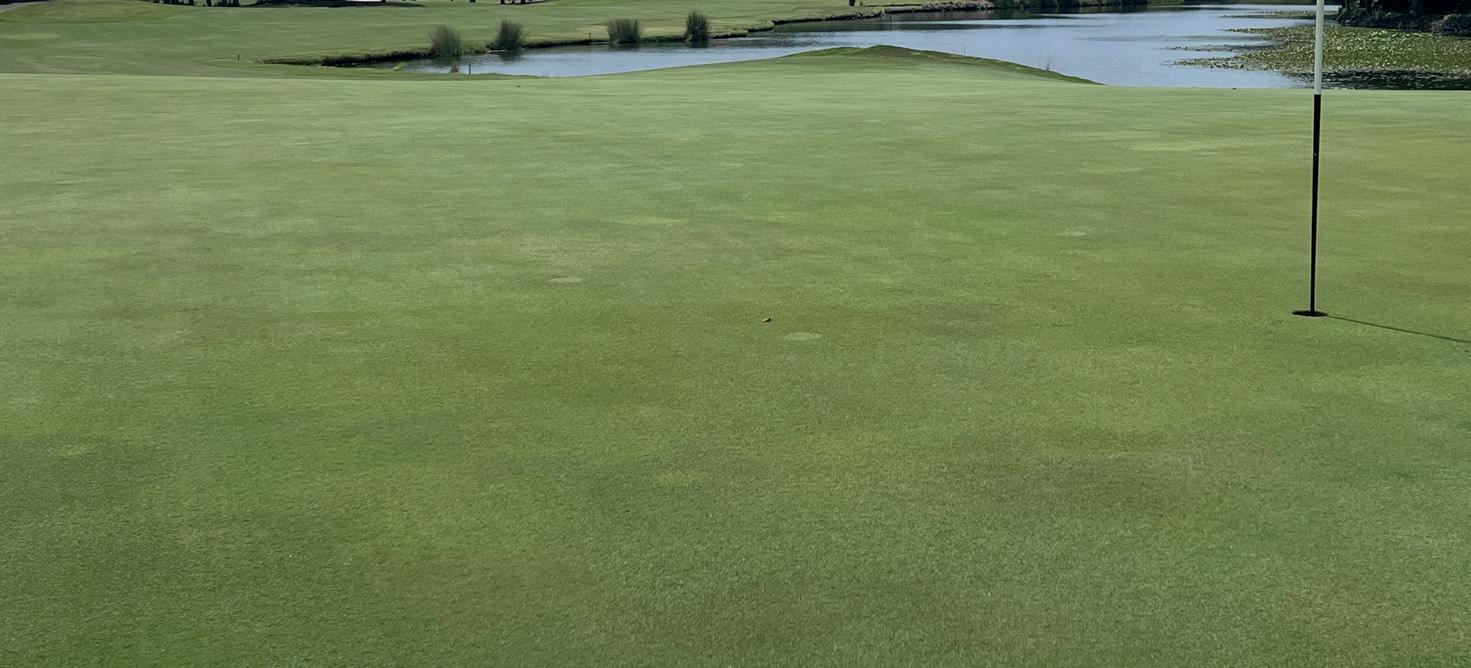
Worried about Stem Weevils, Armyworms, Webworms and Cutworms over summer?
You need a strong two-pronged approach with industry leading Quali-Pro Twister!
Quali-Pro Twister – two active ingredients, strong residual, great resistance management tool.
One powerful, quick-acting contact (indoxacarb) coupled with a chitin inhibitor (novaluron) to prevent stem weevils moulting to later instars, and abnormal pupal formation in caterpillars. Excellent control of Stem Weevils and caterpillars in one bottle!

MARCH-APRIL 2024 27
FRASER DOUGLAS/MRC
PHOTO:
MRC’s general manager of racecourses Jason Kerr (left) with Caulfield assistant track manager Sam Bennetts (middle) and foreman Jim McElgunn (right). Racecourse manager Tim Bailey is absent.



training facilities were located on the inside of the Course Proper and consisted of a 2005m x 5m sand track, a 1900m x 18m Steeple turf track, a 1700m x 9m Poly track (a combination of crumbed rubber, shredded carpet fibre and sand), an inside turf track (1400m x 4m) and a lead sand track (1500m x 6m).
The decision to relocate 500-odd horses and 15 trainers was something that was not taken lightly. After months of planning, fierce debate and compensation, an agreement was reached between the MRC and trainers. In 2021, Caulfield Racecourse ceased as a training complex, bringing an end to the rich history of world class horses trained at the venue. At full capacity, 550 horses were stabled and training at Caulfield and over its history the venue produced a number of Australian Racehorse of the Year winners, among them Weekend Hussler, Typhoon Tracy, Dissident, Lankan Rupee and champion mare Black Caviar who won the prestigious award across three consecutive years (2011-2013).
Once the agreement between the club and the trainers was finalised, plans
for the redevelopment of the area could begin. Consultation between the MRC and Caulfield Reserve Trust (the independent body appointed by the Victorian Minister for Environment to manage the reserve) started. The Trust is responsible for the operation and use of the reserve for purposes of racing, recreation and public park in accordance with the Caulfield Racecourse Reserve Act 2017. With this in mind, the majority of where the training facility was was remediated for public use, while the footprint required for the Caulfield Heath track was confirmed.
ONE TRACK OR TWO?
Now that the proposed area was available, the MRC had to decide which model would be most beneficial to serve the racing public and participants for the next 100-plus years.
The traditional ‘two track’ model is the most common in Australia and can be seen at venues such as Royal Randwick (Sydney), Morphettville (Adelaide) and Newcastle. The positives of a two track model include being able to schedule different irrigation cycles to
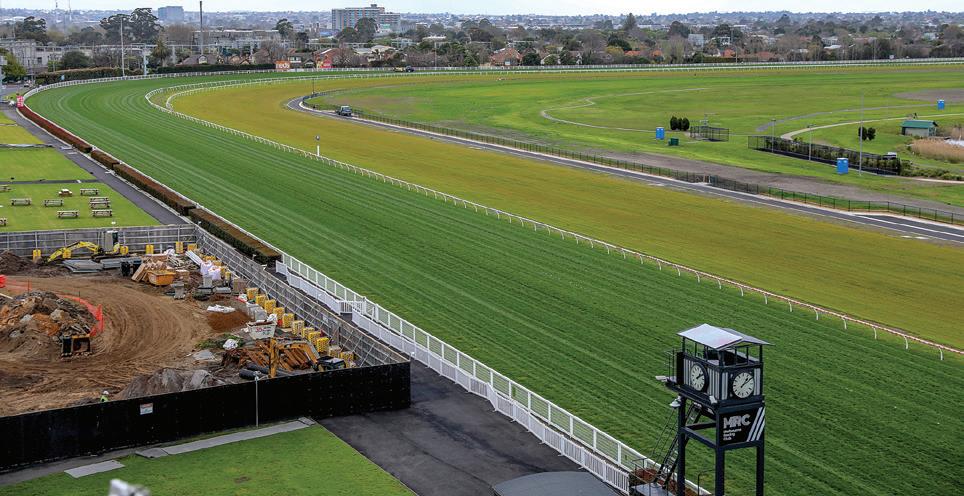
suit individual tracks in preparation for race programs and the ability to better manage and mitigate track wear. Turf selection could be varied for the multiple surfaces, allowing for warm-season and cool-season surfaces that could cater to the varying weather conditions. Rail movements would be less labour-intensive and accessibility to the track for maintenance purposes would be greatly increased as service vehicles would have access on both sides. It would also fully protect the Course Proper as it stood, which would maintain existing industry confidence in the surface. Additionally, it would also futureproof against irrigation system failure or turf issues, with meetings able to be interchanged between tracks if needed.
The opposing ‘one track’ model would see a racing surface 55m wide from inside rail to outside. The benefit would be a full replacement of the existing racing site, a consistent camber and levels for the entirety of the track and flexibility of rail and barrier positions that could enable a range of new distance races that could be run. This model would involve a complete rebuild of the racing surface, thus compromising the positive sentiment of the existing Course Proper.
The sheer width of the one track model would also cause difficulty with irrigation. New boom irrigators would need to be manufactured to cover the span of the track, which would in turn cause the machine to weigh a lot more than current models. Additionally, where this machinery would operate would interfere with race placement. A surface this wide would also be hard to water with in-ground irrigation as uniformity and accuracy would be compromised. Having a
28 AUSTRALIAN TURFGRASS MANAGEMENT 26.2 RACING
PHOTOS: NEARMAP
Caulfield Racecourse before (left – October 2021), during (middle – January 2023) and after (right – March 2024) the construction of the new Heath inner track
After the last roll of six hectares of turf was laid, the inner Heath track was left to establish for 10 months
wide track would enable jockeys to pick any path, which could lead to incidental wear in future rail positions, something that wouldn’t be the case with a two track model.
After weighing up all the pros and cons, ultimately the MRC opted for the two track model, although it wasn’t universally supported throughout the racing industry. The challenge was then to change the hearts and minds of the opposing camp, with the only surefire way to do this by ensuring industry standard construction techniques, consistent testing of materials before and after installation and appointing market leaders in the construction and design industries.
The construction tender was awarded to civil firm Simpson Construction, with turf and soil profile consultation provided by STRI Australia. The MRC benefited from its highly experienced property and projects team, headed by James Hawkins, which drew on their knowledge and expertise to ensure not only the Caulfield Heath track was completed to specifications and in a timely manner but the master plan as a whole. Other aspects of the redevelopment included the rebuild of the race day stalls, mounting yard and a new administration building.
Another of the club’s great assets is the racing department, led by Jake Norton, and the racecourse management team consisting of Jason Kerr (general manager of racecourses) and Tim Bailey (Caulfield Racecourse manager). Between them they have over 60 years of racecourse maintenance experience at the likes of Caulfield, Sandown, Mornington and Geelong tracks. It’s safe to say that over that span of time, racecourse maintenance has changed dramatically and they have been at the forefront of that evolution.

HEATH CONSTRUCTION
Calling upon on their combined expertise, Jason and Tim were able to implement strategies to enable the new build to race consistently while also ensuring premium turf health. Some of these strategies were to provide a racing surface that emulated the Course Proper and which was capable of as many of the same distance starts. This enables both Course Proper and Caulfield Heath race days to be interchangeable with minimal disruption to the race programming and also helps to provide participants with the same level of comfort and feel as the Course Proper.
To achieve this, the 1200m chute of the Caulfield Heath rack was positioned next to the Course Proper 1200m chute (see bottom right of far right aerial shot on opposite page) , providing the same feel as the Course Proper without condensing the wear pattern over

the same area. Also, the 1600m and 1800m distance starts begin on the Course Proper and transition onto the Caulfield Heath circuit. To ensure these transitions were as seamless as possible, sections of the Course Proper needed to be relevelled.
The next initiative was to install a 1m rise from the 400m mark to the Winning Post to negate bias and give every horse an opportunity to make ground. The turning radius is 140m, whereas the Course Proper is 141m and the home turn camber is identical at four per cent. The length of the Caulfield Heath track is 1870m (210m less than the Course Proper) and 28m wide (2m less than the Course Proper). Interestingly, the new track’s front straight is 6m longer than the Course Proper at 308m.
The Caulfield Heath was constructed on the natural compacted clay base, with
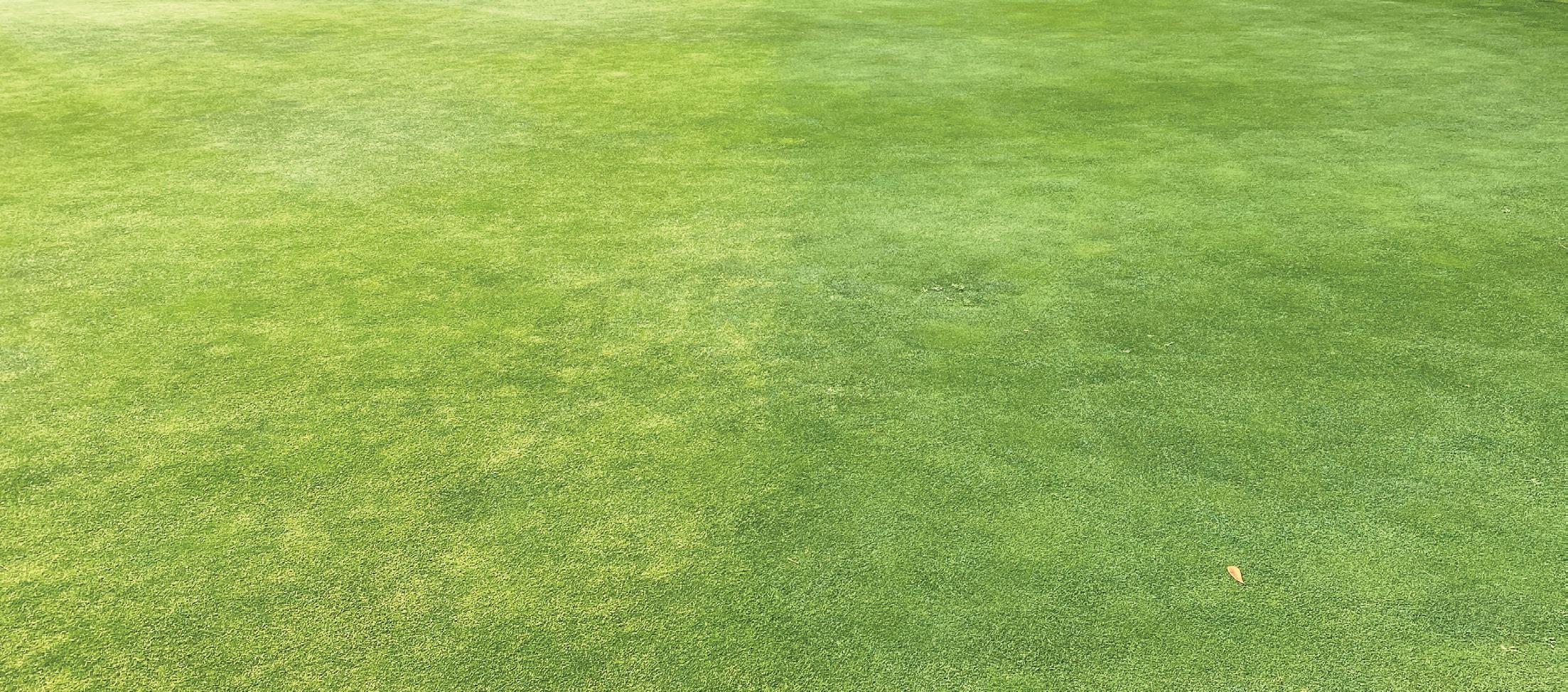

MARCH-APRIL 2024 29
Other aspects of the recent redevelopment included the rebuild of the race day stalls and mounting yard
®
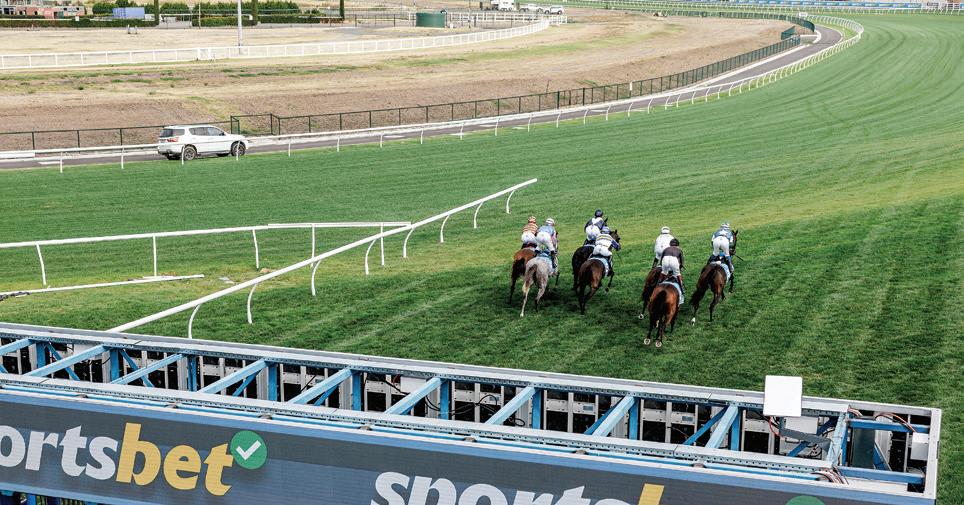
the same 4-7mm blue metal aggregate 100mm-deep drainage layer as the Course Proper. Lateral agricultural slotted pipe drainage was installed every 5m running at 45-degree angles. The rootzone was installed in two 150mm layers to ensure consolidation of soil profile. The profile consists of sub-angular to sub-rounded loamy sand that adheres to USGA specifications for profile construction.
While the nuts and bolts of the build mimicked the Course Proper, procurement of perennial ryegrass in the quantity and with the maturity required proved very difficult. The decision was made to install warm-season male sterile kikuyu grass (supplied by Anco Turf) in turf rolls to act as a stabilising base and give the track its best chance to establish. This decision enables the flexibility to transition the Caulfield Heath track into a cool-season track in the future by overseeding.
As part of the master plan, both the Course Proper and Caulfield Heath benefited with the installation of a brand new Toro Lynx irrigation system, including Toro 690, Infinity and VP3 Perrot heads in addition to a new Grundfos pumpstation installed by Think Water. This installation gives the ability to irrigate both surfaces simultaneously without disruption.
Construction of the Heath track began after the Group 2 Zipping Classic in November 2022 with the Melbourne Racing Club required
to fulfil its racing obligations. This meant all scheduled Caulfield race meetings were transferred to Sandown Racecourse where track manager Greg Groves and his team prepared for 39 metropolitan race meetings over the following eight months.
Areas of the Course Proper that were reconditioned to allow for transitions to the Caulfield Heath were given that time to grow in before racing recommenced. During this lay off, the remaining areas of the Course Proper were given a well-earned rest and renovation with a lot of focus on organic matter removal and Poa annua control.
The last roll of Caulfield Heath turf was laid in April 2023 (turfing comprised a total of six hectares) and the track given the following 10 months to establish. During this time constant testing of the surface was conducted and a rigorous upfront granular and liquid fertiliser program implemented. This was backed up by monthly preventative mite, insect and disease applications.
OFF AND RACING
Once the racecourse management team was comfortable with the state of the new surface, feedback and approval from officials, participants and stakeholders was required before racing could start. This came firstly in the form of track gallops, where jockeys could

ride the entire circuit at their own pace to gain a feel of how the track performed. That was followed by jump outs, where jockeys and horses could experience the surface from the starting barriers without the intensity of race day conditions. After that, official trials, governed by Racing Victoria, were held which simulated race conditions as close as possible.
The MRC gained feedback at every stage of the process to ensure compliance but also enact any recommendations from participants. The club performed as much due diligence to ensure buy-in from the racing industry which enabled the first race meeting on the Caulfield Heath to be held with full confidence a full month ahead of schedule.
On 13 March 2024, the MRC officially opened the new Caulfield Heath track along with the brand new subterrain race day stalls, jockey facilities and mounting yard. The surface, which was rated a Good 4 for the entire eight-race card, was embraced by participants and performed positively with the running rail in the true position. The most pleasing aspect was how well the turf handled the day’s racing which featured 68 horses, with damage minimal despite 5mm of rain falling that morning.
After that meet repair was minimal, consisting of sweeping loose debris with a Toro Rake-o-vac and very light soil replacement of divots around the home turn. The Caulfield Heath raced again on 17 April 2024 with the running rail remaining in the true position. Identical to the first meeting, 68 horses took part over eight races with the surface performing just as well, with the same level of repair required in the aftermath.
Those two race meetings were Caulfield Health’s last of the 2023/2024 racing calendar with the MRC allowing the surface to recover and consolidate further over the cooler months. Although the racing schedule has yet to be confirmed by Racing Victoria, Caulfield Heath should resume racing in the latter part of 2024.
During this hiatus, the Caulfield Heath will receive a height of cut reset, solid and hollow tine aeration and light topdressing. This will aid in turf and soil profile water and air movement while also allowing greater nutrient uptake. One of the benefits of the warm-season kikuyu is the ability to apply pre-emergent herbicides to negate the effects of Poa annua. The aim for this period is to ensure the plant has all the required nutrients before entering dormancy which will provide greater plant health during the cooler months. It will also assist the ability of the turf to bounce out of dormancy once temperatures begin to increase.
The new Heath track surface, which rated a Good 4 for its first meet, was embraced by participants and performed positively with minimal damage
30 AUSTRALIAN TURFGRASS MANAGEMENT 26.2 RACING
Having two tracks enables the MRC to feature more race days and provides greater flexibility with programming








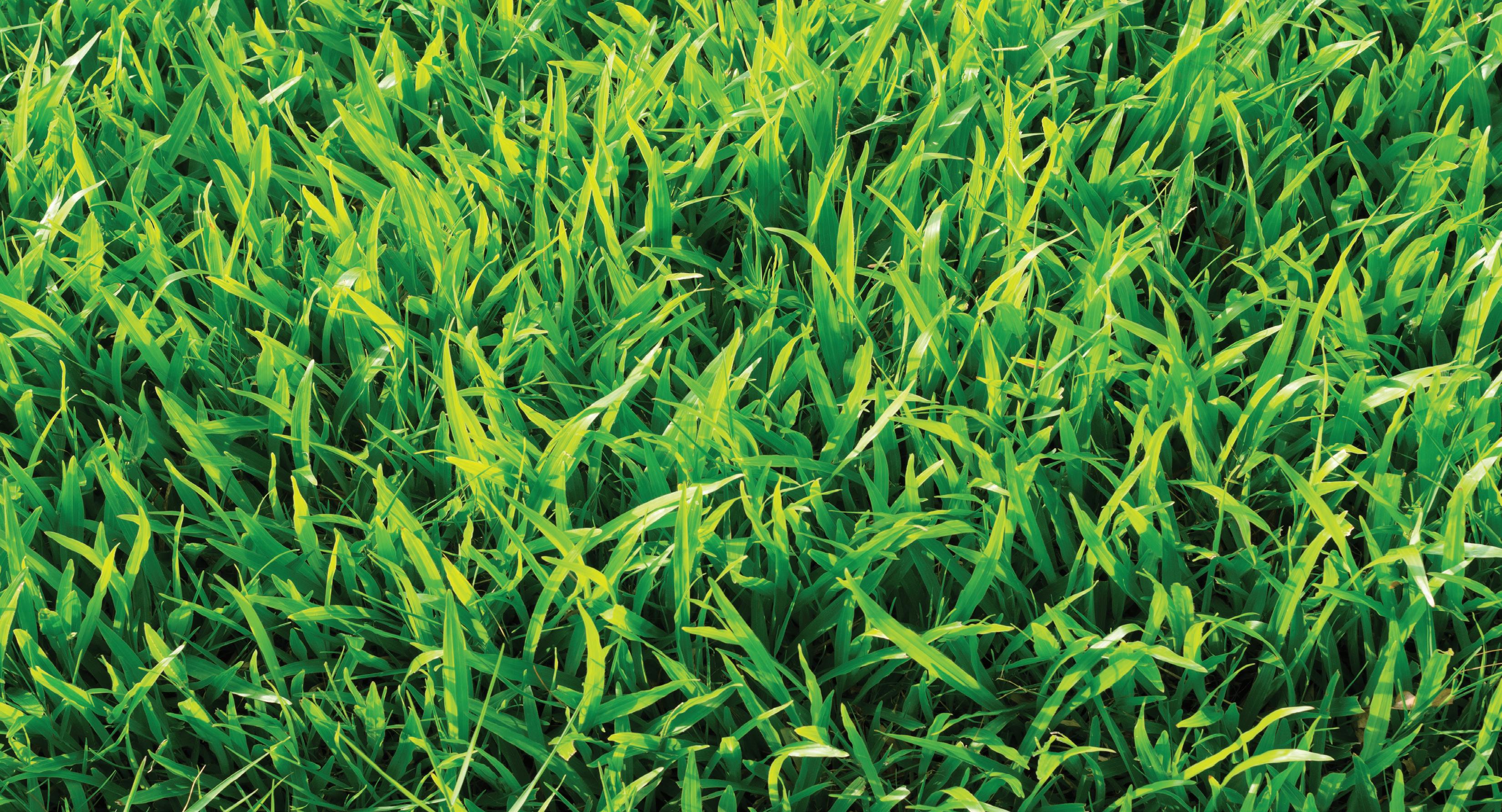
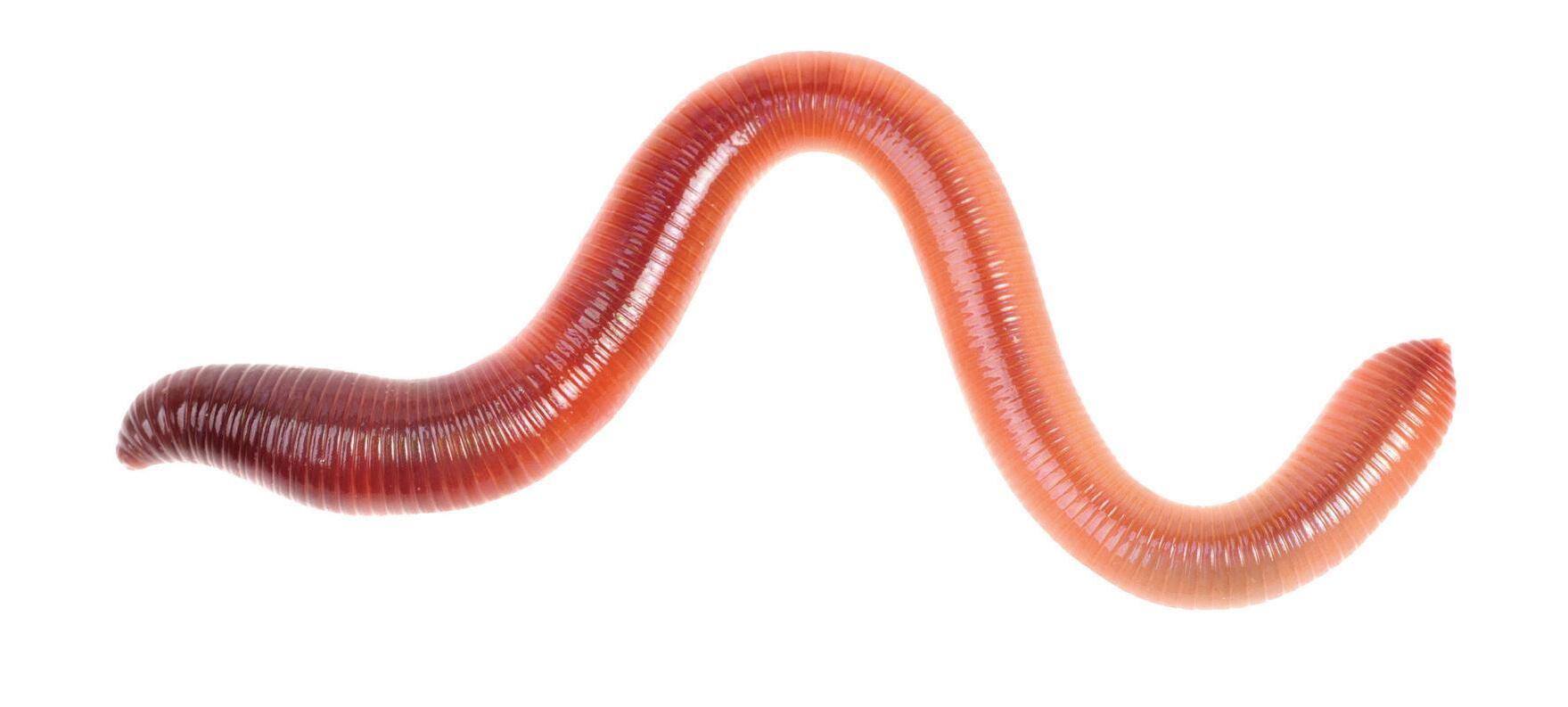





A wealth of

knowledge
The latest instalment of the Jacobsen-sponsored Future Turf Managers’ Initiative concluded in Melbourne in mid-March, with the 2023-2024 group converging for an intensive three-day workshop. It is now the eighth year that Gold Partner Jacobsen has run the program in conjunction with the Australian Sports Turf Managers Association (ASTMA), with around 175 up-and-coming turf managers having benefited from the sessions and presentations which aim to equip them with the necessary skills to progress their careers.
It was last October when the ASTMA and Jacobsen confirmed the 21 successful applicants for the latest intake, with application numbers up by more than 20 per cent on the previous year. Pleasingly, among this year’s group were two female sports turf managers – Jayde Robson (City of Ballarat) and Tahlia Bruce (Golf Central Brisbane) – as well as three NZGCSA members who made the journey from across the Tasman (see the full cohort list right)
FTMI CLASS OF 2023-2024
Tahlia Bruce (Golf Central Brisbane, Qld); Jordan Burgess (Royal Wellington GC, NZ); Jeremy Collier (City of Ballarat, Vic); Luke Cooney (Melbourne Grammar, Vic); Joel Crimmins (Melbourne Grammar, Vic); Andrew Dalby (St Kevin’s College, Vic); Nicholas Fiddelaers (Green Acres GC, Vic); Matthew Forder (The Sands, Torquay, Vic); Tim Hamilton (Kingston Heath, Vic); Nick Harris (Sanctuary Cove G&CC, Qld); Liam Hewitson (St Clair GC, NZ); Brayden Luc (Avondale GC, NSW); Tim Moore (Devonport CC, Tas); Jackson Nicholls (The Lakes GC, NSW); Dominic Pelusi (The Gabba, Qld); Jayde Robson (City of Ballarat, Vic); Nick Skicko (Metropolitan GC, Vic); Kurt Thiele (Cape Kidnappers, NZ); Ryan Thompson (Latrobe Golf Club, Vic); Cody Tucker (Metropolitan Golf Club, Vic); Issac Wojewodka (Camden GC, NSW). Mentors: Liam Ash (State Wide Turf Services); Brenton Clarke (Settler’s Run G&CC); Sam Davis (Queenstown GC NZ); Matthew Oliver (Suncorp Stadium).

As part of the FTMI, the cohort is split into four groups with each assigned a mentor. The mentors, many of whom are past FTMI graduates themselves, help to guide the groups though the respective online and face-to-face sessions, providing their insights and experiences along the way. Returning as mentors this year were Liam Ash (State Wide Turf Services, NSW), Brenton Clarke (superintendent, Settler’s Run, Vic) and Sam Davis (superintendent, Queenstown GC, NZ), with Suncorp Stadium ground manager Matthew Oliver a welcome inclusion to the mentoring team for the first time.
The FTMI sessions kicked off last November with a series of online sessions that ran throughout the summer months before culminating in the Melbourne gathering. The online sessions covered a range of topics including career planning, leadership and management. They were supplemented by smaller breakout meetings where each group was able to discuss content from the previous sessions and work together on set tasks that had been assigned. These smaller meetings
32 AUSTRALIAN TURFGRASS MANAGEMENT 26.2 FTMI
The
emerging industry leaders completed the Future Turf
in March.
latest batch of
Managers’ Initiative program
PHOTOS: BRETT ROBINSON
Golf Central Brisbane’s Tahlia Bruce was one of two female sports turf managers as part of this year’s FTMI program
also provided the opportunity to workshop some of the ideas raised in general sessions with their mentors.
The face-to-face gathering kicked off with a welcome dinner which featured special guest Brooke Hanson. The former champion Olympic swimmer reprised her much-talked about presentation at last year’s Adelaide conference on resilience and having a positive mindset. That was followed on Monday and Tuesday by a range of presentations from leading figures, among them leadership and behaviour expert Mark Carter, Carmen Sederino (Illuminated Story), ASTMA chief executive Mark Unwin, Karen Proctor and Peter Schumacher (both Jacobsen). For the first time, this year’s program also featured Ben Gibson from The Toolbox Team who spoke on building a personal brand and how to leverage social media to do so. Across the three days, topics ranged from presentation skills to CV writing and job applications, understanding maintenance budgets, the importance of workplace diversity, personal branding and how to develop a good workplace culture.
“The FTMI is such a great program, providing the emerging and future leaders of the turf industry invaluable education opportunities,” says Unwin. “In addition to the networking and shared learning, the ability to gain insights from experienced mentors and industry experts is what sets this program apart and what sets up those who have been part of it for future success in their careers.
“It’s no surprise that nearly 70 per cent of all turf managers who undertake the FTMI program have gone on to be promoted to leadership or senior roles in the industry. A big part of that is thanks to the continued support provided by Jacobsen to make this opportunity available to the Australian and New Zealand turf industry. As part of the program, all FTMI delegates will remain in touch and have committed to a series of goals that they will work upon with mentor support. We congratulate this year’s graduates and trust that they took away plenty from the program.”

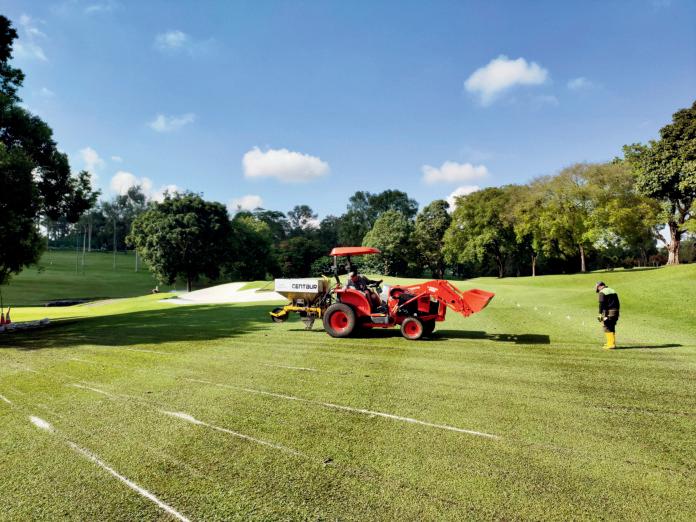

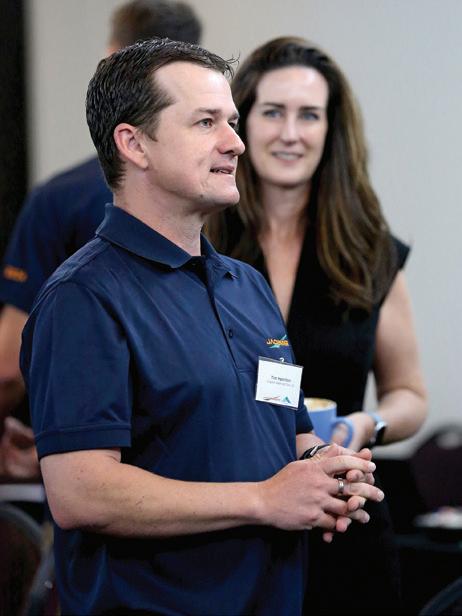
For one FTMI participant, Matthew Forder, this year’s program had an almost immediate impact. Originally hailing from England, since taking his first steps in golf course turf management in 2012 Forder has taken full advantage of the global opportunities that the industry can offer those willing to put themselves out there. After getting his qualifications at home, including being awarded Intermediate Apprentice of the Year at Myerscough College and a finalist in the Toro Greenkeeper of the Year Award, he then embarked on an 18-month internship through The Ohio Program.
After working at the likes of Pine Valley and Erin Hills, which hosted the 2017 US Open, he then headed to New Zealand for a stint at Jacks Point in Queenstown. Journeying back north again, he took on a role at Trump International Golf Links in Ireland before coming back Down Under and landing at Kingston Heath Golf Club. After a short period there he ventured down to the Bellarine Peninsula in Victoria, initially working for OCM
Golf during the Lonsdale Links redevelopment before moving into his most recent role as assistant at The Sands, Torquay under Keenan Hobbs.
Prior to the Melbourne FTMI gathering, Forder had applied for the assistant superintendent role at Trump International Golf Club – Dubai, a 27-hole state-of-the-artfacility designed by course architect Gil Hanse. Following significant capital investment in 2023, the club recently illuminated the back nine of its championship course to allow for night golf, alongside its already floodlit par three course. The role called for someone to spend a large part of their time supervising and training the club’s golf course maintenance team which numbers 60 staff and contractors, many of whom don’t speak English as a first language.
As chance would have it, just ahead of the FTMI gathering Forder was informed that he had secured a job interview. On the very same day that he was to have the interview, the FTMI schedule had a session on CVs,

MARCH-APRIL 2024 33
Melbourne Grammar’s Joel Crimmins was one of two groundsmen from the school to take part in this year’s FTMI program
wet areas? Hydrowick drainage system is the solution. www.centaur-asiapacific.com.au Playable the same day No other drainage method compares Efficient and effective drainage installed with minimal disruption See it in action
Jacobsen’s Karen Proctor watches on as Kingston Heath assistant Tim Hamilton undertakes one of the presentation skills exercises
Problem
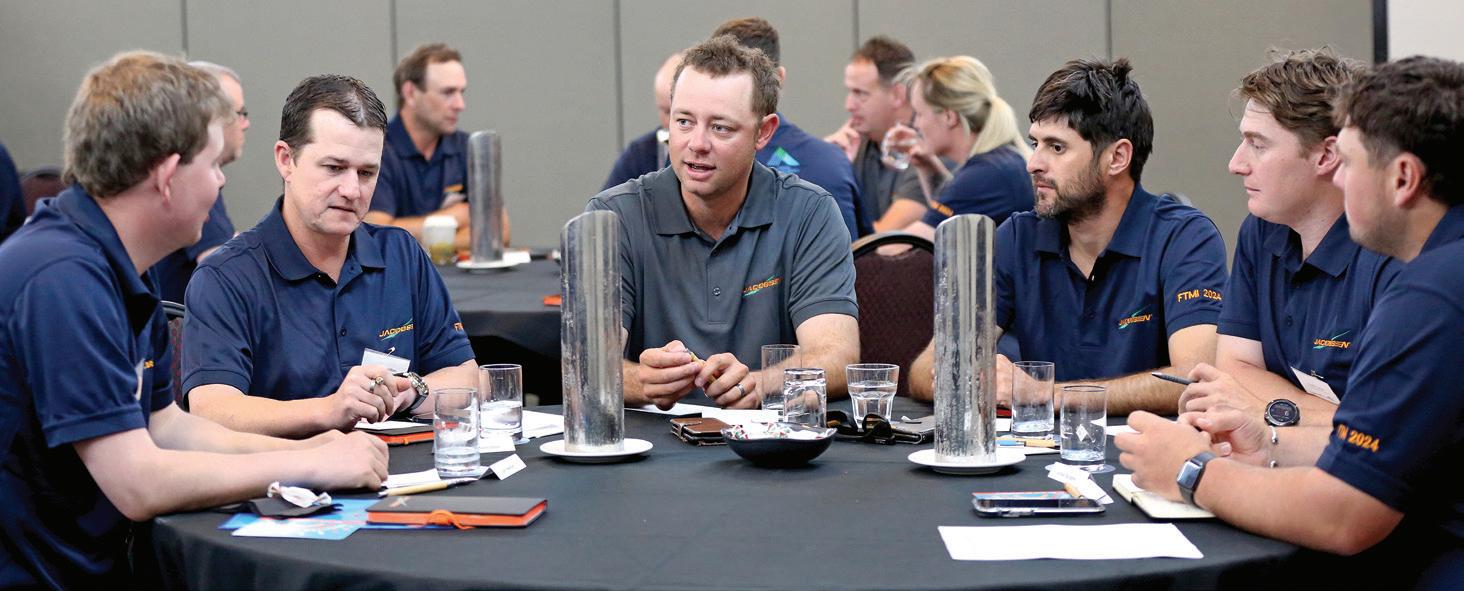
resume writing and job interview techniques, with Forder able to put into practice some of the tips and tricks that were discussed. The interview was held later that evening and in the days that followed Forder was informed that he had been successful!
Together with his wife, who has managed to secure a teaching job in Dubai, Forder will start his new role in May. There he will connect with and work under ex-pat Australian turf manager Simon Winzar who has been at Trump International for the past seven years. Formerly of Lakelands Golf Club on the Gold Coast, Winzar is a past GCSAQ Graduate of the Year Award winner and was a finalist in the ASTMA Graduate of the Year Award in 2014. He arrived at Trump International Dubai as the senior assistant superintendent in May 2017 before taking over the director of agronomy role in July 2021.
At the conclusion of this year’s FTMI, Australian Turfgrass Management Journal asked some of the graduates for their feedback on the program, some of the key messages they took away from the various sessions and which areas they have committed to continue working upon in the months to come. Here’s what they had to say…
TIM HAMILTON
Kingston Heath GC, Vic
“There were many highlights for me. The guest speakers were all excellent and content delivered very relevant to us in our career journeys. Another thing that I found really helpful was the collaboration within the delegates and groupings. Making new peer contacts is going to be crucial for all of us moving forward. Carmen Sederino’s talk gave many good tips on presentation skills, which
I believe will be very beneficial furthering my career. Also, having the mentors there to provide assistance and share their own experiences was really good and relatable.
“For me, the FTMI is an excellent program and anyone looking to take the next step in their career should be trying to get in. We are very privileged to have been selected this year and programs such as the FTMI show what a fantastic industry we work in. Thanks again to Jacobsen and the ASTMA for providing the opportunity.”
KURT THIELE
Cape Kidnappers, NZ
“The FTMI was an amazing experience. The online portion was exceptional on its own and set the standard for what was to come at the meet up in Melbourne. I feel honoured to be able to take part in such an inspiring

34 AUSTRALIAN TURFGRASS MANAGEMENT 26.2 FTMI
Sam Davis (Queenstown GC, NZ) was one of four mentors who assisted the groups through the sessions, providing insights and input from his experiences at the top level
The 2023-2024 FTMI cohort at the conclusion of this year’s program. More than 175 graduates have gone through the program since its inception in 2016
programme full of engaging industry experts and fellow future managers. Spending time in Melbourne with such a diverse group all working towards improving themselves and uplifting others was a major highlight for me. The experience has inspired me in so many ways and I know many colleagues that would benefit from being part of a program such as this. As a result I am taking back a wealth of knowledge to share and help to inspire others back in Hawkes Bay and New Zealand. From the presentations there were a few key takeaways from my perspective.
l We must elevate our sense of worth, for ourselves, our colleagues and our industry;
l Too often we underestimate the value of our work or forget how incredible our industry is – there is a science to what we do, conditions require constant assessing, we are machinery experts, builders, designers, managers, mentors, innovators, artists… the list goes on.
l I am filled with pride for the skills I possess and the knowledge I have. This was inspired by a conversation I had with ASTMA events manager Simone Staples while in Melbourne. Although not presented exclusively on during the sessions, I feel it was a theme that was constant throughout the program.
The FTMI has taught me to be prepared, have a career plan, set goals and find out what I need to work on to complete those goals. Plans can and more than likely will change, so keep updating your plans, setting goals and celebrating your accomplishments. I have been working on updating my resume and professional profile – it has been five years since I last did this – and I can now celebrate some goals which I have achieved along the way that have strengthened my profile.

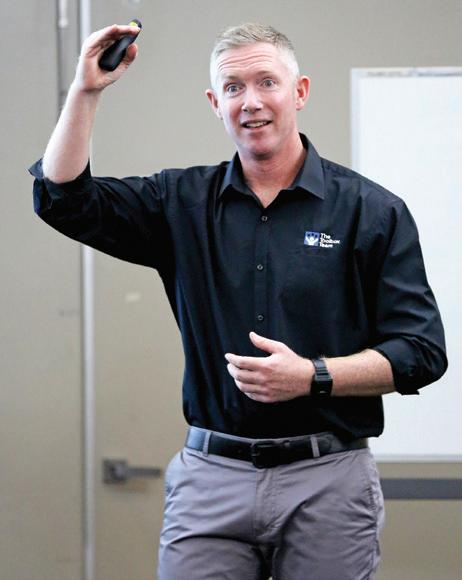
NICK SKICKO
Metropolitan GC, Vic
“Some highlights from the program for me were the team culture session with Mark Carter and the brand profile session with Ben Gibson. I believe team culture is a big part of having a successful team and I found
Irrigation Water Systems
Create a variable speed booster station to your technical specifications.
• Maintain constant pressure
• Optimized pumping efficiencies
• Longer lifetime and reduced lifecycle costs
Lowara’s extensive pump range together with our large selection of custom control options, offers a complete line of booster systems ideally suited for the diverse requirements of the turf, landscape and golf courses markets. Contact us to find your solution today. featuring HYDROVAR® or a custom control system.
this session helpful on how to not only lead a team but build the team up and help them progress towards their own goals. Networking was another positive takeaway, meeting and communicating with other professionals in the same position as myself.
“Aspects and concepts that resonated with me were how to build a strong culture (e.g. what the pillars of good culture are and what are culture killers). As stated above, I believe the strength of your team can have a big effect on the quality of work that is produced. So, I found the session with Mark interesting and gave me plenty of ideas on how to help maintain and build the team culture in my workplace. As a result of the FTMI, I will be working on a few skills to further push myself, including communication, public speaking and building my professional profile, as well as getting more involved in tasks such as budgeting and chemical programs.”
LIAM HEWITSON
St Clair GC, NZ
“My highlight of the FTMI was the talk from Mark Unwin on social styles and how to understand different people. This was an eyeopening presentation about how sometimes people can be quick to judge somebody without necessarily understanding them and their personality type. It showed me that how a person acts and comes across is generally down to their personality type and that I need to work on the way I think about people not only when I meet them, but also people I already associate with, so I can get a better understanding of them. It was a fun interactive activity that connected a lot of dots when we went into our different personality groups and identified what drives each of us, which helped me to better understand everyone.


MARCH-APRIL 2024 35
Ph: 1300 4 BBENG www.brownbros.com.au
Expert FTMI presenters Mark Carter (top) and new addition Ben Gibson from The Toolbox Team (above). Carter spoke on developing a good workplace culture, while Gibson talked about personal branding
DELIVERING PUMPING SOLUTIONS 05/22
“A few messages that resonated with me from the program was that ‘positivity is infectious’ and how the way you develop your own personal brand will have major ramifications on your future opportunities to be a leader in this industry. The higher regard you hold yourself in and the standards you set for yourself that relate to your own brand (i.e. character, behaviour and mindset) will allow you to develop to be a great leader and have great work relationships. Maintaining these will lead to great work environments and new opportunities being endless.
“From being involved with the FTMI I will be working on skills to develop my own personal brand and improving the culture at our workplace. I will be looking into further education opportunities such as the Diploma in Sports Turf Management. And I’ll be looking at gaining more experience at new courses, whether that is working a season or full-time in Australia as that is where I want the next steps in my career to be.”
MATTHEW FORDER
The Sands, Torquay, Vic
“The main highlight was the opportunity to network. To be able to work closely and share ideas with turf managers from all over Australia and New Zealand was something that has not just helped me in the present but will also help me in the future as we will stay in touch.
“All of the presentations were very helpful, in particular the one presented by Mark Unwin on ‘Taking the next step’. This covered job applications, CV writing and interview techniques. I found this very helpful because as chance would have it I was having an interview that night of the presentation. I was able to implement some strategies from that presentation into my own interview, which ended up being a great success. From the FTMI I have highlighted a couple



areas of weakness which I need to work on – presentation skills and budgeting – purely because I have little experience in both. I have taken on board the information shared by Carmen Sederino and Peter Schumacher and look forward to putting that into practice.”
DOM PELUSI
The Gabba, Qld
“The highlight of the FTMI for me was meeting and sharing stories with so many like-minded people. Brooke Hanson’s opening night talk on “never giving up” and having a “just do it” attitude was inspiring. As greenkeepers we

are constantly faced with challenges where we require a great deal of resilience and agility to overcome challenges. As a result of the FTMI I will be working on building a positive reputation within the industry and taking positive approaches to all aspects of the job.”
CODY TUCKER
Metropolitan GC, Vic
“The high point of the FTMI was being able to connect with many people in similar roles and tap into each other’s minds about how they tackle issues and come up with solutions to common problems we all experience. It was also great to be able to show the NZ guys around Melbourne and Metropolitan Golf Club. Brooke Hanson’s presentation about “don’t quit, do it” hit me pretty hard. She gave the perspective of not letting others get in the way of your dreams, but also if you are wanting to chase a dream, back yourself in and work hard to reap the rewards in the long run. Her comments about how she likes to focus her work based around her family and outside commitments which led to a good work/life balance were very insightful. From doing the FTMI, I will be focusing on building a brand for myself if I am looking to make my move forward through this industry. Other things I will be working on is understanding the financial side of the role as a turf manager.”
36 AUSTRALIAN TURFGRASS MANAGEMENT 26.2 FTMI
The FTMI provided another professional development opportunity for City of Ballarat’s Jayde Robson
Camden Golf Club assistant superintendent Isaac Wojewodka during one of the group discussion sessions
With the variety facilities that Devonport Country Club maintains, assistant Tim Moore took a lot away from his involvement in the FTMI program
As a result of the program, NZ FTMI delegate Liam Hewitson is looking to further expand his education



benefits Community
ATM columnist John Neylan reflects on the release of the Community Benefits of Golf in Australia report and reviews some recent overseas research that will be of interest to Australian turf managers.
In the latter part of 2023, the Australian Golf Industry Council released its Community Benefits of Golf in Australia report which has been developed to understand the economic, social and environmental benefits that the game contributes to everyday Australia. The report quantifies these values in a way that hasn’t been previously available, with the aim of the report to provide the necessary data that will help change the perception of golf. Golf Australia (GA) states that the report will serve as a valuable resource to the industry, its partners and stakeholders and the wideranging sectors golf intersects. The hope is it will lead to broader conversations about golf and its place and value in Australian culture.
Anyone that has worked on a golf course or played golf would appreciate that the golf course is important as both a recreational facility and a greenspace within an increasingly dense urban environment. The report devotes considerable space to the environmental benefits of golf courses and from my perspective is a refreshing change of attitude. Golf has tended to focus on the playing surfaces and at times seen the non-turf surfaces as an inconvenience.
Golf courses are excellent areas of biodiversity and create wildlife corridors in urban environments. As cited at the 1997 Australian Turfgrass Conference, the vicepresident of the Australian Conservation Foundation (Figgis, 1997) condemned golf
courses because of their perceived impact on the environment. The plus side was that Ms Figgis saw great opportunities for golf and acknowledged the importance of the wildlife corridors provided by the Melbourne Sandbelt golf courses. This was an early broadside that was somewhat dismissed!
Of the $3.3 billion total annual benefits of golf that the recent report outlined, the environmental component has a total value of $890 million. The value of environmental benefits of golf each year are achieved through biodiversity, flood and stormwater protection, water filtration and purification, carbon sequestration and urban cooling. This is nothing new, however, it is good to see that it now has an economic value. Golf courses provide important environmental benefits, especially in urban areas where green space is becoming more limited.
Of particular note, the report references the biodiversity study of golf courses undertaken by Melbourne University in the mid-2010s. This was a joint project undertaken with the Australian Golf Course Superintendents Association (AGCSA, now ASTMA), in conjunction with the University of Melbourne and Griffith University. The objective was to improve the understanding of biodiversity conservation and carbon sequestration provided by urban green spaces and in particular golf courses. The project was jointly funded by the Australian Research Council
38 AUSTRALIAN TURFGRASS MANAGEMENT 26.2 JOHN NEYLAN
Golf courses provide important environmental benefits, especially in urban areas where green space is limited
(ARC), the Australian Research Centre for Urban Ecology (ARCUE) and the AGCSA.
The project involved a network of 13 golf courses in Melbourne’s south-east suburbs. The article in Australian Turfgrass Management Volume 16.5 (September-October 2014) titled ‘Green havens’ provides an excellent summation of the work undertaken. Among the key findings were not only the incredible biodiversity on golf courses and the conservation value, but also that the poorest non-golf landscapes still had significant biodiversity value.
The other key point from my perspective is the ongoing issue of who is going to fund research in the turf industry. Over the past 30 years the majority of the research projects that I have been involved with have been funded by the AGCSA/ASTMA, the VGCSA and STA Victoria. It has been very difficult to get any funding from the sporting bodies or the users of the sporting surfaces. The research has been driven by the turf managers to solve problems that impact their ability to provide the continued quality of playing surfaces that are expected by the user groups.
There are several good examples of where there are significant industry challenges ahead that may ultimately affect the playability of the playing surfaces. Herbicide resistance in Poa annua and the emergence of the patch diseases caused by ectotrophic root-infecting (ERI) fungi are just two examples that will ultimately impact turf condition and surface playability. The turf industry will ultimately require financial inputs from the sports to develop appropriate management strategies. In the Golf Course 2030 Australia document released in June 2022 (www.golf.org.au/asustainability-roadmap-for-australian-golf) there were several research projects identified that have yet to be funded or commenced.
FURTHER READING
Australian Golf Industry Council (2023) Community Benefits of Golf in Australia report. www.golf.org.au/community-benefits-of-golf-inaustralia.
Dr Caragh Threlfall (2014). ‘Green Havens’, Australian Turfgrass Management Journal. September/October. 16(5): p. 6-10, 12.
RECENT RESEARCH
In an age where we are flooded with a tsunami of information regarding turf management and in particular various products that are going to make turf managers’ jobs easier, it is often difficult to find the research on which the claims are made. As a turfgrass agronomist it is important to be able to substantiate the technical information provided to clients and regularly delving into the research is essential. I regularly use the Michigan State University’s Turfgrass Information File (https://
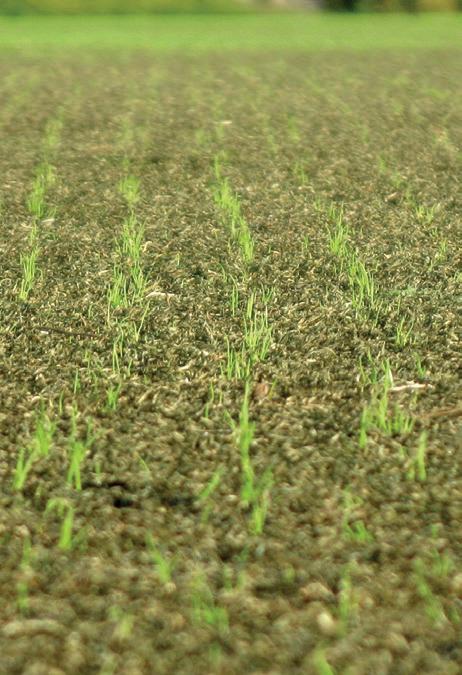
tic.lib.msu.edu/tgif) to see what independent research is available to provide an insight into a particular problem. (Editor's note - ASTMA members have access to the TIF as part of their membership.) As we moved into the new year, I thought it would be interesting to see what research had been completed over the past 12-18 months and published in peer-reviewed reports and articles.
Trawling through some 196 articles to see what research had been undertaken that may be relevant to Australian turf managers, there wasn’t much as most of the work focused on specific issues pertaining to the USA. This further highlights the gap between overseas data and what may be considered to be the key issues in Australia. There were, however, a few publications that I felt were of current interest in Australian turf management.
PHOSPHORUS AND POA ANNUA
The control of Poa annua and the increasing problems of herbicide resistance is everpresent and there has been a very committed research effort undertaken in the USA through the Resist Poa (http://resistpoa.org/) program to better understand how Poa annua develops herbicide resistance and how to combat it.
In a recent piece of research, the interaction of Poa annua and phosphorus has been revisited. When I started in turf some 38 years ago, the mantra was not to apply phosphorus because it promoted Poa annua. This came from some very early research undertaken by Juska and Hanson (1966). McNally et.al. (2022) have recently researched the phosphorus influences on annual bluegrass competitiveness at seeding in creeping bentgrass. It was hypothesised that
Poa annua seedling survival and vigour will increase with phosphorus rates, compromising the establishment of desired turfgrass species. Greenhouse studies evaluated the effect of the phosphorus application rate on Poa annua establishment or cover when seeded with perennial ryegrass (Lolium perenne L.) or creeping bentgrass (Agrostis stolonifera L. ‘007’)
In focusing on the creeping bentgrass trials, five phosphorus rates (0, 12.5, 25, 50, and 100kgP/ha) were applied. In a second trial the phosphorus was applied at reduced rates (0, 6.25, 12.5, 25, and 50kgP/ha). In creeping bentgrass, both Poa annua and creeping bentgrass cover increased when phosphorus was applied and Poa annua was 90 per cent of maximum at 12.1kgP/ha. Creeping bentgrass cover was not compromised by phosphorus application rates as low as 6.25kgP/ha.
The conclusion was that phosphorus enhances Poa annua cover from seed when sown with creeping bentgrass seed in low phosphorus soils. If we consider that most golf greens are established in nutrient and phosphorus poor sands, the application of phosphorus needs to balanced against creeping bentgrass establishment. If a starter fertiliser (NPK 10:10:10) is applied at a typical rate of 300kg/ha, this equates to 30kgP/ha and well in excess of the rate that will encourage Poa annua establishment.
If a phosphorus application rate as low as 6.25kgP/ha will support creeping bentgrass establishment this equates to 62.5kg (10:10:10)/ha which is a considerable reduction in phosphorus. Based on this research the argument could be made that phosphorus should be applied on its own rather than in a balanced NPK fertiliser.
FURTHER READING
Juska, F. V. and Hanson, A. A. 1966. Effect of pre-emergence herbicides and several phosphorus levels on the control of Poa annua. Summary of Proceedings Annual Conference of the Mid-Atlantic Association of Golf Course Superintendents. p. 19-20.
McNally, B. C., Elmore, M.T., Kowalewski, A. R., & Cain, A. B. (2022). Phosphorus influences annual bluegrass competitiveness at seeding in perennial ryegrass and creeping bentgrass. Agrosystems, Geosciences & Environment. https://doi.org/10.1002/ agg2.20321.
MITES AND COUCHGRASS
Mites have arguably become the main pest of couchgrass (Cynodon spp.), particularly where it is impacted by traffic, disease, drought stress and other stress factors. Loch et. al. have studied extensively the distribution of the pest in warm-season grasses and have highlighted its potential impact on turf quality.
MARCH-APRIL 2024 39
McNally et.al. (2022) have recently researched the phosphorus influences on Poa annua competitiveness at seeding in creeping bentgrass


Brown (2023) has highlighted in his thesis that an effective integrated management program incorporating multiple management strategies must be developed to maintain mite damage below damaging thresholds. Repeated applications of miticides does not necessarily prevent or eliminate an infestation but helps reduce mite abundance and damage. Relying primarily on miticide applications is undesirable due to the cost, increased risk of resistance and the potential adverse impact on non-target organisms, workers and users and the environment.
Brown identified that irrigation below optimal level (60 per cent ET rate) promoted mite damage. He suggested that maintaining water inputs to at least 100 per cent of the ET rate, in mite-infested areas, is required to prevent drought-induced increases in mite damage. It was also noted that turf with excessive fertiliser harboured more severe mite infestation. This relationship appears to be due to the improved plant nutrition or causing new growth that mites can colonise.
It was found that mowing height did not consistently affect mite infestation, while scalping turf reduced mite damage in potted bermudagrass turf but not in field turf. Based on laboratory and nursery experiments, clippings generated by mowing miteinfested turf may be a source of mites to infest surrounding turf or spread by humans, vehicles or wind. Removing these grass clippings reduced subsequent mite infestation.
FURTHER READING
Brown, Matthew. 2023. Developing a Cultural Management Approach to Bermudagrass Mite (Acari: Eriophyidae) Infestation. https:// tigerprints.clemson.edu/all_dissertations/3308. Loch, Donald S.; Seeman, Owen D.; Knihinicki, Danuta K.; McMaugh, Peter E. 2017. Distribution, field recognition and implications of phytophagous mite species on Cynodon spp. (bermudagrass) and Pennisetum clandestinum (kikuyugrass) in Australia. International Turfgrass Society Research Journal. 13: p. 1-29.

ERI FUNGI
The patch diseases caused by the ectotrophic root-infecting (ERI) fungi have been widely discussed in Australia with considerable holes in our knowledge around the causes of the disease. We have a general base of information around weather conditions and turf factors that may encourage its presence but no research to support these conclusions. As the ERI diseases become more problematic, there is a need to better understand the factors that are responsible for these disease outbreaks.
Research undertaken by Henderson and McCall (2023) investigated the colloquial information shared among turf managers that suggested this disease tends to accumulate on north-facing slopes and could also be more severe in low lying areas. Anecdotal evidence in Australia would indicate that low lying areas with high soil moisture, excessive thatch and soil compaction are all factors that influence the presence of the disease.
Their research aimed to quantify the influence of the local topography and other related environmental factors on the localisation of spring dead spot (SDS) in golf course fairways. Light Detection and Ranging (‘Lidar’) data was used to map the topography and was combined with aerial images to plot SDS outbreaks against topography.
In this research the Lidar data was combined with SDS locations for 16 fairways across three locations. The slope, aspect (compass direction), annual sunlight and landform shape of each portion of each fairway was calculated. Topography and other related factors were analysed, however, this only accounted for about 1.2 per cent of the variance between samples. These data suggest that local topography is among a multitude of factors that contribute to SDS epidemics, but that these features alone do not dictate development.
The conclusion I make from this is that in understanding these root diseases, all contributing factors must be considered. Wherever there is an ERI outbreak, a detailed forensic analysis is required so as to better understand the contributing factors. As discussed at the 2023 conference in Adelaide, the Australian turfgrass industry needs to have a database to collect this information.
FURTHER READING
Henderson, C. A., & McCall, D. S. (2023). Getting the Lay of the Land: How Topography Influences Spring Dead Spot Epidemics [Abstract]. ASA, CSSA, SSSA International Annual Meeting, St. Louis, MO. https://scisoc. confex.com/scisoc/2023am/meetingapp.cgi/ Paper/152251.
As ERI diseases become more problematic, there is a need to better understand the factors that are responsible for these disease outbreaks
40 AUSTRALIAN TURFGRASS MANAGEMENT 26.2 JOHN NEYLAN
Mites have arguably become the main pest of couchgrass, particularly where the turf is subjected to stress


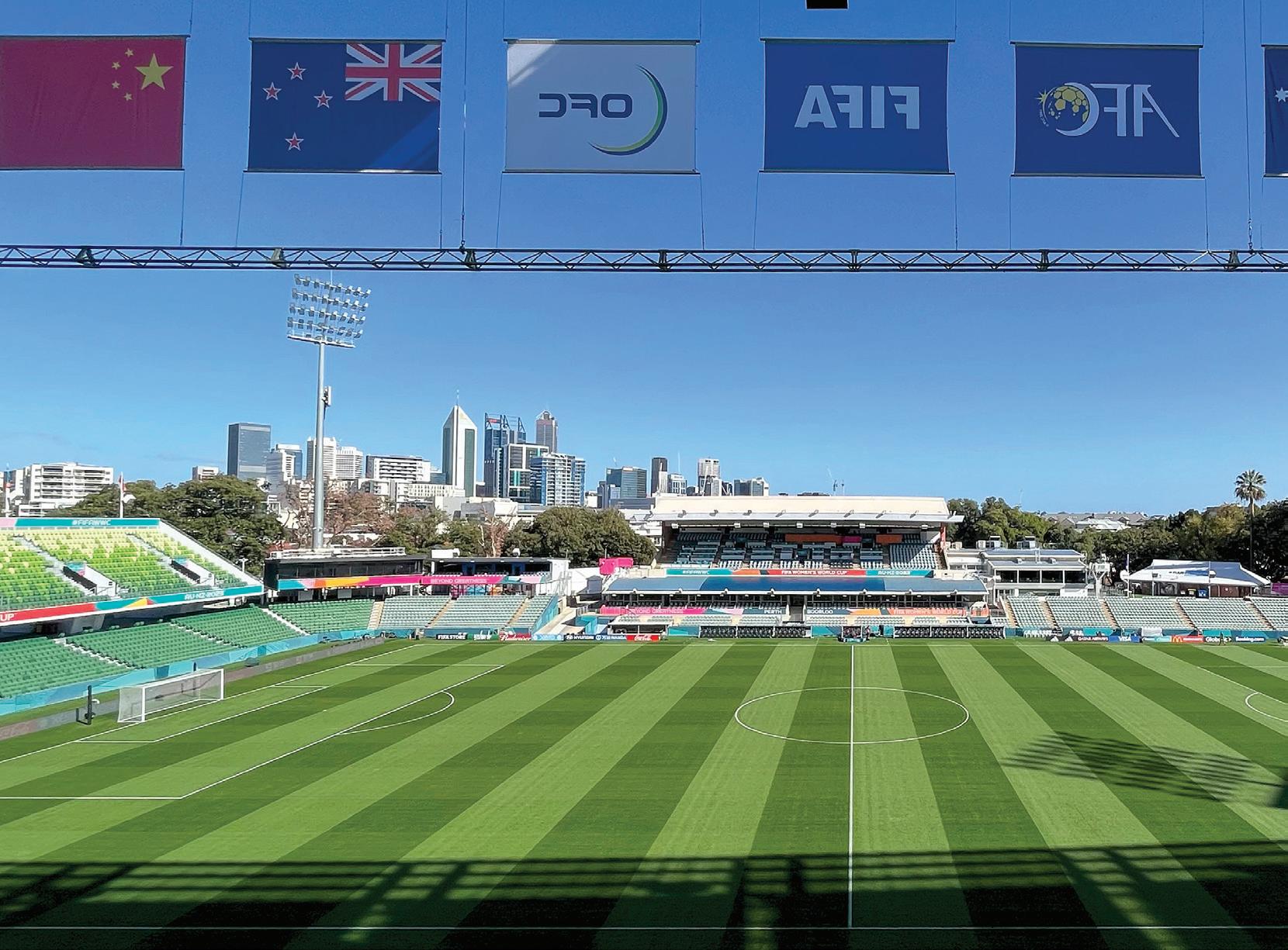
Pengilly’s
park
John Forrest tracks the journey of HBF Park turf manager Alec Pengilly who has prepared the Perth rectangular stadium for a number of major international events over the past 12 months.
It’s a powerful truth that when presented with the right opportunities young people can completely reshape their lives and achieve feats they never believed possible. It also underscores the pivotal role that turf managers as leaders can play in moulding the future of those coming through the ranks and giving someone a chance to prove themselves.
Take Alec Pengilly, the current ground supervisor at HBF Park in Perth, for example. Now 29, back when the Perth native was a 16-year-old, things weren’t quite mapping out and he was heading down a path which wasn’t good. Fortuitously, a job offer working in the clubhouse kitchen at The Cut Golf Course south of Mandurah allowed him to break the cycle he found himself in and would ultimately start him down a path to where he now finds himself. Pengilly readily admits that kitchenhand role wasn’t the most inspiring job, but it developed his ability to stick to a task even if it was mundane and not much fun.
Having stuck it out for 15 months, the head chef at The Cut offered Pengilly a job as an apprentice chef, a role he had little ambition for. Out of the blue, however, came another big opportunity when he was offered a greenkeeping apprenticeship by The Cut’s then superintendent Nick Price. It would prove to be a turning point in Pengilly’s life, but it did have its challenges. He had to adapt to a new field, learn new skills and overcome his initial lack of interest in golf (his first love was baseball).
Working as a greenkeeper soon opened Pengilly’s eyes. Part of a small tight-knit team of five, the working environment was completely different to what he had been used to. Under Price’s guidance they maintained the spectacular oceanfront course and landscape, working within the constraints of a tight budget to produce a well-maintained and wellrespected golf course.
Price was a great boss and taught Pengilly a lot, in particular the importance of
42 AUSTRALIAN TURFGRASS MANAGEMENT 26.2 JOHN FORREST

the ‘one-percenters’. Those who know The Cut will appreciate the course’s layout which runs across a long stretch of Indian Ocean coastline. On one occasion, near knockoff, Price informed Pengilly that he had left a rake in a bunker at the far end of the course that wasn’t straight. It was a 14-minute trek to go and put the rake where it should be and it proved a lesson in detail that Pengilly has never forgotten.
As part of his apprenticeship, Pengilly attended TAFE on block release. Initially, his school mindset hindered his appreciation for the learning experience, but in his second year a shift occurred. He began to absorb the wisdom of his experienced TAFE lecturers, Jeff Austen and Rob Williams, and his perspective broadened as he interacted with apprentices from various industry sectors. This helped to illuminate the diverse pathways within the industry, while the guidance and support of those mentors played a crucial role in helping Pengilly to shape his future journey.
THE ROAD TO HBF
After seven years at The Cut, Pengilly felt he needed to progress and experience some different work environments. Through a close friend, he heard that a job was coming up at Lake Karrinyup Country Club under course superintendent Fraser Brown.
With its reputation for exacting standards across all turf surfaces, in addition to hosting regular major tournaments, it was a big change of environment for Pengilly. One of the events he experienced was the ISPS Handa World Super 6 tournament in 2019, the last in a series of co-sanctioned European and Australasian Tour events that the club had hosted going back to 2012. Being involved in a major tournament was a significant learning experience as to the level of detail required across all areas, whether that was in the daily preparation of surfaces, machinery or staffing.
After two years at Lake Karrinyup, Pengilly then applied for a job as a groundsman at the WACA (Western Australian Cricket Association) ground. Nathan Saville, the former turf manager at Subiaco, interviewed him and he got the job. Pengilly’s role was working with well-known curator Gary Lugg, maintaining the outfield and wicket run-ups, learning how to set out the ground and mowing patterns and presenting the iconic ground to the highest of standards. There was also an opportunity to roll wickets, which was a new experience and another step in his education in preparing firstclass sports surfaces.
The WACA was a fantastic place to work. There was a real family vibe and Pengilly got to rub shoulders with some of Australia’s and the state’s best cricketers. It felt like a place he could happily stay at, however, COVID hit and with it came a switch across to Green Options. After meeting with Saville, who was also now with the company, Pengilly was offered a position maintaining a couple of council parks. It was a chance to prove himself and move into managing an area which included overseeing an apprentice.
After 10 months in that role, Pengilly was asked if he was interested in the role of turf manager at HBF Park. He didn’t need to be asked twice and readily accepted the position, starting there on 11 November 2021. HBF Park is Perth’s premier rectangular stadium and is home to A-League club Perth Glory and the Western Force Super Rugby franchise. As well as the prospect of preparing the ground for those elite teams, Pengilly also had the exciting prospect of the venue hosting matches during the 2023 FIFA Women’s World Cup. HBF Park, or Perth Stadium as it would be called for the tournament, was one of six Australian stadiums used and played host to five games.
WORLD WATCHING
In the lead-up to the World Cup, the entire HBF Park surface was replaced with HG Turf’s Hero hybrid product which was grown by Greenacres Turf Group. Prior to the new Wintergreen couchgrass going down, about 100mm of the existing surface was removed and the profile fumigated. Over the years, Southern sting nematodes (Ibipora lolii) have been a problem at HBF Park, impacting the root system and meaning an increase of inputs in order to get the turf up to elite standard.
Draslovka Services was contracted to undertake the fumigation using their EDN product. The ground was covered with plastic sheets glued together. Small tubes, laid in a zig-zag pattern, were used to pump the fumigant across a six-day period. The surface was then left for a further four days after which time the sheets were removed and work could begin on preparing the final surface.
The site was surveyed, a new sand rootzone imported and sprinklers reinstated. A synthetic edge was also added around the ground before the Hero hybrid turf was installed. Turf started going down on 15 April, with HG Turf completing the job on 18 April. Prior to being marked up, the surface was inspected on 21 April to ensure it was safe for the coming weekend doubleheader, with the Western Force and Perth Glory playing their first games back on the surface.
In order to meet FIFA’s stringent ground requirements, the HBF Park surface was oversown with ryegrass six weeks after it was laid. Two passes were made at 150kg/ha per pass, with a further 100kg/ha oversow four weeks later. Two weeks before the first Group match, more ryegrass was put out in some of the weaker areas with a hand spreader.
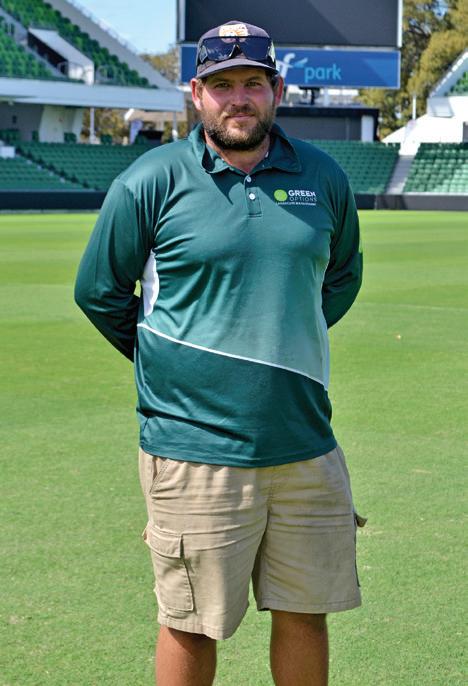
MARCH-APRIL 2024 43
HBF Park in Perth played host to five games as part of last year’s FIFA Women’s World Cup
HBF Park ground supervisor Alec Pengilly


With the tournament being held during Australia’s winter, a first for a World Cup, FIFA was mindful of the impact that bad weather could potentially have on games. As such, they requested that a number of venues, including HBF Park, be entirely covered. The large white sheets were supplied by FIFA and came from UK-based company Sports and Stadia which specialises in surface protection systems.
The company shipped over four of their full length MacLeod Cover Systems for the duration of the tournament. As well as Perth, the covers were deployed at host stadiums in Sydney (Allianz Stadium), Wellington (Sky Stadium) and Auckland (Eden Park). The cover blanketed the entire surface, with an inflatable central tube down the length of the pitch effectively creating a tent-like structure which allowed any water to shed off to the edges of the ground (see photo below)
HBF Park’s five Group stage games were held over a 13-day period from 22 July to 3 August. Denmark, which based themselves in Perth for the tournament, played two matches (against China and Haiti), while the other three games featured Canada, Republic of Ireland,
Panama, Jamaica, Morocco and Colombia. Average attendance was around 17,000 for each game, with the ground presented in firstclass condition every time.
Pengilly says that preparing the ground for a FIFA event opened his eyes to the degree of detail required to prepare an international pitch. Hawkeye was used to ensure that the goals were never more than 15mm out of square and the length of the ground was never more than 4mm out. Line marking also had to be done to perfection.
ON A ROLL
As soon as the tournament was over there was little respite for Pengilly and not much time to reflect on a job well done. The oversown ryegrass needed to be removed, the surface renovated and then brought back into play for Perth Glory’s return match on 22 October. Less than a week later the ground would also play host to three Matildas games over a seven day period (26 October-1 November) as part of the Asian Qualifiers for the Paris 2024 Olympics.
Pengilly used Quali-Pro Negate to remove the ryegrass and while the herbicide was doing

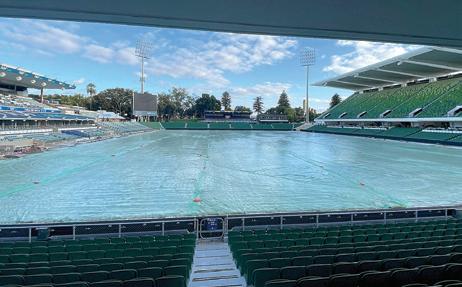

its job he took the opportunity to take a couple of weeks off. Upon his return, he dropped the height of cut from 22mm down to 12mm and used a Gianni Ferrari mower with flail blades to scarify the surface in two directions. The surface was then brought down to 10mm and 25m3 of sand was spread.
After successfully hosting Glory’s start to the new A-League season and three Matildas wins, in late November the Foo Fighters came to town and played to a sell-out crowd of 32,000. After that, three more Glory games were timetabled over the Christmas/New Year period before the arrival of another major event over the Australia Day long weekend.
As was written in the last edition of Australian Turfgrass Management, World Rugby (rugby union’s governing body) announced last July that it was revamping its premier sevens rugby series, with Perth replacing Sydney as host city of the tournament’s Australian leg. With 12 men’s and women’s teams playing across a packed threeday schedule, it was another hectic period for Pengilly and his team.
Ten weeks before the tournament Loton Park, which is next to HBF Park, was set up so that it could be used as a training and warmup ground for the event (teams would use it for 20 minutes before each game). The threeday event was held from 26-28 January with a sell-out crowd on the final day witnessing Argentina (men) and Ireland (women) winning

44 AUSTRALIAN TURFGRASS MANAGEMENT 26.2 JOHN FORREST
Ahead of the World Cup, HBF Park was resurfaced by HG Turf. The ground was fumigated prior to the Hero hybrid turf being laid and a synthetic perimeter also installed
HBF Park was one of four World Cup venues where specialised ground covers brought in from the UK were deployed to protect the field from winter weather during the tournament
HBF Park hosted a Foo Fighters concert in late November ahead of three A-League games
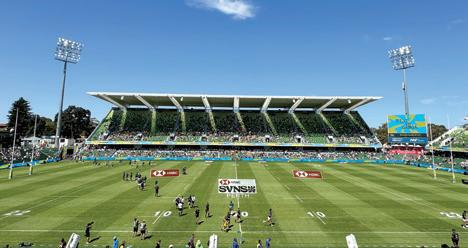
the respective titles. The first two days saw the ground host 24 games each day, with 16 games on the last day including the playoffs and finals.
Although the Australian sides fell valiantly short, the event was first class and not only showed HBF Park off as a top-class venue, but also showcased Perth to the world. While the program was challenging from a turf perspective, it was another occasion for Pengilly and the Green by Nature crew to present the stadium at the highest level.
After the tournament the ground was transformed back for A-League and with the start of the current Super Rugby season in late February, Pengilly and his team had three double-header weekends in February, March and April where the ground needed to be switched over in the space of 24 hours.


ENJOYING THE PROCESS
Pengilly’s progression and development is inspiring and shows what can happen with determination and focus. It is also an example of the opportunities the turf industry can afford and where it can take young people. On his journey, his development has been enhanced and enriched by some quality turf managers, among them Nathan Saville (WA manager of Green by Nature and past curator of Subiaco Oval), Gary Lugg (well-respected ex-head
curator of the WACA), Nick Price (former superintendent at The Cut) and Fraser Brown (current Lake Karrinyup superintendent).
The past two years have been a hectic time for Pengilly, but he has shown his ability to present high-quality surfaces at HBF Park across a number of different events. He enjoys the process that is required to prepare a surface for the different events the venue hosts and working as a collective with like-minded people to deliver a high end result.




MARCH-APRIL 2024 45
Pengilly says that preparing the ground for a FIFA World Cup event opened his eyes to the level of detail required
HBF Park played host to the Australian leg of the revamped HSBC World Rugby Sevens in January

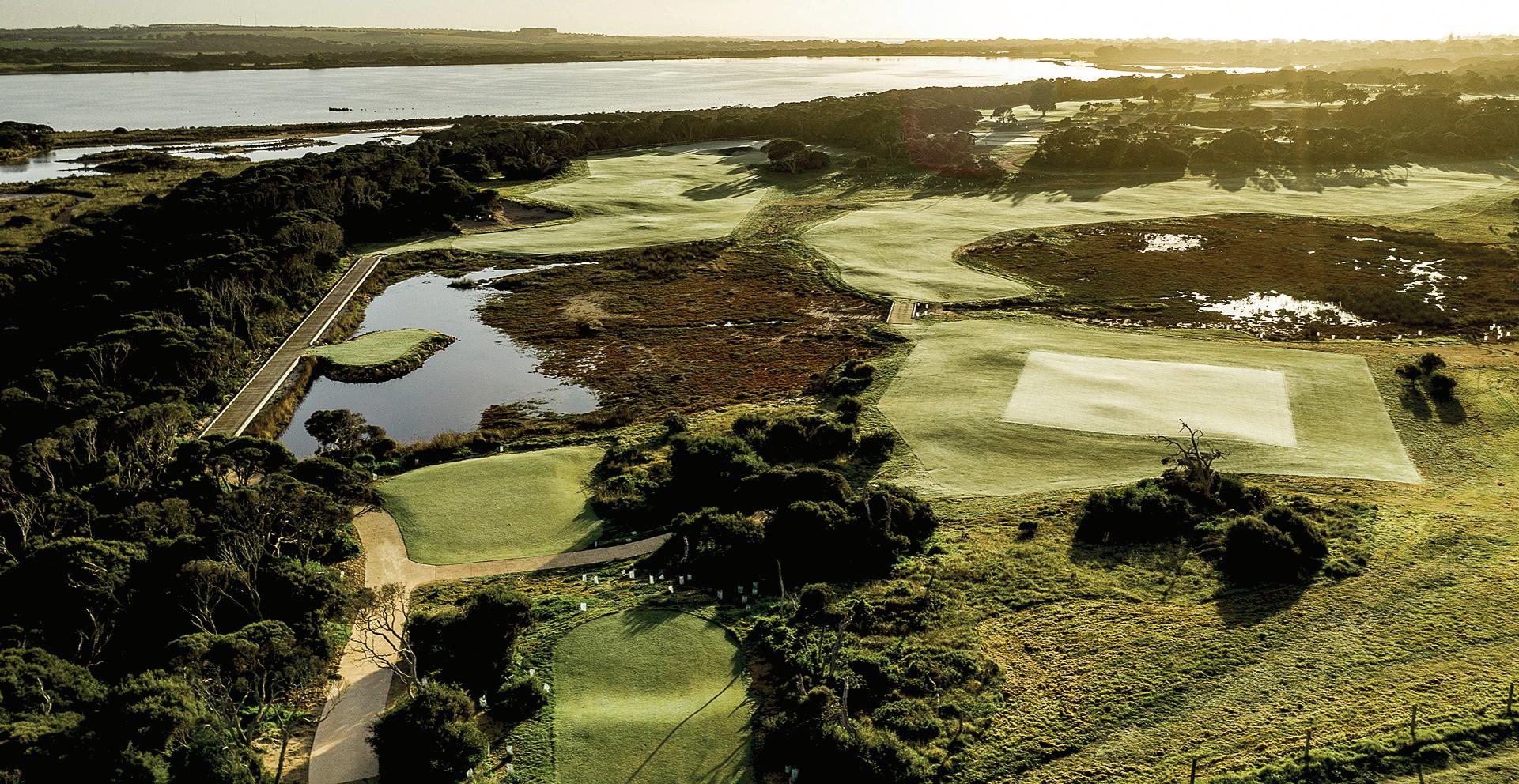
Rewilding golf
Continuing her series of articles on sustainable golf course improvements, Kate Torgersen explores how rewilding golf courses can benefit both players and the environment.
Green golf courses are the new trend! The traditional image of manicured fairways and pristine landscapes is changing in a world where sustainability is paramount.
Rewilding is a groundbreaking approach to golf that not only benefits the environment but also enhances it. The vibrant colours of indigenous flora and fauna will captivate your senses as you stroll through a golf course that seamlessly blends into nature. An eco-friendly golf course is a place where biodiversity thrives, water is conserved and carbon is sequestered, all while you play golf. Sustainable golf course construction is not just a dream, but a growing reality.
A traditional golf course is typically constructed with lush green fairways and meticulously maintained bunkers. This conventional approach, however, often comes at a cost to the environment and the budget, as high water usage, chemical inputs and maintenance efforts are required.
Due to extensive clearing of natural vegetation, golf courses have been criticised for their impact on local ecosystems and biodiversity. Furthermore, the use of non-native grass species or monoculture landscaping has reduced wildlife habitat diversity and made it more vulnerable to pests and diseases. Moreover, fertilisers and pesticides can contribute to soil degradation and water pollution, which further exacerbates the issue of water scarcity in many regions.
HOW DO YOU CONSTRUCT A SUSTAINABLE GOLF COURSE?
As concerns about sustainability grow worldwide, golf course managers are increasingly seeking alternative ways to minimise their environmental footprint while still providing an enjoyable playing experience for golfers. In response to these shifts towards more eco-friendly practices, sustainable golf course construction methods have emerged that prioritise biodiversity enhancement, conservation and resource efficiency.
This approach minimises environmental impact while enhancing natural habitats and biodiversity by integrating eco-friendly practices into the design and maintenance of golf courses. In addition to reducing water usage, carbon sequestration and chemical inputs, sustainable golf courses incorporate strategies such as rewilding, green space preservation and indigenous vegetation planting.
As well as creating increased habitat for local flora and fauna, these courses utilise low-maintenance revegetation techniques that require less water and energy to maintain. In addition to benefitting the environment, sustainable golf course construction also provides opportunities for communities to connect with nature in urban areas. As well as providing recreational opportunities for players of all skill levels, golf courses can contribute significantly to conservation efforts by embracing sustainable practices.
There are many benefits associated with sustainable golf course construction that go
46 AUSTRALIAN TURFGRASS MANAGEMENT 26.2 ENVIRONMENT
PRODUCTIONS
PHOTO: WILLIAM WATT/CADDIE
Opposite: The recently redeveloped Lonsdale Links in Victoria is a great example where rewilding and revegetation played a key role in enhancing the overall redesign of the course
beyond golf itself. By incorporating eco-friendly practices, these courses become havens for wildlife and biodiversity. In addition to providing habitat for local flora and fauna, indigenous vegetation enhances an area’s natural beauty.
A significant advantage of droughtresistant grasses and smart irrigation systems is that they conserve water resources while minimising chemical runoff into surrounding ecosystems. By planting local species and maintaining green spaces that absorb carbon dioxide emissions, sustainable golf courses contribute to carbon sequestration. Through rewilding golf courses, we create green spaces that benefit communities by providing recreation areas while preserving nature’s delicate balance.
One of the major obstacles golf courses face when transitioning to a more sustainable approach is the financial investment required to implement eco-friendly technologies and practices. There are significant costs associated with redesigning irrigation systems and incorporating native vegetation. A second challenge is changing traditional mindsets within the industry. It takes education and perseverance to convince stakeholders that sustainability has long-term benefits. In addition, golf courses looking to adopt more sustainable practices find it challenging to navigate regulatory hurdles and comply with environmental laws.
Despite these obstacles, many golf courses are rising to the challenge and reaping the rewards of their efforts towards improving sustainability. By overcoming these challenges, they are not only benefiting the environment, but also improving their reputation and appeal among environmentally-conscious players and communities alike.
CREATING BIODIVERSITY AREAS
As part of the construction of sustainable golf courses, biodiversity areas will be thoughtfully integrated into the design, enhancing the ecosystem as a whole. These spaces are more than just aesthetics; they provide a vital habitat for local flora and fauna. A golf course becomes a thriving ecosystem in its own right if it incorporates diverse plant species and creates habitats such as bird boxes and pollinator gardens.
By supporting natural processes like nutrient cycling and pest control, these biodiversity areas not only preserve indigenous species but also promote a healthier environment. Furthermore, they provide golfers with opportunities to connect with nature on a deeper level, fostering an appreciation for the delicate balance between golf and ecology.

These areas offer both visual appeal and ecological functionality thanks to innovative design strategies that blend seamlessly with the course layout. This approach will lead to harmonious landscapes that benefit wildlife, players and the environment simultaneously as more golf courses adopt it.
The most important aspect of sustainable golf course construction is reducing the amount of mowing in out-of-play areas. Traditional golf courses often require extensive mowing of grassy areas outside of the main playing areas. Rewilding promotes biodiversity and supports indigenous species that may have been displaced by intensive turf management by allowing out-of-play areas to grow naturally. Reducing mowing is also a simple but effective way to contribute to water conservation and reduce chemical usage.
To assist with educating golfers, perhaps locate signs near unmown areas highlighting the benefits, remembering that it is part of a greater plan to harmonise golf with nature.
COMMUNITY ENGAGEMENT
Involving local residents, schools and organisations in the planning and development process promotes a sense of ownership and pride in the course construction process. The
importance of biodiversity conservation on the course can be raised by hosting workshops, volunteer days or educational events.
Golf courses can promote a greater understanding of their environmental initiatives by engaging with the community and inspire others to do the same. In addition to benefiting the ecosystem, this collaborative approach strengthens relationships between golf facilities and surrounding communities as well.
Community members can provide innovative ideas for improving biodiversity and promoting wildlife habitats by incorporating their feedback. By partnering with local groups, golf clubs create a network of support that extends beyond the golf course, enriching both natural landscapes and human connections.
ENVIRONMENTAL STEWARDSHIP
As golf course construction continues to evolve towards sustainability, it is imperative for the golf industry to prioritise environmental stewardship. Golf can become a leader in habitat restoration and conservation by rewilding golf courses, creating biodiversity areas, reducing mowing in out-of-play areas and engaging local communities.
Golf courses can contribute to urban development while providing habitats for

MARCH-APRIL 2024 47
PHOTOS THIS PAGE: ROB SWIFT/OCM GOLF
Indigenous plants require very little long-term maintenance if they are properly planted and established and provide valuable habitat and food for native wildlife
Indigenous plantings complement the unique design features of the new Lonsdale Links bunkers

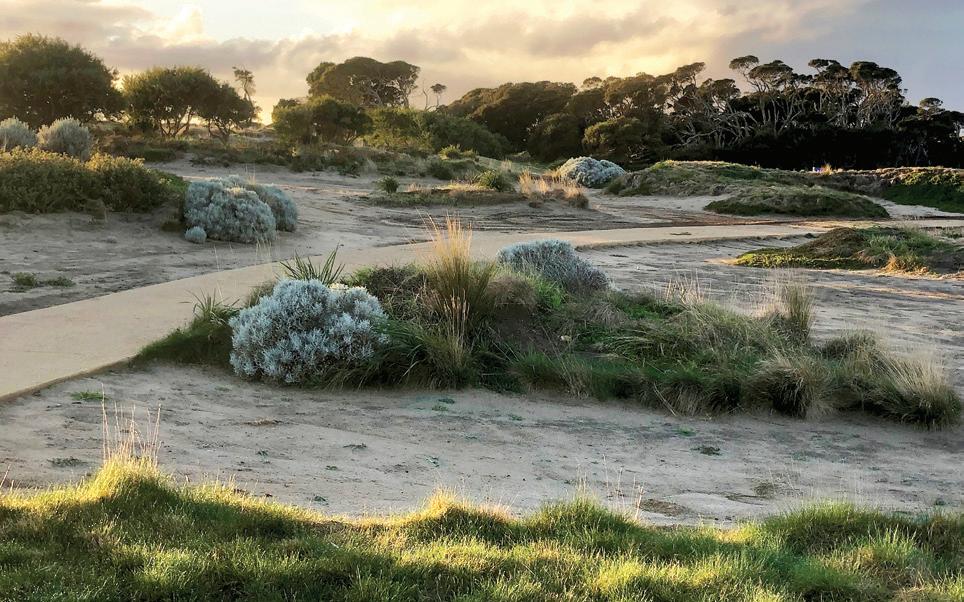
wildlife through initiatives focused on water conservation, carbon sequestration and increasing flora and fauna diversity with indigenous species. Future generations can benefit from the harmonious coexistence of golf and nature by embracing chemical reduction practices and minimising carbon emissions through less mowing.
By promoting a strong bond between golf and the environment, we not only improve the playing experience but also establish a positive impact on our planet. This dedication to sustainable practices ensures that golf will not only be a game enjoyed on well-maintained landscapes, but also a powerful contributor to preserving our natural world for the future.
It takes careful planning and implementation to create a sustainable and rewilded golf course and the following are some steps that clubs can take:
l The first stage is to conduct an analysis of the current landscape, identifying the areas that can be rewilded. The best way to enhance the natural habitat is to engage with experts in rewilding and conservation.
l Implement bird boxes, bee hotels and bat houses to further support local flora and fauna by creating wildlife corridors within the course.
l Maintain a rewilded golf course with sustainable practices by educating staff, members and visitors.
Taking these steps thoughtfully and intentionally can lead to a seamless transition towards sustainability. Encourage community participation through volunteer programs focused on conservation efforts.
CASE STUDY – LONSDALE LINKS
One recent golf course redevelopment which shines a light on rewilding and its importance as part of the overall design concept is Lonsdale Links on Victoria’s
Bellarine Peninsula. Over a two-year period between 2019 and 2020, OCM Golf completely redesigned the course and its environs. Principal architect Ashley Mead provided an in-depth review of the project in the September-October 2020 edition of Australian Turfgrass Management Journal (Volume 22.5), highlighting the many unique classical course design elements they incorporated as well as the large landscape component that complemented their work.
According to Mead, the vision for Lonsdale Links is to complement a well-designed functional golf course with distinctive Moonah woodland vegetation and a series of lowlying salt marshes. Both of these vegetation communities enhance the golfers’ experience, making the course a unique experience. The land upon which Lonsdale Links resides has long supported Moonah woodland and scrub vegetation for over 10,000 years including


when Point Lonsdale was an island separated from the mainland some 6000 years ago. The course is separated into three parcels of land;
l The existing course compromised of belts of Moonah (Melaleuca lanceolata) and many non-indigenous species that had been planted, including Tuart (Eucalyptus gomphocephala) from WA and Monterey cypress (Cupressus macrocarpa) from California. Both of these were removed which highlighted the rolling dune terrain which is easily visible now that lower profile vegetation dominates the landscape.
l The lower ground around Lake Victoria (which the course borders) contains some beautiful Moonah species and very little planted non-indigenous species. This parcel also consists of large sections of salt marsh vegetation that is home to many migratory bird species.
l The farmland, which consisted of some very old stands of Moonah species and no planted non-indigenous vegetation.
A major part of the OCM Golf brief was combine these parcels of land into the one golfing experience. To do this, the vegetation across the site needed to have a consistent theme and it was their opinion this should be through the use of indigenous vegetation. A key objective of the landscape vision was to “Protect local significant views and vistas that contribute to the landscape, including extensive and scenic out views across waterbodies from main roads and settlements.”
Throughout the project around 100,000 indigenous plants were contract grown and installed across the site. Indigenous plants add beauty to the landscape and preserve natural heritage, provide food and habitat for native wildlife and decrease the amount of water needed for landscape maintenance. They require very little long-term maintenance if properly planted and established and are generally long lived so minimal replacement planting is required.
The landscape that Lonsdale Links is creating will be around for future generations as this pocket of land plays an important role in the Point Lonsdale community. It is a very good example of how the rewilding concept works and the multiple benefits it has for both the game of golf, the environment and the local community.
48 AUSTRALIAN TURFGRASS MANAGEMENT 26.2 ENVIRONMENT
PHOTOS THIS PAGE: ROB SWIFT/OCM GOLF
The use of indigenous vegetation across the Lonsdale Links course ensures there is a consistent landscape theme
Around 100,000 indigenous plants were contract grown and planted as part of the Lonsdale project
A transition towards more natural landscapes is not only beneficial to the environment, but it also enhances the beauty of the golf course

green Avondale’s tick

Following on from Kate Torgersen’s previous article, Avondale Golf Club superintendent Rob Biddle looks at their recent recertification process as part of the Audubon Cooperative Sanctuary Program for Golf.
Over 20 years ago, Avondale Golf Club in Sydney, under the direction of then course superintendent David Warwick, had the passion and foresight to partner with Audubon International and commit to being a part of the Audubon Cooperative Sanctuary Program for Golf. This put Avondale on a path of environmental responsibility and sustainability which is
something the club continues to pride itself on.
The Audubon Cooperative Sanctuary Program for Golf is an award-winning education and certification program that helps golf courses protect the environment and preserve the natural heritage of the game of golf. By helping people enhance the valuable natural areas and wildlife habitats that golf courses provide, improve efficiency and minimise potentially harmful impacts of golf course operations, the
program serves an important environmental role worldwide.
Last year, as part of the Audubon criteria, Avondale had to go through a recertification process to provide evidence that we were committed to and implementing Audubon’s core values and mission statement which is “To create environmentally sustainable environments where people live, work and play”. This recertification is done every two
50 AUSTRALIAN TURFGRASS MANAGEMENT 26.2 ENVIRONMENT
Avondale Golf Club is set among 60 hectares of Australian native bushland and is home to an abundance of native flora and fauna. The course is classified as Sydney Turpentine Ironbark Forest and is part of a critically endangered ecological community

years and involves either a site visit by an authorised third-party representative or a written application by the superintendent about the property and measures being undertaken.
Luckily for us, our WHS representative epar had just formed a partnership with Audubon as an authorised representative in the Australian market. After epar founder Terry Muir had organised the necessary requirements for the site visit, epar’s manager of EHS operations Madelaine Felton made the trip out to Avondale and went through a thorough recertification process on site.
The visit was over half a day driving around the course providing evidence that the
club was using best environmental practices and following the procedures that Audubon International have put in place. There have been a number of key areas that Avondale has worked hard on over the last 18 months and what follows is a brief rundown of these which formed part of the recertification process.
NATURALISING THE OUT OF PLAY AREAS
Avondale is surrounded by beautiful native bushland which has always seemed separate to the course. We have had the turf and then the vegetation running along each hole, but the two have never seemed in sync with each
other. Our focus has recently turned to try and incorporate the vegetation into the experience of playing the course which we have started with out of play areas. These are areas that are unlikely to be in play when a golfer plays a certain hole and are either turf or are a part of the bushland that has thinned out over time. Our goal is to revegetate these areas with indigenous species that will help to promote and encourage wildlife habitats.
WATER MANAGEMENT
Over the past two years the club has invested heavily in upgrading drainage infrastructure. Silt contamination through runoff has been an
MARCH-APRIL 2024 51
PHOTO: AVONDALE GC/GARY
LISBON

issue on several holes and was highlighted in 2022 when we received over double the annual rainfall average for the year. The construction of rock waterways began last year to assist in slowing up the water flow as it enters the various drainage systems and ultimately the council stormwater system. The construction of more rock waterways will continue over the next couple of years.
The club’s irrigation source comes from an onsite 25 megalitre dam which is fed from the surrounding stormwater runoff. Weekly testing throughout the year of this water is done and graphed to measure the health. Visual aquatic weed assessment is also done to monitor and plan for control measures.
LOW INPUT MAINTENANCE
As the course is set among beautiful natural bushland, we have begun to look at our turf management practices in a more minimal, simplistic approach to achieve a more sustainable and natural-looking golf course. Nitrogen inputs have been reviewed and where possible we have cut back on the amount of nitrogen use, the purpose being to encourage enough growth to get an acceptable coverage without excessive growth where mowing and growth regulator applications must increase.
We have also looked at our chemical programs, particularly our insecticides. We monitor insect activity, assess what damage is acceptable in keeping with our natural presentation and create a control program that is not excessive to the point that it wipes out the entire population. We accept some turf damage that will not impact the member experience, knowing that certain pests provide a food source for the native birds that use the course as their habitat.
COMMUNITY OUTREACH
As green space in metropolitan areas becomes a focus of local governments, there is more scrutiny on how golf courses are utilising this space. As Avondale is a private members club, there is an argument to be had that we only benefit the paying members who play golf on our course and that we are taking up and wasting valuable green space in a highly densely populated area.
As part of the Audubon program, it is our responsibility to show the benefits that a golf course can have to not only our members, but also the wider community. We are currently engaging with the local TAFE to try and use various sites on the course for students to

use the course as their classroom and to perform their bushland regeneration practical assessments. We are also connecting with local nurseries to use the course as a site to propagate native species so they can then supply other areas with new plantings.
As a course team we have also internally spoken about doing ‘walk and talk’ sessions with our membership on the various environmental works we are doing, as well as an informative session on the native flora located on site, the flowers that are produced and the positive effect on the native fauna each species has. Maybe in the future, if successful, these sessions could include community members who are not members of the club.
LOCAL COUNCIL ENGAGEMENT
Avondale is actively part of the Kuring-gai Council microbat monitoring program, where council representatives come out annually and survey the local microbat population. As a result of these surveys we have found a significant population of endangered microbats residing on our course which we will continue to monitor over the coming years with a hope of seeing an increase of numbers.
CONTINUAL IMPROVEMENT
As with any assessment that is performed there are always weaknesses that need improving. From the recent recertification, Audubon International requires us to do more thorough water testing than we currently do. Twice a year we will need to test water that is entering and exiting through our golf course to make sure that our maintenance operation is not polluting any water source. Our management of vegetation areas as well as more opportunities transitioning turf to naturalised areas is something to also improve on. And finally, our maintenance facilities need updating to reflect better environmental standards where we mix and store chemicals and wash down course machinery. This is something the club is currently working on, designing new facilities as a direct result of this assessment.
Having the Audubon International certification is something the club is extremely proud of and keeps its various key stakeholders committed to an environmentally sustainable pathway for its operations. There is pressure to make environmentally-conscious decisions which can only be seen as a positive as golf course maintenance and the game of golf navigates its way through an everchallenging environmental landscape.
As more golf courses work closely with these independent bodies and commit to the framework that is put in place, there will only be positive impacts for the entire turf industry and how people view the role that golf courses play in our society.
52 AUSTRALIAN TURFGRASS MANAGEMENT 26.2
ENVIRONMENT
Avondale’s goal is to revegetate out of play areas with indigenous plants that will help promote and encourage wildlife habitats
The construction of rock waterways assists in slowing up water flow as it enters the course’s drainage systems



future Shannon shaping the
A love of cricket, education and developing staff has been at the core of John Shannon’s highly respected turf management career which has spanned nearly four decades.
Being a leader is a huge responsibility but also a wonderful opportunity. It gives us the chance to use our accumulated set of skills and experiences to better the wellbeing and performance of everyone around us – our organisations, teams, families and staff that we lead. The Australian sports turf management industry is blessed with some highly-skilled leaders who through their passion and dedication have risen through the ranks and are now imparting their knowledge and wisdom upon those coming through.
Having spent the best part of 15 years as a turf management teacher in the TAFE system, for the past decade John Shannon has been grounds manager at one of Victoria’s
leading educational institutions – Melbourne Grammar School. From teaching a legion of turf management apprentices to now leading a dedicated team of seven staff across three campuses, Shannon takes pride in sharing the experiences he has amassed from nearly four decades in the industry to assist the next generation in developing their skills.
How we perform as a leader can often be difficult to ascertain. Turf managers are rarely the sort to blow their own trumpet, so as part of this edition’s profile on Shannon we asked members of his crew to provide their thoughts on what makes him such an effective leader. The responses forthcoming provided a perfect snapshot of the qualities that all good leaders should posses and aptly sum up why Shannon has forged a highly respected career.
“John inspires his team with his positive outlook,” noted one staff member. “He has an innate ability to pass on knowledge, mentor and sow the seed for life-long learning. John believes deeply in the power of education and regularly encourages our team to engage in professional development.”
Another commented: “He has a selfless nature and considers the collective needs to be greater than his own. He celebrates the personal milestones and achievements of team members and understands the importance of work/life balance within the workplace. He has trust in the knowledge and abilities of his staff, delegating responsibility and allowing them to shine using their skill sets.”
Perhaps the most telling, however, was this response: “John is passionate about the turf
54 AUSTRALIAN TURFGRASS MANAGEMENT 26.2 LEADERSHIP
PHOTOS: MGS/JOHN SHANNON
Opposite: After 15 years as a turf management teacher with NMIT (now Melbourne Polytechnic), for the past decade John Shannon has been grounds manager at Melbourne Grammar School
industry and the people involved within it and continuously strives for better outcomes for the industry and its people.” As you will discover reading this edition’s Q&A with Shannon, that has been at the very core of his career and one which has steadfastly guided him throughout his journey…
Where did you grow up and how did this influence your career path? I grew up on a farm in Lancefield, central Victoria. I had a great childhood which instilled a passion for the outdoors. Dad was a hard worker and had farmed all his life until he took a job on ABC Radio reporting on the sheep and cattle market sales at Newmarket in Melbourne. He still ran the farm after hours with my brother Peter. Mum was, and still is, a passionate gardener at 92. When I left school, I wanted to be a teacher – how funny it can sometimes work out. It took me a while to realise I wanted a career in turf management but with that background I probably should have realised it earlier!
How did you get into turf management? I was attracted to it through my love of cricket and my interest in all sports, as well as growing up on the farm. After leaving school in the 1980s during the recession, I was just happy to get a job as they were hard to come by. I worked in an office and then in a sports store, but I was not too interested in a career as I was trying to make it as a professional cricketer. I soon realised that office life was not for me.
I played cricket in England several times during the Australian winter and managed to get basic work to get by. It was during one of these experiences, packing pork at supermarket chain ASDA in Yorkshire, that I thought I could not do this for the rest of my life and that I had better start getting serious about pursuing a career and doing something I enjoyed. I investigated turf management and upon returning to Australia enrolled in a correspondence course – it proved a smart choice. I look back now and consider myself lucky to work in a job and industry which I love and have had a marvellous career with many enjoyable roles. It was those early experiences working a variety of mundane jobs that helps me appreciate how fortunate I am to work in a job I am passionate about.
What is your cricketing background and where did you play? I started my cricket career with Lancefield, then played secondary school cricket for St Patrick’s College Ballarat where I was a boarder. After finishing Year 12 I moved to Essendon Cricket Club in

District/Premier cricket and got a game in the fourths. I worked my way up through the XIs and finished up playing 211 1st XI games as a wicketkeeper. Along the way I made the Essendon 1st XI Team of the Century and became a life member of the club.
In the middle of my District cricket career I was captain/coach of North Melbourne for five seasons. During five Melbourne winters I continued to play cricket in Leicestershire in England, Darwin in Australia, two seasons in Altofts, Yorkshire and Greenock in Scotland. These were great experiences and some of them had a turf/horticultural work component. I made the Victorian squad for two seasons in the late 1980s playing six 2nd XI games.
How did your cricket career work in with turf management? I think it was twofold. First, my love for cricket got me looking at turf and intrigued as to how it looked and performed. Second, I coached cricket at various levels, from my son’s junior club to senior cricket, which assisted me in managing people when I was teaching and in my current role.
CAREER – JOHN SHANNON
2013-present: Grounds manager, Melbourne Grammar School, Vic 1998-2013: Turf management teacher, NMIT (now Melbourne Polytechnic), Vic 1995-1998: Groundsman, Green Acres Golf Club, Vic (1996 spent at Greenock GC, Scotland as a winter seasonal) 1991-1995: Groundsman, City of Camberwell (now Boroondara), Vic 1990: Turf management student (correspondence course), volunteer at Lancefield GC, Vic
1989 and 1990: Turf pitch work, Yorkshire, England
1986: Winter horticultural team, Darwin City Council, NT
Why are cricket wickets of particular interest to you? I am passionate about all things turf but especially cricket wickets due to playing and coaching the game. There isn’t a lot of turf research on cricket pitches as the game is not played extensively in the USA, where most turf research originates from. In response to that, back in the 2000s I wrote a book called ‘A Basic Guide to Turf Cricket Pitch Preparation’ published through the Sports Turf Association (Victoria) and Cricket Victoria with the aim of assisting new curators to prepare pitches. It is still available online and through STA Victoria, which I am on the committee of, we run a hands-on pitch preparation training day every September which I am involved in.
After 15 years spent as a turf management teacher, you went back on the tools as grounds manager at Melbourne Grammar School. Talk a bit about your set up there and the team you lead. Melbourne Grammar is one of Australia’s leading Anglican schools and has 1820 students. The primary school is co-educational and the secondary school is boys only. There are 120 boarders who live onsite in the boarding house at our South Yarra campus. The grounds team which I head is responsible for three main sites – our South Yarra campus (6.4 hectares), our primary school in Caulfield (3.4ha) and Edwin Flack Park in Port Melbourne (7ha of sporting fields). We also look after the grounds of the boarding house and some of the residential houses. Overall, there are four turf ovals, two synthetic fields, three sets of synthetic tennis courts, lawns, trees and many gardens. The grounds team consists of eight staff (including myself) – five turf managers and three horticulturalists/gardeners. Five of the staff have a Diploma, one is currently studying the Diploma, one is a turf management apprentice and one is not qualified.
MARCH-APRIL 2024 55
John Shannon (right) with the Melbourne Grammar School crew (from left) Bonnie Traynor, Natalie Simmons, Tom McDonald, Luke Cooney, Joel Crimmins, Matt Reinhard and Andrew Cordiner

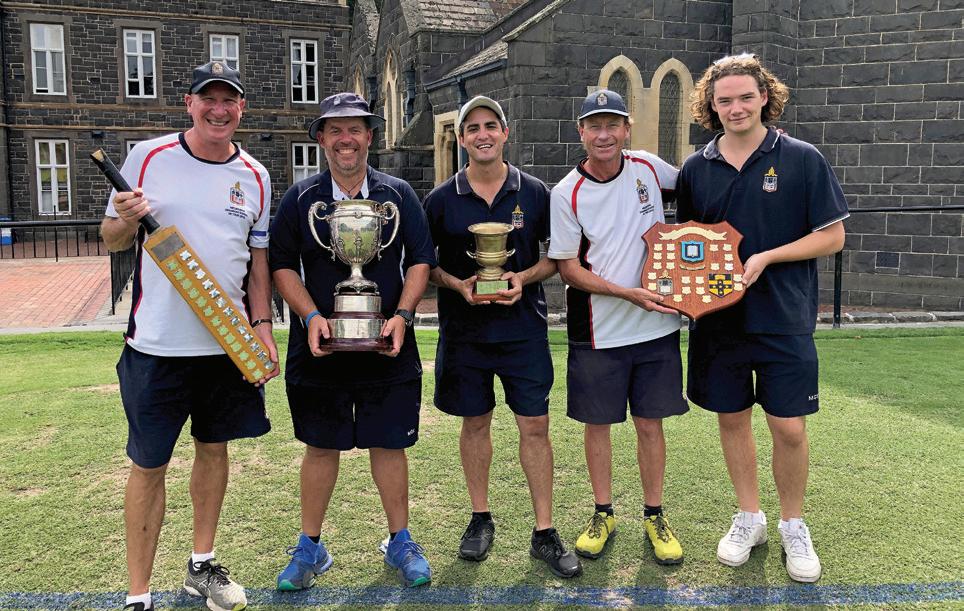
What are your thoughts on working in a school having previously worked for councils, golf courses and as a TAFE teacher? I love working in a school environment. It is a good fit for me and it is great when you find a place where you are comfortable and feel you are good at your job. It has taken me a while to feel this over my work journey. Melbourne Grammar is a great place to work as it is a great community and as ground staff we are valued and respected. We work hard at our job. The team is skilled and well qualified and we work on sharing the knowledge of what we do as a team.
What are the biggest challenges you face in managing the various Melbourne Grammar sites? As mentioned, we have three main sites with each being seven kilometres apart. This can be a logistical challenge getting machinery to the sites and spending sufficient time with
staff, as well as staff not spending enough time with each other. The other big challenge is communication across all the user groups. The school has many sporting teams across many different codes with games and training each week. We aim to be across all of these, so organisation and communication are important to get a good outcome.
How do you and your team get involved in the workplace to spread the word on what you do? Every year I speak at each of the primary, middle and senior school assemblies, giving a PowerPoint presentation to inform students and the teaching staff of what our team does and how they can assist us to create quality gardens and lawns. We also do a tour of the gardens with the new prep students each year to show them where they can play and the areas we would like them to stay out off.
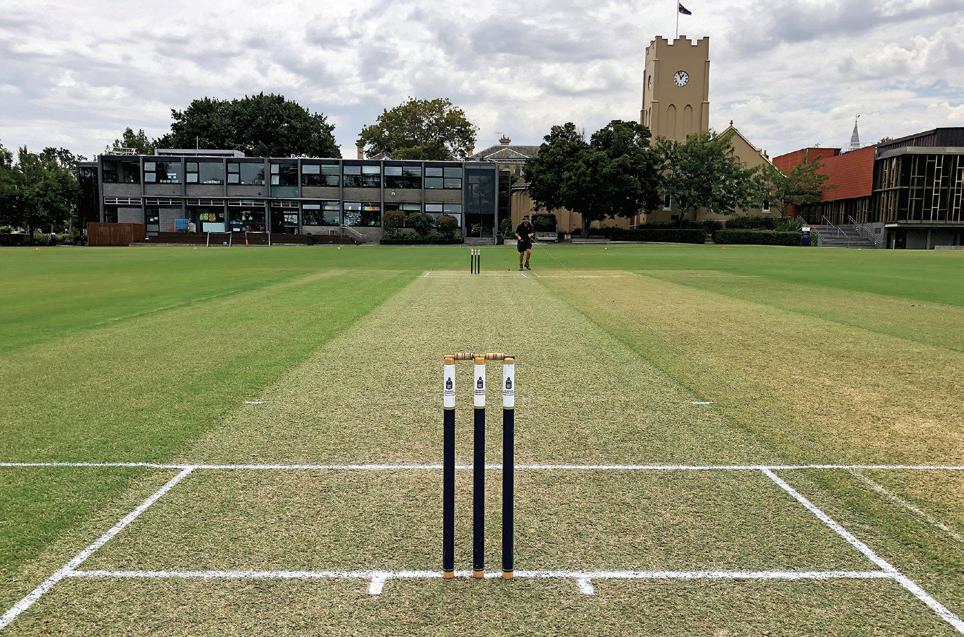
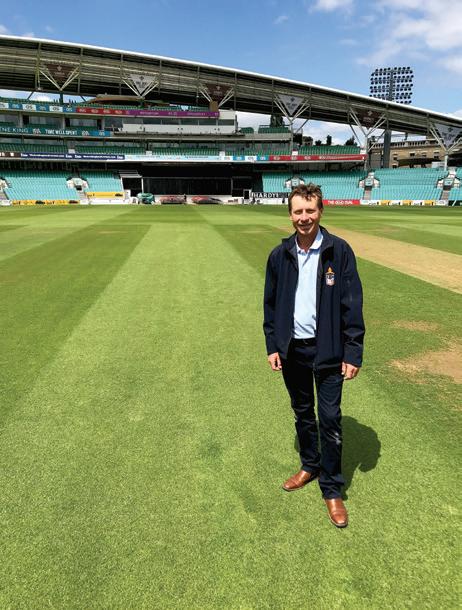
I am also involved heavily with the school’s cricket program (more on that below), several ground staff join the school’s social club activities and we also engage with the local community. Among the community initiatives we are part of include the Melbourne Pollinator Corridor and Royal Botanic Gardens Victoria’s ‘Raising Rarity’ program. This all helps sell the turf/horticultural story that leads to a better understanding of our industry and fosters greater respect of who we are and what we do. This is very important to me and something as a manager that I work hard on.
At the start of this year I was asked to give a one-hour presentation to teaching and professional staff at a training day. My team did a PowerPoint presentation giving an insight into what we do, followed by a walk of the gardens, the oval and cricket pitches, explaining how we manage and maintain these areas. The overwhelming feedback from the staff was they didn’t realise how involved it was and how skilled and passionate we are as a team.
What are your leadership principles and how do you like to manage people? First and foremost I try to set a good example by having a good work ethic, having respectful and friendly interactions with other staff, students and parents and trying to create a positive work environment. I have a few basic leadership principles and love leading a team, being a mentor and educator.
The first one is simple – have fun. We spend one third of our week at work so for me it needs to be enjoyable. Sure, there will be
Melbourne Grammar School has three campuses with Shannon and his staff managing four turf ovals, two synthetic fields, three sets of synthetic tennis courts, lawns, trees and many gardens
56 AUSTRALIAN TURFGRASS MANAGEMENT 26.2 LEADERSHIP
In addition to his role as grounds manager, over the past five years Shannon has doubled as Melbourne Grammar School’s 1st XI cricket coach. This has afforded him the opportunity to travel overseas on a number of school cricket tours, during which he has visited internationally renowned venues, among them The Oval in London (right)
times when you are under the pump and up against time pressures or the elements and it can be challenging. However, I try to create a workplace which is enjoyable and where we celebrate our successes.
The way I see it there are two types of workers – those who are passionate and want to work and learn and those who are not as interested and see it as just ‘a job’. For those who are committed and passionate, my job is to foster and develop them. They have all the basic qualities and it’s about supporting their growth. This includes giving them responsibility and opportunities to grow and develop. Sure, we all have days that are better than others, however, if the passion is there, support and backing is crucial for the individual to progress, shine and flourish and for them to be a successful employee.
With those who view it just as a job, it is important to hold them accountable for their output and encourage growth and development. Over time the hope is to develop the passion and the enjoyment will come.
As a leader I love my sayings and quotes. Some examples I use are:
l “Nothing great is easy.”
l “Education is one thing no one can take away from you.”
l “It’s never as good as it seems and its never as bad as it seems.”
l “Work hard and encourage others.”
I get a lot of satisfaction from seeing staff grow into better turf managers and horticulturalists which benefits the team as a whole. We have had a number of former staff go on to bigger and brighter things, among them Matthew Oliver who is now the ground manager at Suncorp Stadium in Brisbane and Matthew Richardson who moved to NZ and has started up his own turf irrigation business.

How do you like to manage staff? I see leadership as a privilege. I can assist in shaping people’s careers and to a certain extent their lives, so it is a big responsibility. I try to treat staff how I would like to be treated. When I went to TAFE and did my Level 3, then Advanced Certificate (Level 4) and Diploma in Sports Turf Management (Level 5), I was hoping to apply the knowledge I had gained, however, I didn’t always get that chance.
Having taught at TAFE for 15 years my strong belief is as an industry we need to grow and enhance qualified tradespeople by giving them responsibility to manage turf, not just be a turf worker. This will help retain staff in the industry as well as help them grow and develop their careers. One of my staff, Luke Cooney, often jokes with me that we have the most overqualified team in the business. My reply is “What’s the problem?” as we have qualified passionate staff who do a great job. The more qualifications the better!
What are some examples of how you practically manage your staff? I like to sit down with each staff member each year and plan their staff development and site visits for the year. I also like having a coffee with staff one-on-one numerous times throughout the year to discuss work in general, how they are progressing and to see where their enjoyment levels are at. This also helps when looking at future planning and projects.
I like to manage staff by giving them the responsibility which helps to create greater job satisfaction. The three turf managers at each of our sites manage the inputs and programs for the turf ovals, wicket tables and lawns with my support. This has allowed them to grow and develop into competent, quality turf managers. By giving responsibility, we get greater results.
We also do a cricket pitch rotation document each season for each pitch and this is run by who is looking after the wicket table. It includes the fixture, proposed pitch for each game, actual pitch used and how it performed. At the end of the season we review it and look at what worked well, what didn’t and what we can improve on for next season. This has assisted us to improve over time.
Similarly with our gardens, we now design all new gardens and refurbish all garden beds ourselves with the exception of any new major buildings. With those, we work closely with the landscape designers and have input into plant selection and design as we will be the ones looking after the landscape.
Is staff development encouraged at your workplace and are you happy to support it?
To me, staff development plays a crucial role in inspiring and educating staff and I am lucky to be working at an educational facility where this is highly regarded and supported. At work
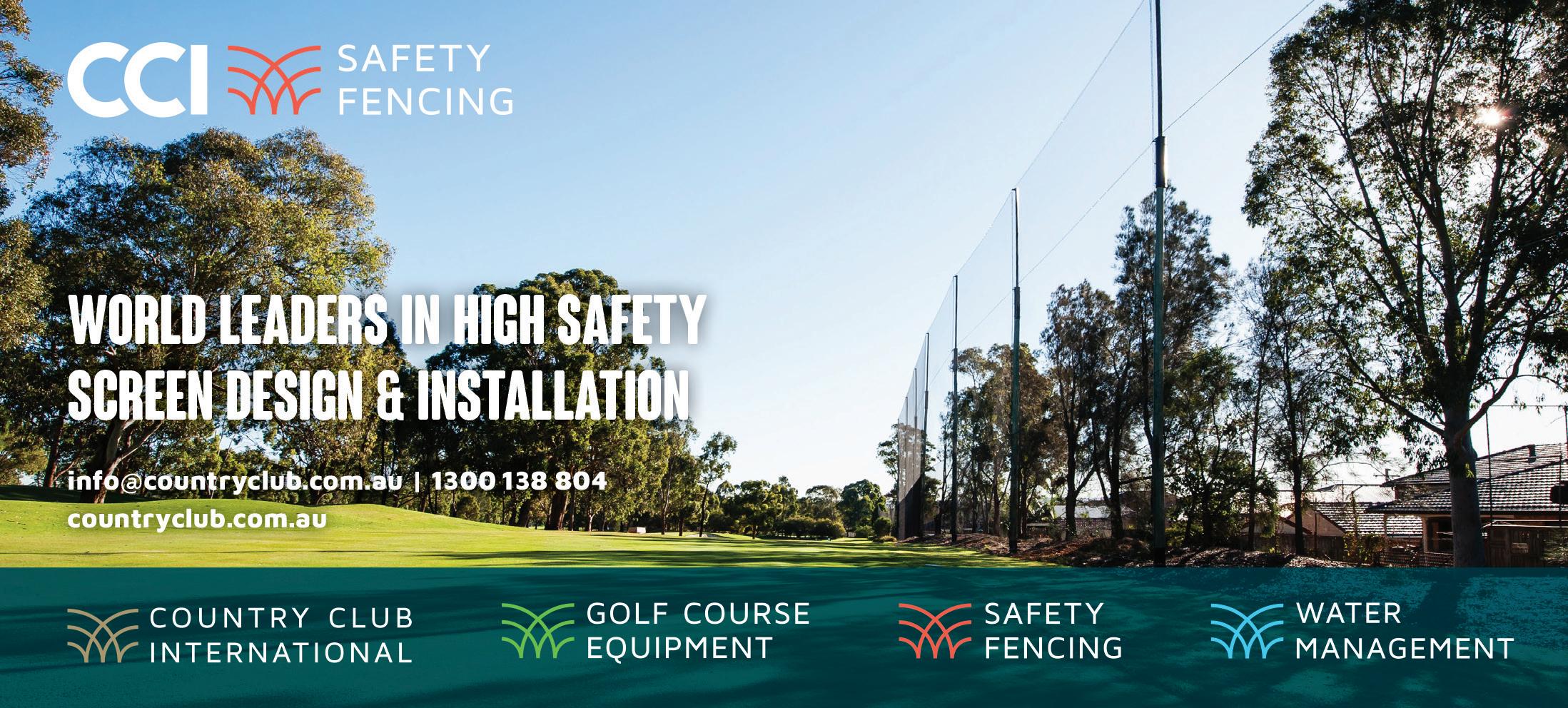
MARCH-APRIL 2024 57
The Shannon Family - Will, Jen, John, Rose and Molly


you have development opportunities which are crucial, but visiting other sites and going to industry events and conferences can be a source of inspiration.
Schools are a great community with many opportunities. Last year we approved staff development for head horticulturalist Natalie Simmons to go for five days on the Year 10 Outdoor Education program to Mount Hotham. This has allowed her to get a better understanding of the school and the teaching program. While in the Victorian High Country she took photos and researched plants from that area and we will include some of these in one of the gardens in the soon-to-beconstructed Humanities building.
You are heavily involved in the school’s cricket program. How did this come about and how do you manage it alongside your work? In 2017, the school asked me if I would like to go on the three-week UK cricket trip as a supporting coach. I was one of four staff with 28 students from Years 10 and 11. It was a trip of a lifetime and we played at some great institutions including Eaton College and Harrow School. I also visited Lords and The Oval, catching up with the turf managers at those venues. I was fortunate enough to go in 2019 and 2023 as well and will go again in June/July this year.
After initially assisting coaching in the school’s cricket program, I am now coaching the 1st XI team and am currently in my fifth year as senior coach. It makes for a very busy summer combining the grounds and cricket coaching, but I love it and all the ground staff assist to cover me when I am not there on Friday afternoons (the firsts play Friday afternoon and Saturday games in Term 1).
You are also a judge in the National Turf Industry Awards. How did you become involved in this? I very much enjoy judging in the Sports Turf Association’s national Graduate of the Year Award. I suppose I have always enjoyed awards nights and functions as I used to organise the Essendon Cricket Club presentation night and the TAFE awards when I was working at NMIT. The STA asked me to be involved around 10 years ago and I have judged alongside some great industry people including Les Burdett and Bill Rawlings. It is great to see the talent coming through the industry and I am very impressed how big companies support these awards in such a positive way.
Over your turf management journey, who have been you main mentors? During my time as a TAFE teacher I was very fortunate to work with a number of industry legends who supported and taught me with patience and knowledge. Dr Phil Ford, Gary Thomas and Peter Fitzgerald were long-time TAFE teachers, with Phil and Gary still teaching the Diploma. We also had other great teachers in Kevin Bromley and Greg Ollis who I worked with. I loved my time at TAFE and learnt so much. Over the 15 years of teaching, I taught around 1000 students. I am fortunate to know so many still in the industry and hope I have made a small contribution to their journey.
I left TAFE teaching somewhat frustrated and ready for a change, hence the decision to take on the Melbourne Grammar role. Education should be the cornerstone of the industry, however, I believe it is not delivering to the level it should at times and as an industry we need to demand more. The teachers are often under-resourced and are

pushed to enrol and pass sufficient students to keep the programs running and their jobs.
Who is your biggest supporter? My wife Jen and the family have supported me through my whole career and I greatly appreciate everything they do for me. We are blessed to have three wonderful children – son Will and daughters Rose and Molly. Jen is the one who I discuss work’s highs and lows with. She has a teaching background, so I often run my thoughts and ideas past her to get another opinion.
What do you do to relax and get away from work? Jen and I love to travel and whenever we can will take the caravan away for a weekend. Last year we went to the Mundi Mundi Bash north of Broken Hill. In 2022 we had two weeks in Vietnam. After the 2017 UK cricket trip, we did the Camino de Santigo and walked 800km across Spain. And in 2006 the family took 12 months off to caravan around Australia, which I can highly recommend. After the UK cricket trip this year we plan on doing a five-week tour of Europe for our 30th wedding anniversary which we celebrated last year.
What is your advice to people new to the turf industry? Respect is earned not given, so work hard and encourage others. Be a team player. Every experience is one you can grow from. You cannot learn everything at once, but you should be trying to learn and looking for continual growth. Seek out mentors and try to regularly catch up with them. Visit lots of sites and volunteer where possible. And to the managers, I once got told a good bit of advice which I try to go by – “Spend it like it’s your own money!”
58 AUSTRALIAN TURFGRASS MANAGEMENT 26.2 LEADERSHIP
John and Jen Shannon after completing the 800km Camino de Santiago walk across Spain in 2017
The Melbourne Grammar crew on a staff development day at the Melbourne International Flower and Garden Show. Shannon is a big believer in the crucial role that staff development plays in inspiring and motivating his team
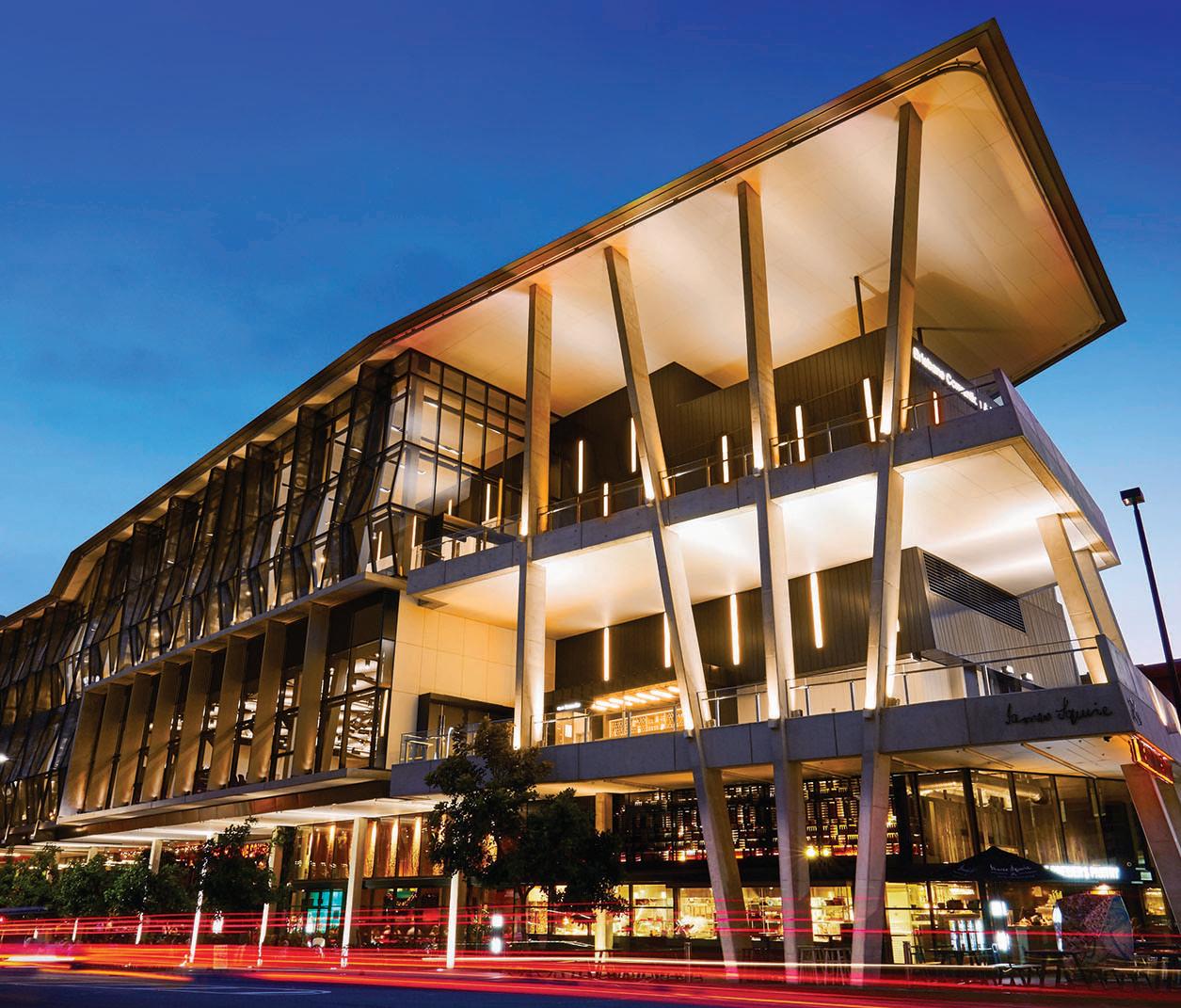




AUSTRALIAN SPORTS TURF MANAGEMENT CONFERENCE & TRADE EXHIBITION BRISBANE CONVENTION & EXHIBITION CENTRE 17-20 June 2024 REGISTRATIONS NOW OPEN www.astma.com.au/conference Dr Jay McCurdy Mississippi State University Adam Spencer Keynote Speaker & Maths Geek
Claire Madden Social Researcher
Cameron Schwab Leadership Mentor

ASTMA Bronze Partner Adama has unveiled a new high load version of its popular QualiPro Evolution fungicide. Called Quali-Pro Evolution Advance, the new product contains 370g/L tebuconazole plus 222g/L azoxystrobin. In addition, the new product also has an extended range of controlled diseases.
“Adama is at the forefront of high load technology and Quali-Pro Evolution Advance is another example of how we are striving to make use, storage and transport easier and more cost-effective for end users,” says Adama’s turf and IVM commercial manager Matt Holmes. “The rates of active ingredient per hectare remain the same, but applied rates have been reduced to 1-2.2L/ha, down from 2-4L/ha. Plus, there is the environmental benefits of less plastic in landfill.”
“As far as label extensions go, in the past 10 years a lot of research has been done on ERI diseases which shows there are more than one or two types and they do not all respond to all fungicides. Quali-Pro Evolution Advance has efficacy on ERI diseases including, but not limited to, spring dead spot, couch decline, take-all patch, summer patch (Magnaporthe spp.), summer decline (Wongia griffini) and fairway patch (Phialocephela bamuru). In addition, pythium root disfunction and pythium blight have also been added to the label, to make an all-round fungicide capable of targeting all major turf diseases.”
In other Adama product news, Quali-Pro Twister insecticide (a.i 80g/L novaluron and 320g/L indoxacarb) recently gained a label extension to include the control of caterpillars. “Quali-Pro Twister has mainly been used for

stem weevil in the past, but now with the label extension for sod webworm, armyworm and cut worm, it makes a great product far more versatile,” adds Holmes. “At 200-300ml/ha, it makes Quali-Pro Twister a very economical caterpillar control option, with residual of up to a month”.
For more information on Quali-Pro Evolution Advance and Quali-Pro Twister, visit www.adama.com/australia/en/products/ professional-and-consumer.
SAMPSON AND JOHNSON BOLSTER LIVING TURF RANKS

ASTMA Silver Partner Living Turf has added two new personnel to its teams in South Australia and Queensland. David Sampson (pictured) has been appointed as IPOS product manager for Living Turf throughout Australia and New Zealand, reuniting with IPOS team members Gerry Charlton and Craig James.
Sampson holds a Diploma of Sports Turf Management and Horticulture and started his career in the turf industry back in 2008 at The Grange Golf Club in Adelaide. He then took on a role as irrigation technician with a sports turf contractor before joining IPOS Consulting in Adelaide as a technical officer (turf and irrigation), a position he held from 2013 to 2021. In his time with IPOS he was instrumental in delivering site assessments and reporting on risk management, irrigation and turf and soils. For the past three years, Sampson transferred his skills into local government, where he has been technical officer (turf and irrigation) for the City of Mitcham in Adelaide.
“David’s willingness to seek opportunities to improve his range of skills and knowledge, along with his respectful personality, has developed him a fine reputation in the turf industry,” says Living Turf managing director Rob Cooper. “With such a strong background working with the IPOS systems, he is a great addition to our team. We are mindful of the need to continue evolving the IPOS systems and enabling our clients to benefit from the data they capture into the future, so we’re thrilled that David has decided to join.”
Sampson started his new role on 4 March and can be contacted on 0406 808 702 or email dsampson@livingturf.com.

Living Turf has also appointed technical irrigation specialist Dean Johnson (pictured) to its Queensland team. Johnson arrives at Living Turf after completing a contract as director of irrigation for Red Sea Global (a company owned by the Kingdom of Saudi Arabia – KSA) where he was part of a team tasked with transforming KSA into a world leader in luxury tourism.
Having worn both ‘red and green hats’ in his career so far, it is with Rain Bird that Johnson has made his greatest contribution to the irrigation industry. During his time with Rain Bird as a technical specialist, Johnson helped to launch a series of advanced irrigation control systems, including but not limited to IQ versions 1-4, IC and CirrusPRO.
“This opportunity with Living Turf is a great fit for me,” says Johnson. “They have amazing coverage across both Australia and New Zealand and the team I am joining is made up of very talented irrigationists.” Adds Living Turf chief executive Ashley Neuendorf: “We’ve been seeking the right person for this Queenslandbased role for over 12 months and I’m confident Dean will be a great resource for Queensland turf managers.” Johnson can be contacted on 0499 427 312 or email djohnson@livingturf.com.
NUTURF, REDEXIM STRENGTHEN TIES
ASTMA Bronze Partner Nuturf has announced its renewed partnership with Redexim through its Equipment Solutions division. Effective from March 2024, Nuturf Equipment Solutions now serves as the sole and exclusive distributor of Redexim turf equipment and machinery throughout Queensland, a strategic collaboration that marks a significant milestone for both organisations.
“We are excited to strengthen our partnership with Redexim and bring their world-class turf care equipment to our customers in Queensland,” says Nuturf’s national business lead Liam Harper. “Nuturf’s expertise, service and sales support in the
60 AUSTRALIAN TURFGRASS MANAGEMENT 26.2 AROUND THE TRADE
QUALI-PRO EVOLUTION FUNGICIDE CONTINUES TO ADVANCE
Adama’s new high load Quali-Pro Evolution Advance fungicide (left) and Quali-Pro Twister insecticide (right)
field, combined with Redexim’s innovative and high-quality equipment, now offers turf managers in Queensland unparalleled solutions for maintaining and enhancing turf conditions. This distributorship is a testament to our commitment to providing our customers with the best-in-class products and solutions.”
Redexim, a global leader in turf care equipment, is equally enthusiastic about the new arrangement: “We are delighted to have Nuturf as our exclusive distributor in Queensland,” says Redexim’s Australian territory manager Dean Scullion (pictured third from right alongside personnel from Nuturf and Redexim at the recent GIS). “Their dedication to customer service and knowledge of the industry make them the perfect partner to represent our brand in this region.”
Nuturf Equipment Solutions will offer a comprehensive selection of Redexim machinery, including their range of aerators, seeders and renovation equipment, including the popular Verti-drain.
For more information about Nuturf’s partnership with Redexim and the complete range of Redexim products available in Queensland, visit nuturf.com.au/all/redexim.
NEW GROUND FOR NEWGROUND
Western Australian irrigation market leader NewGround Water Services recently announced it has taken a major stake in mining company Silica Earth Resources (SER). While SER might not be a household name in the turf and horticultural industries, they are the mine that has brought the soil amendment Mineral Magic to the Australian market with a very significant entrance across the country and a wide array of applications.
NewGround’s managing director Bruce Scarterfield says the move is a natural
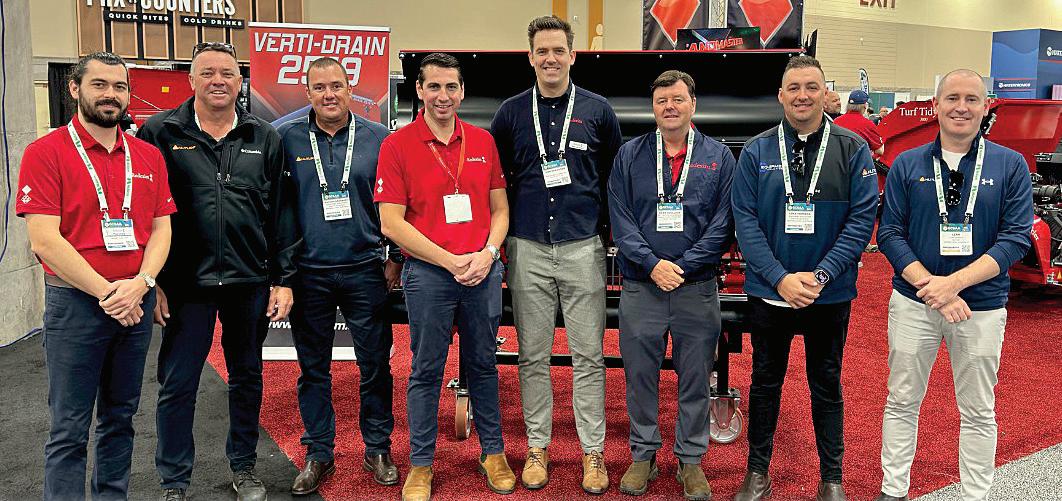
progression in the businesses charter to be a turnkey provider of water conservation, elite turf surfaces and maintenance solutions.
“It’s futile putting a state-of-the-art irrigation system into hydrophobic sand that is prevalent in Western Australia. We have been utilising Mineral Magic in several of our projects with great success and customer satisfaction. It was a no-brainer really.”
SER’s sales director Nick Clayton, the original founder of Mineral Magic, was ecstatic with the agreement: “Having known Bruce for many years as an industry leader, and most of the expert team he has put together, the support, drive and infrastructure it brings to our business will be priceless. Hopefully the combined intellectual properties of the two businesses can educate the WA market that we actually have adequate water supply in WA, just inefficient reticulation systems and practices and our soil’s ability to accept/retain the water that we are distributing.”
Clayton also noted that the company is working on several other uses and industries for the mineral (amorphous silica) that is mined in WA’s northwest and some of those will
be released to the market shortly when the conclusion of the multitude of lab tests and field trials are completed.
For more information on NewGround visit www.newgroundwaterservices.com.au. For more information on Mineral Magic visit www.mineralmagic.com.au.
THOMAS TO BASF

BASF Turf and Ornamentals Australia has appointed Grant Thomas (pictured) to the role of national business development manager. Bringing a wealth of knowledge from his 22 years in the turf and ornamental industries, Thomas, who started the new role in February, makes the move across from Envu where he was a business development territory manager for just under two years. Prior to that he was a territory and product manager with Nuturf Australia. Thomas can be contacted on 0400 617 295 or email grant.thomas@basf.com. For more information on the BASF turf range that includes products such as Pylex, Lexicon, Maxtima, Xzemplar and Drive XL, visit turf-solutions.basf.com.au.

MARCH-APRIL 2024 61
ASTMA RTO

The ASTMA conducted its third block release assessment session for students enrolled in the Certificate III in Sports Turf Management course in late March. After holding previous assessments at The Grange and Glenelg golf clubs, the most recent session was held at Adelaide Oval in the leadup to the ground’s Round 2 AFL Premiership match between Adelaide and Geelong. Myself, together with recently appointed South Australian training manager Alex Wood, assessed first and second year students across a number of units that they have been undertaking since classes recommenced for the year back in late January.
The ASTMA would particularly like to thank Adelaide Oval head curator Damian Hough, senior groundsman Pete Foreman and the amazing team at Adelaide Oval for the time and work they put in to not only accommodate our third assessment block but to make the week such a success. Pete conducted a tour of the venue, with the apprentices completing a worksheet on each of the respective turf surfaces the Adelaide Oval crew maintains. They were then split into smaller groups, supervised by Adelaide Oval staff, which allowed Alex and myself to concentrate on capturing each student completing the tasks required in the assessments.
All first year students were assessed in practical tasks relating to the Prepare Sports Turf Playing Surfaces (AHCTRF306) unit, including assisting with preparation of the main oval for Adelaide Crows training and Friday night AFL match. Tasks assessed included;
l Ball sports surface (AFL): Surface assessment; divotting the field prior to and following training; installation of training posts and nets; mowing the turf, highlighting the stripe pattern; undertaking Clegg Hammer testing for surface and soil density and compaction and recording results; undertaking soil moisture testing; and line-marking the centre square and goal lines.
l Oval No.2: Assisted with the renovation of the outfield and drop in wickets including coring and topdressing.
l Practice cricket wickets: Surface assessment; syringing three wickets; dusting bare patches in the batting boxes and bowler run ups with clippings; mowing the wicket table; scarifying wickets; rolling wickets.
l Lawn tennis: Surface assessment; removing nets; mowing and line-marking courts.
Second year students also undertook the Monitor Turf Health (AHCTRF310) and Establish Turf (AHCTRF308) units. Among the practical assessments completed included:

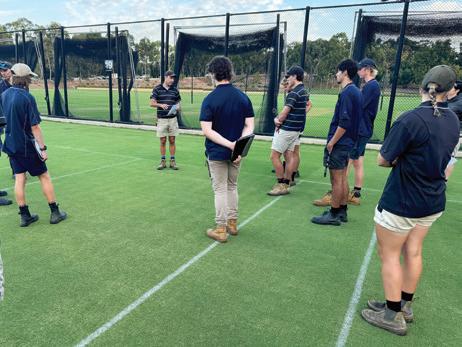
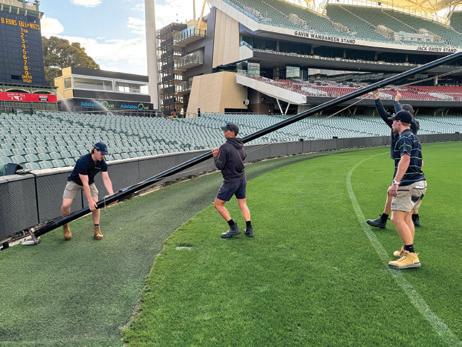
Monitor Turf Health
l Monitoring sports turf surfaces at their worksites (both a cool- and warm-season turf surface as part of general maintenance practices) for any symptoms or signs of plant stresses, reporting and recording these on a daily basis throughout the unit.
l Identification and assessing turfgrass species by common and botanic names.
l Consider a variety of treatments available as part of a larger integrated pest management program to effectively treat pest, diseases and disorders outbreaks, monitor and manage effective control and improve plant health.
l Monitor effectiveness of management efforts and consider alternatives.
Establish Turf
l Develop an establishment plan and prepare the soil to establish new turf.
l Turf establishment by vegetative means.

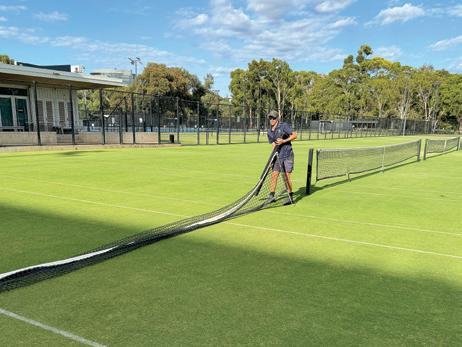
l Exercises for the preparation of turf areas ahead of sowing or by vegetative means.
l Exercises on propagation by seed using hydroseeding and dry mixes.
l Applying sufficient soil moisture.
l Post-plant care including repair work, irrigation, mowing, topdressing, fertilising and pest (collectively) treatments.
It was a great week and the group really took an amazing amount of pride in their work, knowing that they were a part of preparations for AFL training and match day. Getting the chance to experience time on an elite oval, let alone preparing one of the world’s best sporting venues and working with an extraordinary team of dedicated people over the week, was an extremely rare opportunity. We cannot thank Damian and his team enough for facilitating this experience for the students.
62 AUSTRALIAN TURFGRASS MANAGEMENT 26.2 ASSOCIATION REPORTS
ALBERT SHERRY TRAINING MANAGER, ASTMA
The ASTMA conducted its third Certificate III block release assessment session at Adelaide Oval in March
PHOTOS: ALBERT SHERRY
VGCSA

Since early February the VGCSA has hit the ground running with various projects and activities on the go. Our first education meeting in mid-March drew an enthusiastic crowd of 133 members at Metropolitan and Huntingdale golf clubs. Course tours showing recent and ongoing work at both clubs were conducted, with host superintendents John Mann and Michael Freeman discussing course management practices and providing insights into their works. The meeting also included presentations from sponsors Brandt and Greenway Turf Solutions.
The day began at Metropolitan which is midway through a course enhancement project under the auspices of architects Crafter and Mogford. At the start of last December, the front nine was closed, with all greens profiles replaced and some minor design changes incorporated. The primary focus of the works has been to reinstate a more traditional Sandbelt rootzone profile within the greens in order to provide the firm and fast characteristics that the region is renowned for.
As part of the works, the existing USGA profiles have been completely removed and replaced with a modified Californian construction. After trial work and testing, a new rootzone mix containing a blend of native sand mined on site and a Burdetts sand has been used which meets the desired drainage rate of around 100mm/hour. The existing SR1019/ SR1020 greens turf, some of which is over 30 years old, was sod cut off the greens and stored on tarps before being re-laid.
Works to the front nine also saw a number of minor design tweaks and the reinstatement of features harking back to the club’s early days. The most significant change has occurred on the 6th hole, in particular around the green. In addition to extending the fairway past the left-hand fairway bunker by about 10-15 metres, mounding around the 6th green complex has been softened. The greenside bunker on the left has been reduced and some tree removal has allowed the green surround to be extended so that it now has better scale and sits more naturally within the landscape.
Elsewhere, the club has reinstated the ‘Alister MacKenzie’ bunker on the right-hand side of the 3rd hole about 80m out from the green. To accommodate that, the left-hand side fairway bunker has been moved back slightly. They have also expanded the bunkering on the inside of the dogleg on the 9th hole, recreating the shapes of the old 10th greenside bunkers that were once in that location as part of the course’s original routing in the 1930s. Other changes have been made to tee complexes, with the par three 7th tees moved 7m to the right and the 9th tees moved 10m to the left.

Following the walk around Metropolitan, the group headed across to Huntingdale which is currently in the early stages of a complete rebuild by OCM Golf. The first stage of works are focusing on the old back nine holes, with some of the major changes being the construction of a new 36 megalitre irrigation dam. During the visit, works were well progressed on the shaping of the major new 12th-18th double green, while the new 17th green had been roughed in. The new greens will be seeded with Pure Distinction bentgrass.
At the time of writing this report, nominations for the 2024 VGCSA Superintendent and Trade Recognition Awards were due to close. We look forward to presenting the winners at the VGCSA’s 97th Annual General Meeting which will be held at Yarra Yarra Golf Club (superintendent Clint Raven) on 29 April. A further announcement on the day will be the launch of the VGCSA’s 2024-2027 Strategic Plan. A digital version will be issued to all VGCSA members and will also be available on our website.
We also wish to commend our recently announced winning candidates. These include VGCSA Golf Turf Apprentice of the Year Darren Wardle (Royal Melbourne GC), who was nominated by Melbourne Polytechnic, along with the two VGCSA/John Deere-Brandt Scholarship winners who will be heading to New Zealand in late April/early May to undertake a one-week placement at Te Arai Links and Tara Iti Golf Club. The successful scholarship winners are Kate Rainsbury (The Dunes) and Nick Skicko (Metropolitan GC). Our thanks goes to sponsors John Deere and Brandt for supporting this fantastic opportunity.
Once again, the VGCSA is very pleased to be partnering with Toro Australia this year to provide course members the opportunity to undergo turf equipment management training. Three workshops in April and May will cover sprayer training and cutting units and will range from introductory to advanced level learning.

Planning and research is also well underway in preparation for the VGCSA Centenary in 2027. The association will produce a centenary publication to showcase pioneers, innovations, fellowship and standout events that have shaped the VGCSA and golf turf industry overall. Last September, the VGCSA appointed author Nicholas Brasch who has written numerous corporate histories throughout his career. VGCSA Centenary subcommittee member Colin Winterton has taken on the role of ‘roving reporter’ and, since January, has been travelling across the state to conduct audio interviews in person, in addition to other interviews via email.
Finally, we are looking forward to busy few months ahead with most of our guest speakers confirmed. These include;
l Meteorologist Jane Bunn (97th AGM);
l Former USGA Green Section Record editor and now consultant Adam Moeller (June course staff education meeting);
l Dr Jim Brosnan and Dr Brandon Horvath (University of Tennessee), Mark Hooker (Royal Auckland & Grange GC) and John Neylan (SportEng) – July Country meeting;
l Dr Shawn Askew (Virginia Polytechnic Institute & State University) – September education meeting).
It is set to be a bumper year and we look forward to welcoming as many members as possible at each event.
MARY NAPIER CEO, VGCSA
MARCH-APRIL 2024 63
The VGCSA held its first meeting of 2024 with tours at Metropolitan (pictured) and Huntingdale golf clubs
GCSAWA

The last week of March was a busy one for the Western Australian turf industry, with 90 people turning out for the TAFE Awards Night where 25 students received their Certificate in Sports Turf Management qualifications. As part of the evening, Lake Karrinyup superintendent Fraser Brown spoke on his journey from rural Scotland to the Ukraine, Bahrain, Kalgoorlie and finally Lake Karrinyup. Last year’s GCSAWA and ASTMA Graduate of the Year recipient Jayden Zappelli also talked on his short but busy career to date, starting in Kalgoorlie and recently moving to Royal Perth.
While completion numbers are encouraging each year, the toughest part is encouraging the newly-graduating class to further their careers, move courses and get out of their comfort zone. At the end of March there were five WA clubs looking for an assistant superintendent, but applicant numbers were very low despite some clubs offering fuel, overtime and a decent wage totalling $100K.
Two nights later, the WA Golf Industry Awards gala dinner was held at The Crown Ballroom in Perth with almost 500 people in attendance. Some high quality nominations from all over WA, including Esperance, Karratha, Kalgoorlie and across the metropolitan area, made judging tough. Secret Harbour Golf Club’s Tom Tristram received our Superintendent of the Year Award, while Beschen Pou (Rockingham GC/Links Kennedy Bay) was named Apprentice of the Year. Both awards were sponsored by our good friends at AFGRI Equipment.
Tom headed a quality field of finalists that included Fraser Brown (Lake Karrinyup CC), Brad Pavlinovich (The Vines Resort) and Ashley Watson (Joondalup Resort). Tom has been superintendent at Secret Harbour for nearly three years where he manages a very young crew and has had to battle a number of neighbour/safety issues. This has meant the building and movement of several tees and fairways being realigned. His unique practices include injecting several different seaweeds through the irrigation system, reducing fertiliser and wetting agent and improving overall turf health. A new pump station, splitting block stations from up to 20 sprinklers down to four, reintroducing natives around the course plus construction of a new chipping green have also kept Tom and his team busy.
Beschen beat home fellow apprentice finalists Jason Gangell (Gosnells GC), Curtis Lee (The Western Australian GC) and Bevan Sholdas (City of Bayswater). Beschen found his passion for greenkeeping at an early age, following in the footsteps of his superintendent father in his native New Zealand. After moving
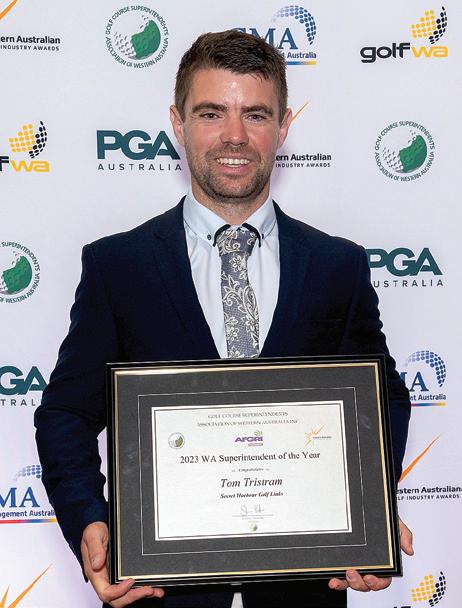
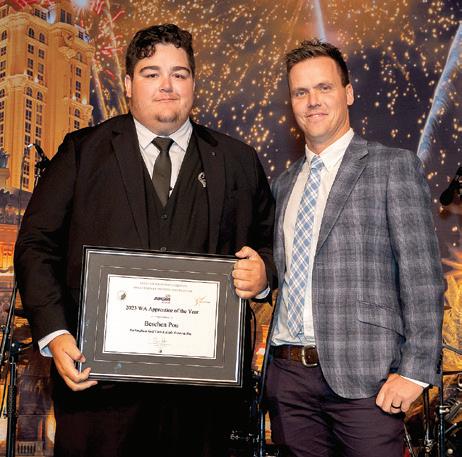
to Perth and finishing school, he started his apprenticeship at Rockingham Golf Club before moving to Links Kennedy Bay where he is currently foreman.
Since arriving there, Beschen has been heavily involved with the current course redevelopment and given the opportunity to manage both the old and new irrigation systems. Having completed his apprenticeship, he is now undertaking a Bachelor of Science in sustainability with the University of Tasmania. Beschen will now represent the GCSAWA in the ASTMA Graduate of the Year Award final.
The two GCSAWA awards were among a total of 18 that were presented on the night, with the Regional and Metropolitan Golf Course and Golf Facility of the Year categories among the most eagerly anticipated. Karratha Country Club, home to superintendent Callum Hitching, proved a very popular winner of the Regional Golf Facility of the Year, with judges praising the “remarkable turnaround” in the club’s fortunes after financial difficulties threatened its very existence in 2022. During a standout 2023, Karratha CC’s notable
achievements included a 61 per cent increase in revenue and a membership increase of 73 per cent, while spending $430,000 on improvements to its course and facilities.
The Metropolitan Golf Facility of the Year went to Wembley Golf Course (superintendent Darren Wilson) which was described on the night as having set “the gold standard for public facilities across the country” and for being “a truly remarkable facility”. As well as growing membership of Wembley Public Golf Club by 20 per cent in 2023, Wembley delivered over 185,000 rounds of golf and 65,000 rounds of mini golf, while more than 26 million golf balls were hit on its driving range. Bunbury Golf Club (superintendent Dave Brennan) was announced as the Regional Golf Course of the Year, while Joondalup Resort (superintendent Ashley Watson) –which hosted the 2023 WA Open – won the Metropolitan equivalent.
While autumn has begun and we’ve had the odd dewy morning, the days here in Perth have been hovering around 30 degrees since mid-March and even into the first week of April we haven’t had a drop of rain. Perth’s official rain gauge shows we’ve had only 20mm since the end of September! I’ve got 3500 native plants being delivered mid-April for the course, so hopefully we get some rain soon!
SHANE BAKER PRESIDENT, GCSAWA
GCSAQ

The GCSAQ, in conjunction with STA Queensland, hosted a Greenkeeper Mechanical Day in Brisbane on 19 March. Nearly 60 attendees, including 17 apprentices from TAFE Queensland, converged on Nudgee Golf Club (superintendent Peter Culross) for the day which aimed to educate course maintenance staff about the operation of cylinder and rotary mowers and how they cut and the basics of reel, bedknife and blade maintenance.
Geared towards all course staff and not just mechanics, the day covered specific topics around the agronomy benefits of maintaining sharp cylinders and bedknives and the operation and objectives of cylinder and bedknife grinding utilising Bernhard grinders. This also covered routine maintenance such as backlapping, reel-to-bedknife setup and height of cut. The second session touched on rotary mower blade sharpening, balancing and the maintenance of spindles and grease points.
MARK HAUFF PRESIDENT, GCSAQ
64 AUSTRALIAN TURFGRASS MANAGEMENT 26.2 ASSOCIATION REPORTS
GCSAWA Award winners Tom Tristram (top –Superintendent of the Year) and Beschen Pou (above – Apprentice of the Year, pictured with Jack Latchford from awards sponsor AFGRI Equipment)
TMSA

Turf Management South Australia members hit the road in March for our first regional site tour which took in a number of turf facilities. Ahead of hosting two matches as part of the AFL’s Gather Round, the first stop was The Summit Sports and Recreation Park in Mount Barker. This provided a great opportunity to inspect the oval as the team geared it up for Gather Round, the infrastructure build required and turf management preparations to get the ground to AFL standard.
Our second stop was at Bordertown Golf Club for lunch and a round of golf. That was followed by a dinner which included guest speakers Simon Adermann (Lawn Solutions Australia), Micheal Sutton (AusGAP) and Daryl Sellar (Living Turf).
Following an overnight stay in Bordertown, the final stop was at Sunnyside Instant Lawn on the town’s outskirts. After a BBQ breakfast, the group were able to take a close up look at the turf farm operation and get an appreciation as to what is required to run such a large business. Buses transported the group to the turf farms where the sheer size and technical advancements were impressive to see. Our appreciation is extended to each of the venues for hosting us, the various guest speakers and to those that attended part or the entire tour.
The next TMSA event will be the Industry Golf Day to be held on Monday 20 May at North Adelaide Golf Course. You can download a registration form through www. turfmanagementsa.com.au. Our annual turf seminar has also been confirmed for Tuesday 13 August at Morphettville Racecourse.
April has been a huge month for the sports turf industry in Adelaide with another successful AFL Gather Round held across three venues – Adelaide Oval, Norwood Oval and Mount Barker. Congratulations to all the crews involved in delivering another great weekend.
On the morning of the first match of Gather Round, the SANFL hosted a Turf Talk promotion event at Adelaide Oval with more than 80 in attendance. Adelaide Oval chief executive Nick Addison welcomed guests initially before Belinda Marsh (SANFL head of infrastructure and government relations) provided an update on her role, the targeted increase in player participation numbers and the resulting impacts and demands for sufficient number of playing surfaces. Adelaide Oval head curator Damian Hough and Daryl Sellar spoke on best practice turf management planning and maintenance, including case studies of community venues all the way through to AFL standard.
The opportunity was then taken to walk on the hallowed Adelaide Oval turf to inspect
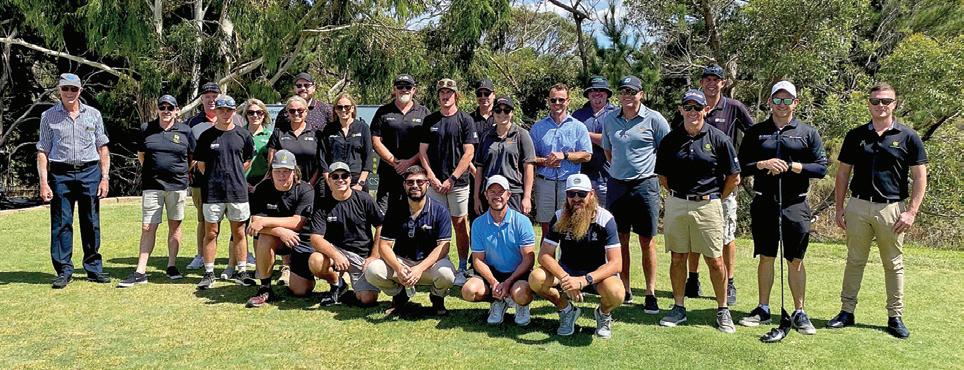

the ground first hand before getting a behindthe-scenes look at the crew’s equipment and workshop area. The TMSA extends its appreciation to the SANFL for allowing our members, sponsors and industry colleagues to attend this event.
In the aftermath of Gather Round, SA Premier Peter Malinauskas announced that the SA Government would be partnering with The Barossa Council to help take one of next year’s matches to the famed wine region. The State Government and The Barossa Council will each contribute $20 million, with support from Barossa District Football and Netball Club, to undertake a full upgrade to facilities at Lyndoch Recreation Park. Labelled the Barossa Park Project, it will see the existing Lyndoch oval upgraded to meet AFL standards and deliver a precinct fit for multiple sports at community and professional levels, as well as opening up new opportunities for festivals, the arts and conferences to come to the region.
Finally, as this edition was going to print, the crew at The Grange Golf Club were busy preparing for the return of LIV Golf Adelaide. Following the breakout success of the event last year, the composite course was looking in

superb condition when TMSA visited in early April, with tournament infrastructure going up rapidly. We wish superintendent Rowan Daymond and his tournament crew all the best for another world-class event!
ON THE MOVE…
BEN HARTLEY: From foreman Freeway GC, Vic to assistant superintendent Ranfurlie GC, Vic.
DAVID MASON: Resigned as superintendent at Brisbane GC, Qld. LUKE NOWLAN: From superintendent Ipswich GC, Qld to superintendent Oxley GC, Qld.
MARCH-APRIL 2024 65
NATHAN BENNETT PRESIDENT, TMSA
Adelaide Oval head curator Damian Hough outlines preparations ahead of the venue’s opening AFL Gather Round match
Top and above: Turf Management SA hosted its first regional site tour across two days in mid-March. Venues visited included The Summit Sports and Recreation Park in Mount Barker, Bordertown Golf Club and Sunnyside Instant Lawn turf farm
NSWGCSA

We’ve certainly had a hot, humid and wet summer and I know that managing a golf course during these times presents a unique set of challenges. In January, we sent out an email encouraging NSWGCSA members to reach out for any assistance, by way of advice, best practices and resources. It has been encouraging to see some of the responses, highlighting to us that the support and solidarity of our association and our members is vital.
Attracting talent to our industry is also critical for the future success of our industry. Our Vince Church Graduate of the Year Award, sponsored by Toro, is just one way of acknowledging new talent. In March, we were delighted to announce this year’s finalists – Daniel Adelt (Kew CC), Brandon Vella (Campbelltown GC), Jesse Bradshaw (The Vintage), Alexander Lark (South West Rocks CC) and Matthew Ward (Royal Sydney GC). Judging took place at the end of March and we were pleased to announce that the winner was Brandon Vella who will now go on to represent the NSWGCSA in the ASTMA Graduate of the Year Award, sponsored by Toro, which will be judged at this year’s Brisbane conference.
The Vince Church Award recognises the completion of the Certificate III in Sports Turf Management and a commitment to the
ACTSTMA

It has been a busy few months in the nation’s capital with the Yowani Country Club (superintendent Justin Haslam) course redevelopment well underway. Royal Canberra Golf Club (superintendent Ryan Stores) also re-opened its front nine after converting tees and fairways to Santa Ana couchgrass. The new surfaces were back in play on 12 March and from all reports the conversion has been a massive success with the front nine looking immaculate. The club is looking forward to converting holes 10-18 at the end of the year.
An important issue affecting most golf clubs these days is financial longevity and like a lot of clubs Yowani is no different. As such, they put out a tender to sell a parcel of land to give the club a financial boost. Interestingly the parcel of land chosen to be sold currently has the clubhouse, maintenance facility plus the 1st and 10th tees and 9th green.
The sale of land meant a relocation of the clubhouse and a reconfiguration of the golf course, with Contour Golf (Ben Davey) selected as course architect. Even though only a small parcel of the course was lost, it was agreed that a full course redesign was the way
industry as judged by the NSWGCSA’s expert panel of course superintendents and life members. Among those were former Liverpool Golf Club superintendent Mark Schroder and former Northbridge Golf Club superintendent Mal Harris who were both effusive in their praise of Brandon.
“Brandon was very impressive,” commented Schroder. “For someone in his early 20s, his overall knowledge and understanding of turf management disciplines and procedures was excellent. Brandon’s delivery processes at an interview level contained detail and thoughtfulness, while his passion and drive were viewed by the panel as key ingredients that a young turf manager of the future requires. We congratulate Brandon as the Vince Church Award winner for 2024 and wish him all the best in the upcoming national final.” Added Harris: “We found Brandon to have an excellent knowledge of turf management and were impressed with his professional attitude. He is a worthy winner of this award and has a great career ahead.”
Elsewhere, Pambula-Merimbula Golf Club superintendent and NSWGCSA Board member Pat Wilson hosted an education day at Moruya Golf Club (superintendent Brent Hull) on Wednesday 20 March. Thanks to our sponsors Nuturf and Equipment Solutions. We also hosted an education day at Toronto
Country Club (superintendent Aaron Cachia) on 16 April sponsored by Ventrac Australia.
Our two big annual events are currently being planned, with the John Deere|Hutcheon & Pearce Ambrose Day to be held on Monday 20 May at Wollongong Golf Club and the Elite Sand & Soil Rube Walkerden Day on Monday 18 November at Pymble Golf Club. We look forward to seeing our members and sponsors at these major association events.
In early April we were delighted to confirm the appointment of four new NSWGCSA Board directors following the recent departures of Gareth Hammond (Terrey Hills G&CC) and Jake Gibbs (Elanora CC) due to work commitments. We have welcomed Anthony Mills (The Lakes GC), Will Ockenden (Shoalhaven Heads), Luke Diserens (Northbridge GC) and James Taylor (Bayview GC). They join the existing NSWGCSA Board that includes myself as president, David Stone (treasurer, Pymble GC), James Newell (Magenta Shores) and Pat Wilson (PambulaMerimbula GC). It is great to have this injection of experience and youth to the committee and I wish them all the best in their roles. I’m sure they will make valuable contributions to the Board’s mission and vision.
LEON HENNESSY PRESIDENT, NSWGCSA
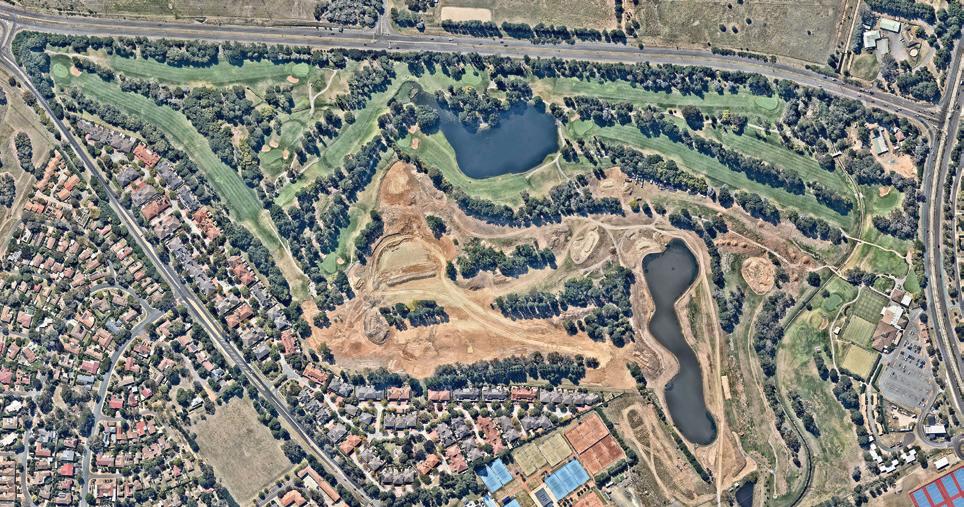
to go, along with a new irrigation system, two additional dams and reshaping of the existing dams and a new maintenance facility. The site is to be redeveloped over three years, with Flemming Golf starting work last December.
On 5 March, around 30 ACTSTMA members from across all areas of the turf industry had the chance to view the current Stage 1 works in progress, including the new 1st and 2nd holes along with the construction of one of the new dams which will have a capacity of 18 megalitres.
The design that Contour Golf has come up with is quite different to the existing layout, with more undulations not only on the fairways but the greens complexes as well. It is intended once these initial greens have been completed that the ACTSTMA will return for another visit as construction progresses. We wish the club well and look forward to seeing the new course come to life over the next couple of years.
SIMON SNEDDEN COMMITTEE, ACTSTMA
66 AUSTRALIAN TURFGRASS MANAGEMENT 26.2 ASSOCIATION REPORTS
PHOTO:
NEARMAP
Work started in December 2023 on the redevelopment of Yowani Country Club in Canberra
MCLEAN DEPARTS SANCTUARY COVE FOR SINGAPORE ISLAND CONSTRUCTION ROLE
Long-time ASTMA member and past GCSAQ president Paul McLean finished up as superintendent at Sanctuary Cove Golf and Country Club on 22 March. After nearly a decade in charge of the 36-hole Gold Coast establishment, McLean has left to take on a construction superintendent role at Singapore Island Country Club (SICC) which is embarking on the redevelopment of its Island Course.
McLean, who was president of the GCSAQ for eight years up until last year’s AGM, tendered his resignation at Sanctuary Cove in late February, bringing to a close a significant chapter in his turf management career which has spanned nearly four decades. McLean took over at Sanctuary Cove in August 2014 and during his tenure oversaw a number of major improvements. Principal among those was the $5 million redevelopment of the Arnold Palmer-designed Pines course in 2021 which saw all greens reconstructed to USGA spec and turf converted from 328 to TifEagle. The restoration also included bunker works, the rebuilding of teeing grounds and installation of a brand new Toro irrigation system.
Upon announcing that McLean was leaving, Sanctuary Cove noted on its website: “It is with mixed emotions that we will farewell Paul as he embarks on a new chapter in his career and life… Paul has been an invaluable member of our team for nearly 10 years, during which he has exhibited unwavering dedication and commitment to maintaining the excellence of our golf courses and facilities. His leadership, expertise and passion for the job have contributed significantly to the success and reputation of our club.”
Singapore Island Country Club is Singapore’s oldest and largest golfing institution and is undertaking the redevelopment of its Island Course which is expected to be completed by late 2025. Course architect firm Nelson & Haworth was appointed late last year, with construction works starting on the back nine in March. McLean began his new role on 1 April and will be the club’s representative throughout the construction period. The front nine holes will remain open for play until the third quarter of this year, after which all 18 holes will be closed. The new back nine is expected to be reopened in the first quarter of 2025, followed by the front nine in the third quarter of 2025.
On its website, SICC says: “The redesigned course will feature all weather playing surfaces via an extensive sub-surface drainage system and sand capping and cutting-edge bunker designs and materials to reduce bunker washouts. The SubAir system for the greens and the latest improved Zoysia grasses (wall-to-wall) will reduce the usage of fertilisers, disease and weed intrusion, with
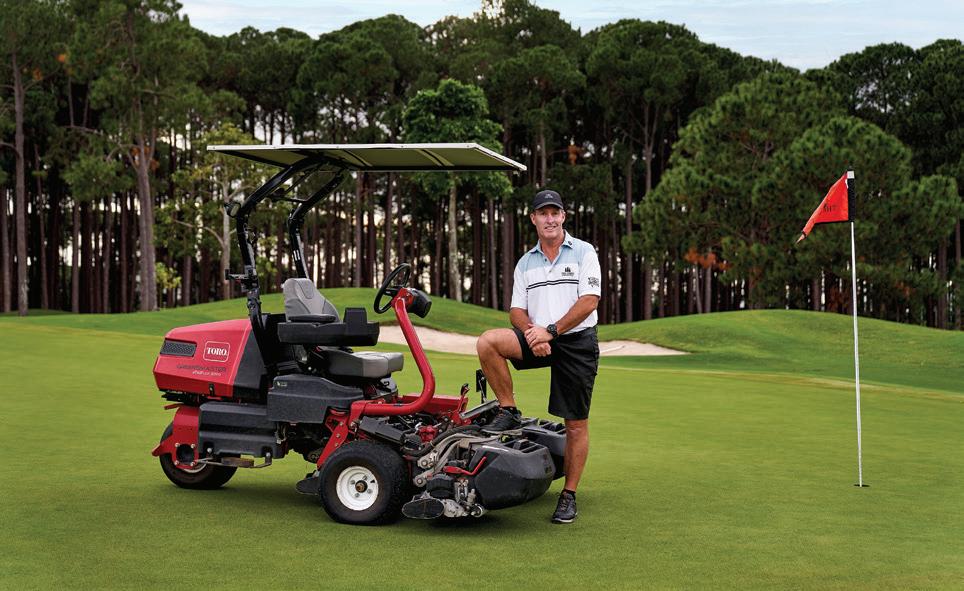
improved drainage to allow for play even after heavy downpours. With a reduction of steep dangerous slopes and blind shots, the design enables us to retain the original tree corridors and vista views across the Lower Peirce reservoir and distinctive native forested areas which define the Island Course.”
WILSON MOVES FROM MOONAH
After 16-and-a-half-years as superintendent at Moonah Links, Kyle Wilson announced he was on the move in April. The 2023 VGCSA Superintendent Recognition Award winner is heading 20km down the road after being appointed as the new superintendent at Portsea Golf Club.
Starting his new role on 29 April, it will be a reconnection of sorts for Wilson who worked at Portsea earlier in his career. Between 1989 and 2007, Wilson was part of the team at The National Golf Club, initially completing his apprenticeship while working on the newly constructed Old Course. He then became the assistant superintendent under Nick Rennison, both working for Bruce Grant who was director of Scotch Grange when the company expanded to include looking after Portsea and consulting work at Rosebud CC. With two new courses constructed at The National (Moonah and Ocean), Wilson was appointed superintendent of the Greg Norman-designed Moonah Course from 2000-2007.
After The National, in August 2007 Wilson took over as superintendent at the 36-hole public access Moonah Links facility. In that role Wilson would oversee maintenance operations of the Open and Legends courses which sprawl across more than 200 hectares. During that time, Wilson guided his team to prepare the Open course for three Moonah Classic tournaments between 2008 and 2010 that were part of the US PGA’s Nationwide Tour. More

recently, Moonah Links has been home of the Victorian PGA Championship as well as the PGA of Australasia’s Qualifying School.
From a course perspective, managing a large site with a small crew meant Wilson had to judiciously manage his maintenance resources and streamline practices. Despite that, he was able to undertake a number of projects during his time, including the reconstruction of numerous tees, construction of a new 2600m2 putting green and significantly improving the approaches by oversowing them with fescue.
“I really enjoyed my time at Moonah Links, but moving to Portsea is a huge opportunity at this stage of my career and one I am really looking forward to,” says Wilson (55). “It’s a great course on a great parcel of land and the club has some exciting plans. Among them is an upgrade to valve-in-head sprinklers on the fairways in place of QCVs, so I’m looking forward to actioning those improvements and getting the results on the board for the club.”
MARCH-APRIL 2024 67 ON THE MOVE
New Portsea Golf Club superintendent Kyle Wilson
After nearly a decade in charge of Sanctuary Cove, Paul McLean has taken on a new role at Singapore Island CC
BIOLOGY AND INTEGRATED MANAGEMENT OF TURFGRASS DISEASES
By Gary W. Beehag, Nathan R. Walker, Percy T.W. Wong and Jyri Kaapro | CABI, 304 pages. Reviewed by John Neylan
Turfgrass diseases are ever present and can have a devastating effect on the quality of turf surfaces whether they are golf greens and fairways, bowling greens or sportsfields. With a climate that seems to have become less predictable and the influence that it has on the occurrence of diseases, the recently released Biology and Integrated Management of Turfgrass Diseases will prove to be an important reference for anyone involved in the turf industry.
Compiled by Australian experts Gary Beehag, Dr Percy Wong and Jyri Kaapro, together with Oklahoma State University IPM and turfgrass pathology specialist Dr Nathan Walker, this 304-page book is a comprehensive and up-to-date reference on everything to do with turfgrass diseases. It will be of interest to anyone involved in the turfgrass industry whether they are a turf manager, student, agronomist or researcher.
As the title suggests, Biology and Integrated Management of Turfgrass Diseases provides an integrated or holistic view of all the elements that result in infection and then symptom expression of many turfgrass diseases. It covers all of the major diseasecausing organisms in both warm- and cool-season grasses. It focuses on the environmental and management-induced factors influencing pathogen growth and development and expression of their respective diseases. This provides the basis for then formulating integrated disease management plans based on implementation of diseaseresistant cultivars and biosecurity and hygiene practices in combination with proven cultural, biological and chemical technologies.
The book comprises 11 chapters that cover in detail all of the factors that result in the expression of a turfgrass disease. The book has a central aim of educating the reader on all the interrelated factors that result in a disease occurring and allows the reader to work through why a disease is occurring and not just how to control it with a chemical application. The book is written in a way that leads you through the factors that result in the expression of a disease before it goes into the detail of individual disease organisms.
The opening chapter sets the scene with a detailed review of turfgrass ecosystems and what makes turfgrasses susceptible to disease outbreaks. It highlights new disease organisms identified and the economic impact of turfgrass diseases in a turf management setting. This is followed by a detailed treatise on the environment, host and pathogen interactions.
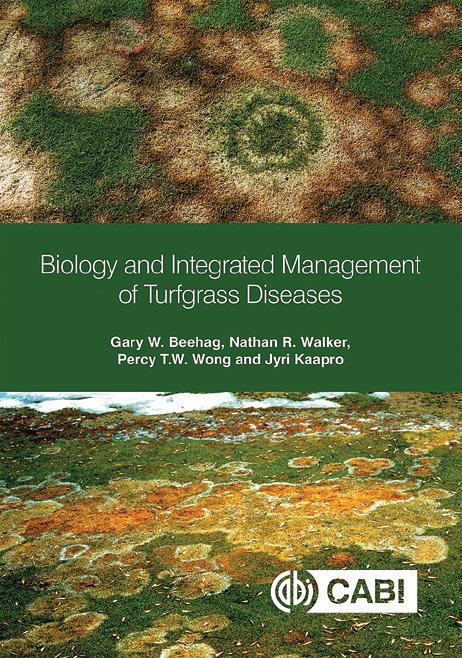

This section emphasises the complex interactions between these key factors and why a disease may occur and the severity of the disease. This provides turf managers with an excellent insight into what factors are contributing to disease and how these may be better managed to reduce their impact. Again, it provides turf managers with a strategy to reduce the impact of disease without necessarily reverting to chemical control.
In keeping with understanding when a disease may occur, there is a detailed chapter on monitoring and forecasting disease outbreaks as well as the process of sampling and identification. This chapter highlights the importance of monitoring weather conditions and the recognition of early signs of turfgrass disease outbreaks. The information provided
allows a proactive approach to disease control which will minimise turf damage and allow for more effective control. It will also reduce the use of chemicals used to control diseases.
The authors have emphasised the importance of thorough diagnosis and reporting of diseases. This involves how a sample is collected and preserved before it is sent to the laboratory and using a laboratory that has qualified plant pathologists that can identify the pathogens present and the primary pathogen that needs to be controlled.
There are separate chapters dedicated to cool weather and warm weather fungal diseases. These chapters provide detailed descriptions of all of the diseases that are likely to occur on maintained turfgrass surfaces, including the environmental and management conditions that can lead to a disease outbreak. The descriptions are supported by excellent photographs and diagrams.
The book not only covers fungal pathogens but also other disease-causing organisms including bacteria and viruses. This section covers in some detail the disease caused by Bacterial Wilt which has only in recent years been observed on Poa annuadominated putting greens in Australia. What this section highlights is the importance of accurate diagnosis as these pathogens can visually look like more common pathogens.
The penultimate chapter covers plant parasitic and beneficial nematodes, their biology and population dynamics. Given the economic impact of a nematode outbreak and the challenges of effective control, this chapter is a good reference for turf managers. The final chapter details the range of synthetic fungicide and novel biofungicide formulations available for the control of turfgrass diseases and how they are best applied to maximise efficacy.
Biology and Integrated Management of Turfgrass Diseases is a well-researched book with an extensive review of the scientific literature. In itself the book is an excellent literature review for those involved in turfgrass research. While the book has an international application, it has an excellent update on the Australian patch diseases that have severely impacted warm-season grasses over the past 20 years. The book is well supported with high quality photographs, diagrams, tables and key point summaries and has an emphasis on understanding why diseases occur and how they can be controlled or their impact minimised by manipulating the turfgrass environment.
Biology and Integrated Management of Turfgrass Diseases is available in hardback and digital (ebook) formats through CABI. Visit www.cabidigitallibrary.org and search the title for further details and pricing.
68 AUSTRALIAN TURFGRASS MANAGEMENT 26.2 BOOK REVIEW
Co-author Gary Beehag speaking at last year’s Australian Sports Turf Management Conference
AGCSATech Independent, Analytical, Diagnostic and Consultancy Services AGCSATech Independent, Analytical, Diagnostic and Consultancy Services l EXPERT AGRONOMIC ADVICE l GOLF COURSE, SPORTSFIELD AND RACETRACK ASSESSMENTS l DESIGN AND CONSTRUCTION SPECIFICATIONS l PROJECT MANAGEMENT l SOIL, PLANT AND WATER ANALYSIS l DISEASE AND NEMATODE DIAGNOSIS l COST EFFECTIVE NUTRITION AND MAINTENANCE PROGRAMS l WATER MANAGEMENT PLANS l DRONE DIAGNOSTIC SERVICES AND AERIAL IMAGERY The Australian turf industry’s leading provider of independent agronomic services. CONTACT THE AGCSATECH TEAM (03) 9548 8600 Senior agronomist - Bruce Macphee Agronomist - Tim Fankhauser bruce@astma.com.au 0409 183 710 tim@astma.com.au 0422 418 038 www.astma.com.au/agcsatech
Eden Park’s
heaven scent
As ATM editor Brett Robinson
discovers, there’s a very good reason why Eden Park turf manager
Blair Christiansen is the best smelling turfie going around…
David Beckham has one. In fact he has a whole line of them.
Cristiano Ronaldo too. Neymar Jnr even has his own and no it’s not a ‘roll-on’ or called ‘On a roll’, although it would be rather apt... We are of course talking fragrances, eau de parfums, and if you’re a cologne connoisseur who likes perusing the perfume counters at your local Myers or David Jones, you’ll know that a number of the world’s sporting stars, many of whom have graced the turf at stadiums around the globe, have their own signature scent.
To that exalted list we can now add a bona fide turfie. Yes, not content with tank-mixing turf protection products and manicuring some of the most famous grass in the country, one high-profile New Zealand sports turf manager has branched out and hand-crafted his very own fragrance. And, no, it doesn’t smell like a catcher full of clippings or two-stroke!
Blair Christiansen will be well known to many in the industry across both sides of the Tasman, having been turf manager at Auckland’s iconic Eden Park for over a decade. A keen golfer in his early years, Christiansen’s turf management career started out on golf courses before eventually transitioning across to cricket and sportsgrounds. After his apprenticeship at Mangawhai Golf Club north of Auckland, he completed an additional trade certificate before getting a spot on the maintenance team contracted to look after Eden Park in the early 2000s.
Between 2002 and 2006 he worked as a sports turf advisor for the New Zealand Sports Turf Institute, a role which would see him travel the country assisting with wicket preparation at regional venues used by NZ Cricket. As
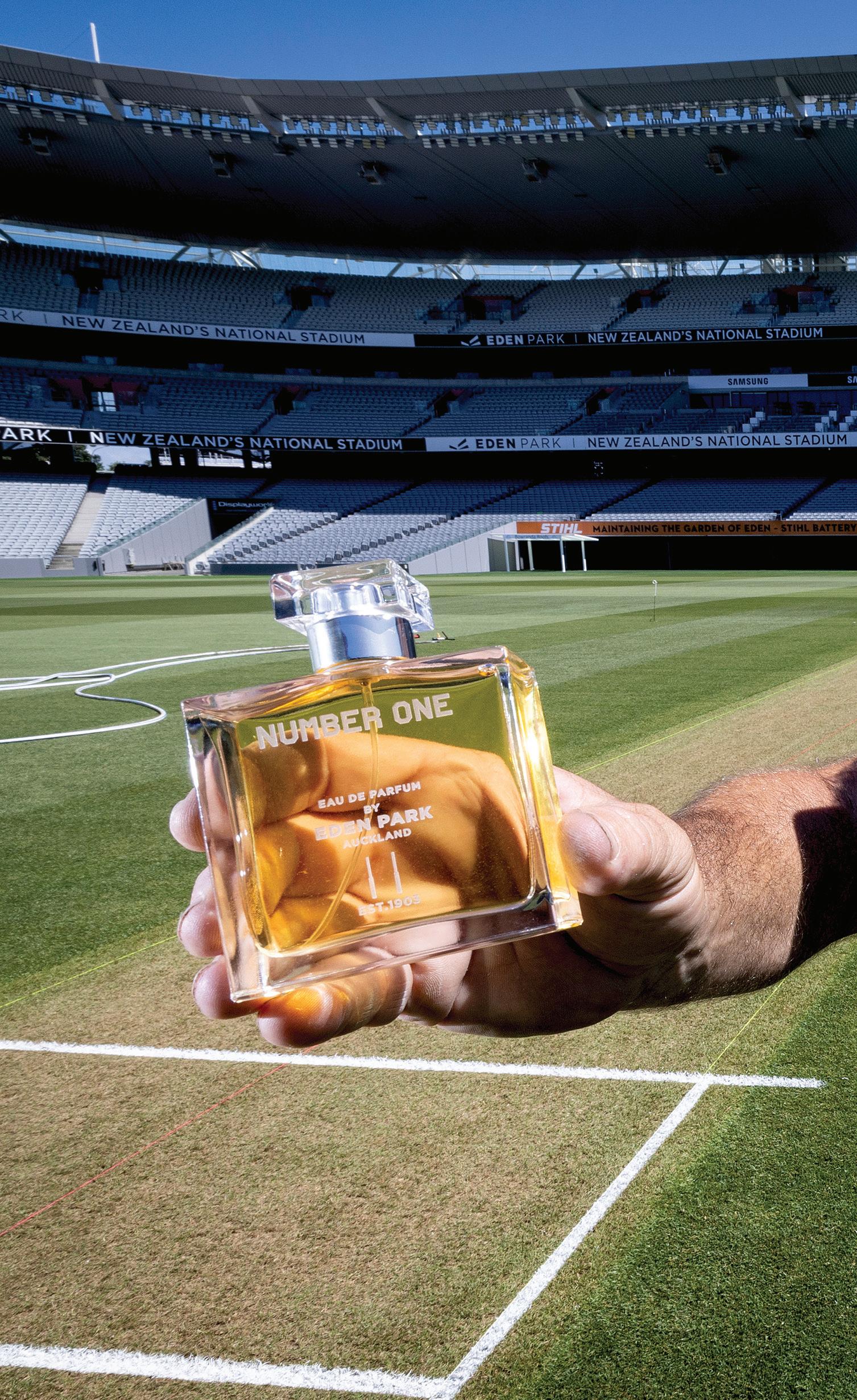
part of that he also assisted the Asian Cricket Council in a training capacity, journeying to flung places such as Kuwait, Bhutan and Nepal to educate curators on the art of wicket management. In 2006 he rejoined Eden Park as assistant to then head groundsman Mark Perham before taking over New Zealand’s most coveted turf role in October 2013.
It is an impressive CV that Christiansen has notched up over more than two decades, but after his more recent exploits he can add another unique skillset to that resume.
A NEW ‘SCENTSATION’
Shortly before last Christmas, Eden Park released its ‘Stadium Collection’, two specially designed fragrances which complement the venue’s range of regular branded merchandise. Retailing for $NZD170 a bottle, there are two fragrances in the collection –‘Number One’ and ‘Garden of Eden’ – which were the end result of a fragrance workshop that Eden Park staff were a part of last August. The development of a bespoke fragrance was the brainchild of Eden Park chief executive
70 AUSTRALIAN TURFGRASS MANAGEMENT 26.2 UP THE LAST...
PHOTO: JASON OXENHAM
Eden Park turf manager Blair Christiansen has handcrafted his own fragrance, called Number One, which the venue released as part of its bespoke ‘Stadium Collection’ in the lead-up to last Christmas

Nick Sautner. An ex-pat Aussie, Sautner is a former highly decorated VFL player who won the Jim ‘Frosty’ Miller Medal as the league’s leading goalkicker a record nine times throughout the 2000s. Sautner has been Eden Park head for the past six-and-a-half years and has developed a reputation for thinking outside the box when it comes to marketing ‘New Zealand’s national stadium’.
In the midst of hosting matches during last year’s FIFA Women’s World Cup, Eden Park seconded the services of Miller Road
Fragrances, a local boutique company that manufactures fragrances and runs workshops on how to make them. Setting up in the Eden Park changerooms, which are more accustomed to the pungent odours of liniment and sweat, around 30 staff, including Christiansen and his team, attended a day-long Miller Road workshop. It was an opportunity for staff to come together and celebrate the success and history of the venue and create a fragrance that reflected what Eden Park meant to them.
From the workshop, two fragrances were chosen for appraisal by perfume experts at Smith & Caughey’s, New Zealand’s equivalent of Myer and David Jones. Impressed with their quality and commercial potential, they proceeded to be manufactured and were released in the lead-up to Christmas. One of those chosen was Christiansen’s creation –‘Number One’ – which had the honour of being the first release of the collection. The second –‘Garden of Eden’ – was crafted by Eden Park’s commercial manager Duncan Blomfield.
MARCH-APRIL 2024 71

“It was really interesting to be part of and to think that my fragrance was one of those chosen is pretty cool,” reflects Christiansen. “As part of the workshop we learned about what goes into making a fragrance and how they are structured. There’s about nine steps and you start building it up in layers from the ‘base’ and finish off with the ‘top note’.
“Along the way you introduce different essences that you think might work or have some relevance to you, then it’s all about getting the mix and layering right. As you go you stop and assess it – does it need anything more, is there too much of something, does it need to be softened, does it wear too quick? There is a real science to it and it’s a lot harder than managing a cricket wicket!”
So what does ‘Number One’ smell like? Well, here’s an excerpt from the marketing notes which accompanied the Stadium Collection release:
“Proudly crafted inside the home changing room at our iconic venue and inspired by over 120 years of history, our exclusive fragrances Number One and Garden of Eden capture the essence of Eden Park’s rich legacy… From the nose of our Turf Manager, Number One is Eden Park’s freshly mown turf on a crisp, dewy morning in a bottle. A blend of gourmande, amber floral, tobacco, peach, vanilla, cassis (blackcurrant) and cut grass, with contrasting base notes of ambroxan, white oak, lime zest, frankincense, ambergris, white musk, amber and mushroom, Eden Park Number One embodies the memorable moments on our hallowed turf.” Old Spice it definitely isn’t!
MAN ABOUT TOWN
While developing ‘Number One’ was quite the eye-opener, Christiansen wasn’t quite prepared for the aftermath. As with any new product release there is a marketing campaign and once the first bottles had rolled off the Miller Road production line, the Eden Park corporate team swung into action. A photoshoot was
quickly organised, with Christiansen snapped sitting on the venue’s Toro Reelmaster, arms resting on the steering wheel while holding a bottle of ‘Number One’ and staring directly down the camera lens.
“It was my ‘Blue Steel’ moment,” jokes Christiansen, referring to the famous pose struck by Ben Stiller’s character in the movie Zoolander. “They came down and took some photos and there was no real indication of where they might end up.”
Sure enough, in the weeks leading up to Christmas and over the New Year period, Christiansen’s face would, to his surprise, became a familiar sight across Auckland. The marketing team orchestrated an extensive billboard campaign featuring Christiansen’s face front and centre (see photos above) promoting the new fragrances. The billboards, some of which were nearly two storeys high, adorned the sides of buildings in the Auckland CBD, while across the inner city suburbs you could see Christiansen gazing down at you from shop rooftops and railway bridges.
It isn’t the first time that Christiansen has become something of a ‘brand ambassador’. Among the many corporate partners that Eden Park has in its stable are Stihl and Wet & Forget. During COVID, Christiansen appeared
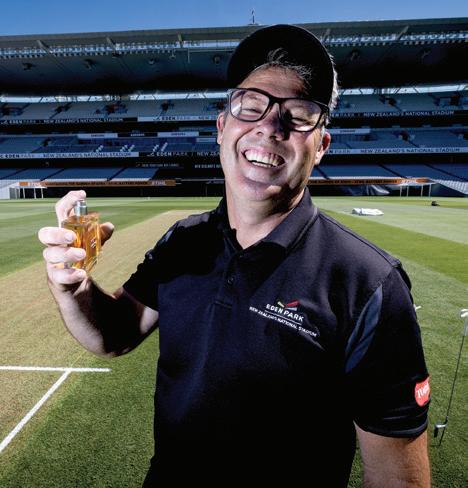
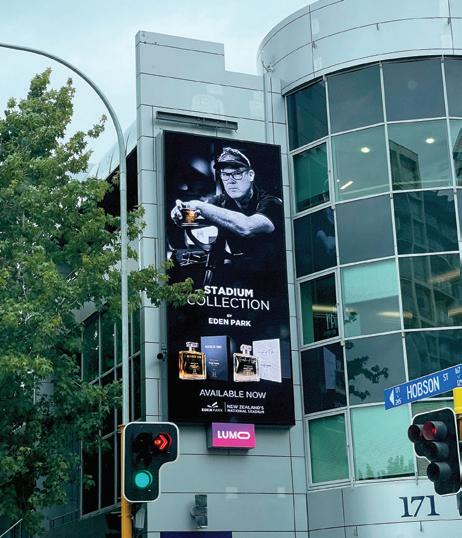
in a series of YouTube videos promoting Stihl’s range of garden care equipment, while he has also appeared in ads for Wet & Forget, a household mould/gunge remover which is used to clean the stadium’s seats.
“All those came about through just making myself available and giving it a go,” states Christiansen. “With the Stihl ads, they were about helping out one of our partners who because of COVID weren’t getting the same exposure they would normally as we couldn’t host any games at the stadium. We talked about how we could provide some value for them and one way of doing that was helping out with those ads.
“Instead of saying ‘no’, people should say ‘yes’ more often and see where it goes. When you say ‘yes’, nine times out of 10 it works out. If you say ‘no’ all the time you become a bit of an obstacle. In saying that, I don’t say ‘yes’ to everything – I consider everything and if I know it’s going to work or if I can make it work then I’m happy to do it.”
Following the collection’s launch and appearance of the billboards, word spread pretty quickly throughout the NZ turf industry about Christiansen’s newfound fame. Suffice to say some so-called ‘mates’ were quick to give him a spray (pun intended) and provide some constructive feedback – “Does it make you smell like grass?”
Some friendly ribbing aside, the new fragrance has certainly won a few admirers and although not contractually obliged to wear it, Christiansen admits he happily administers a few liberal sprays prior to jumping in the work ute for the daily commute to the stadium. “It’s a hit on the home front,” says Christiansen. “The wife loves it and my son Ben, who is 17, even wears it as well. I should have a stand at this year’s turf conference and bring some over to sell!”
“From
72 AUSTRALIAN TURFGRASS MANAGEMENT 26.2 UP THE LAST...
the nose of our Turf Manager, Number One is Eden Park’s freshly mown turf on a crisp, dewy morning in a bottle...”
Christiansen’s ‘Blue Steel’ moment (above) during the ‘Number One’ photoshoot which was used prominently in a billboard marketing campaign across Auckland (right)
PHOTO: JASON OXENHAM
Apply POSTERITY ® and BARRICADE® in the same tank mix and enjoy the rewards on and off the fairways.

An application of POSTERITY® in the late summer/early autumn can provide preventative control of Spring Dead Spot (SDS) with a second application after 28 days.
By mixing BARRICADE® Herbicide in either application you can get ahead of winter weeds at the same time as preventing SDS getting into your fairways.
Clean up your fairways with POSTERITY® and BARRICADE® this autumn.
Syngenta Australia Pty Ltd, Level 1, 2 Lyonpark Road, Macquarie Park NSW 2113. ABN 33 002 933 717. ®Registered trademark of a Syngenta Group Company. ™Trademark of a Syngenta Group Company. 2024 Syngenta. AD 24-016


































































 Brett Robinson, Editor
Brett Robinson, Editor

















































































































































































